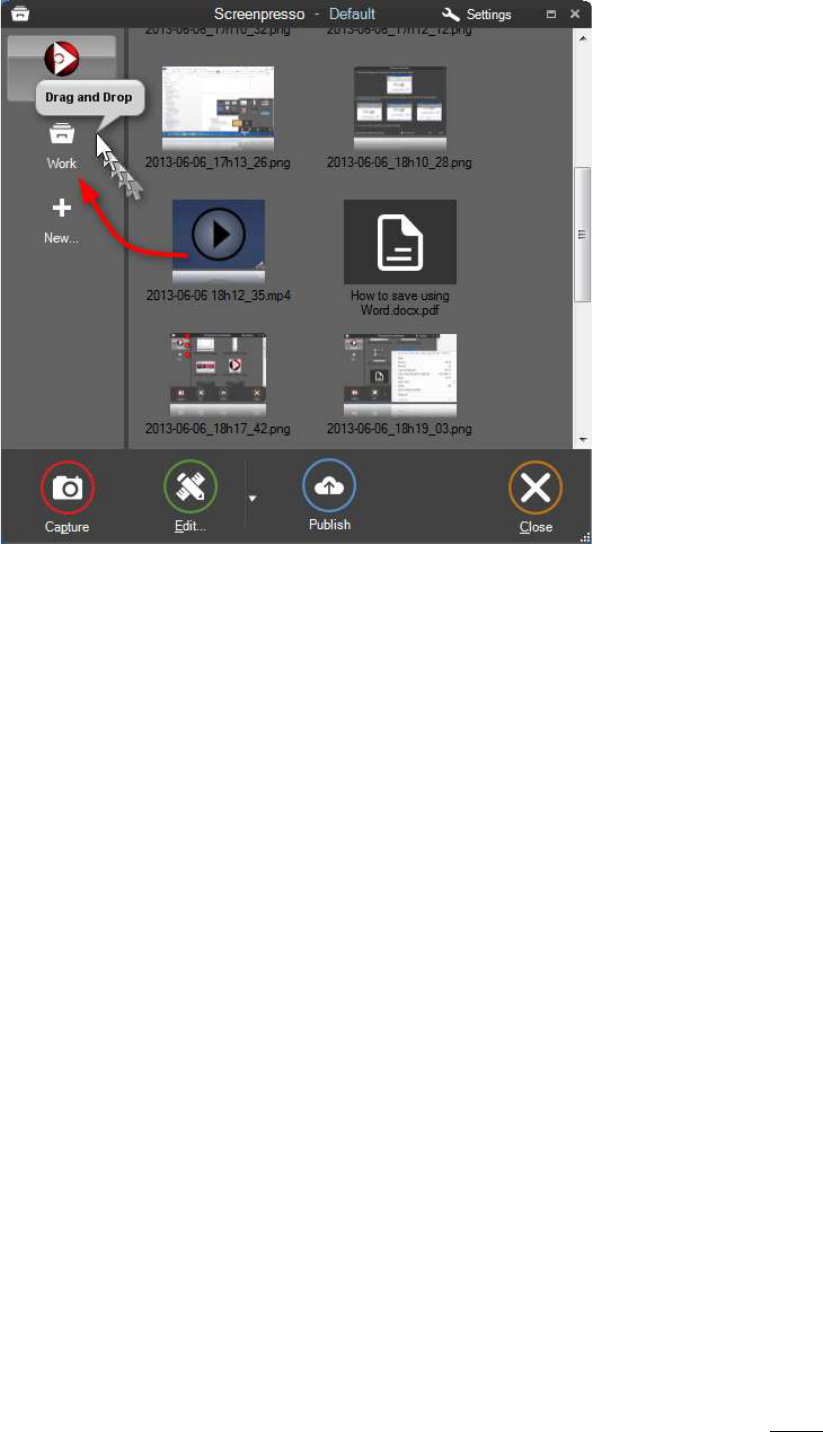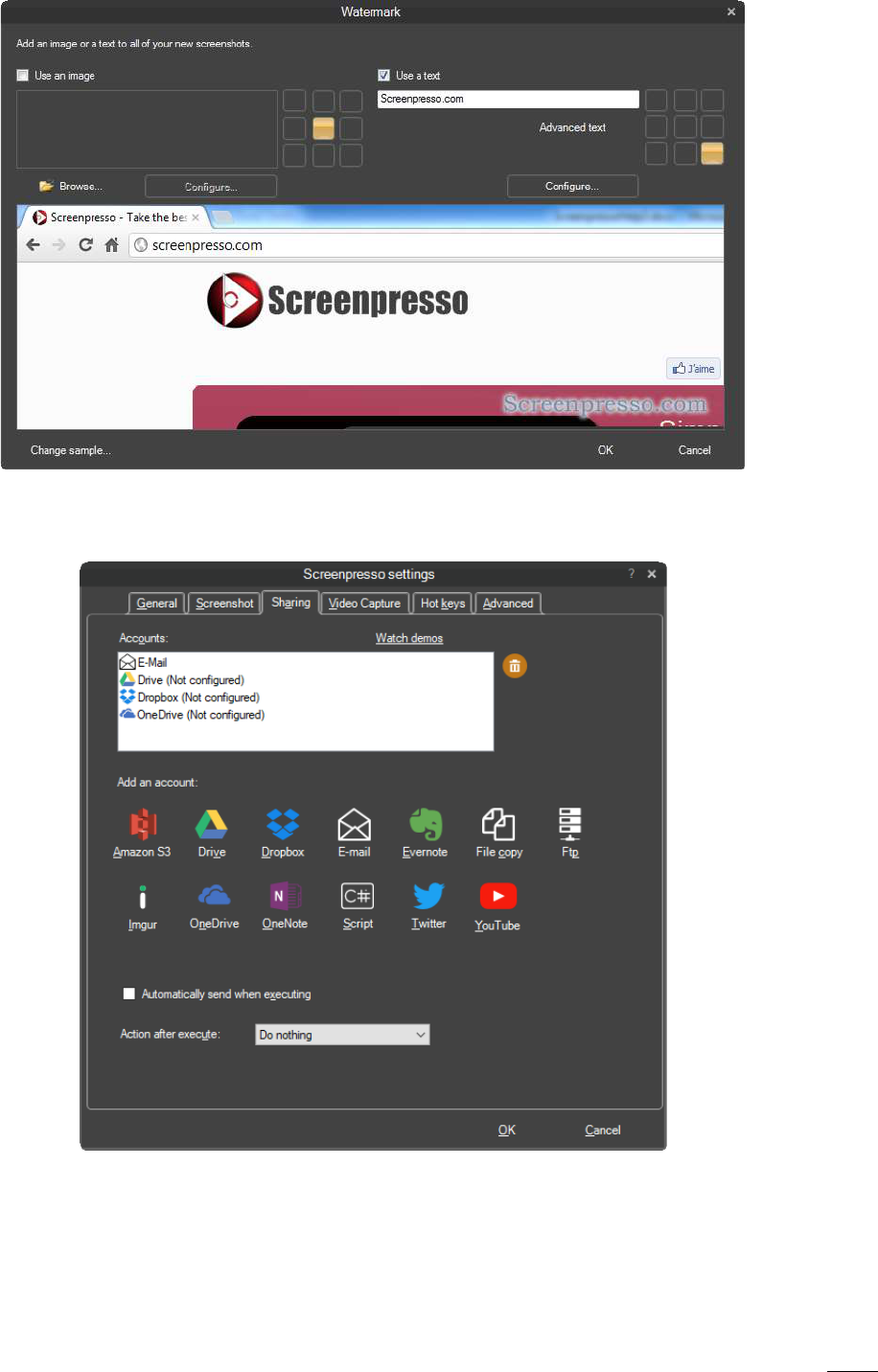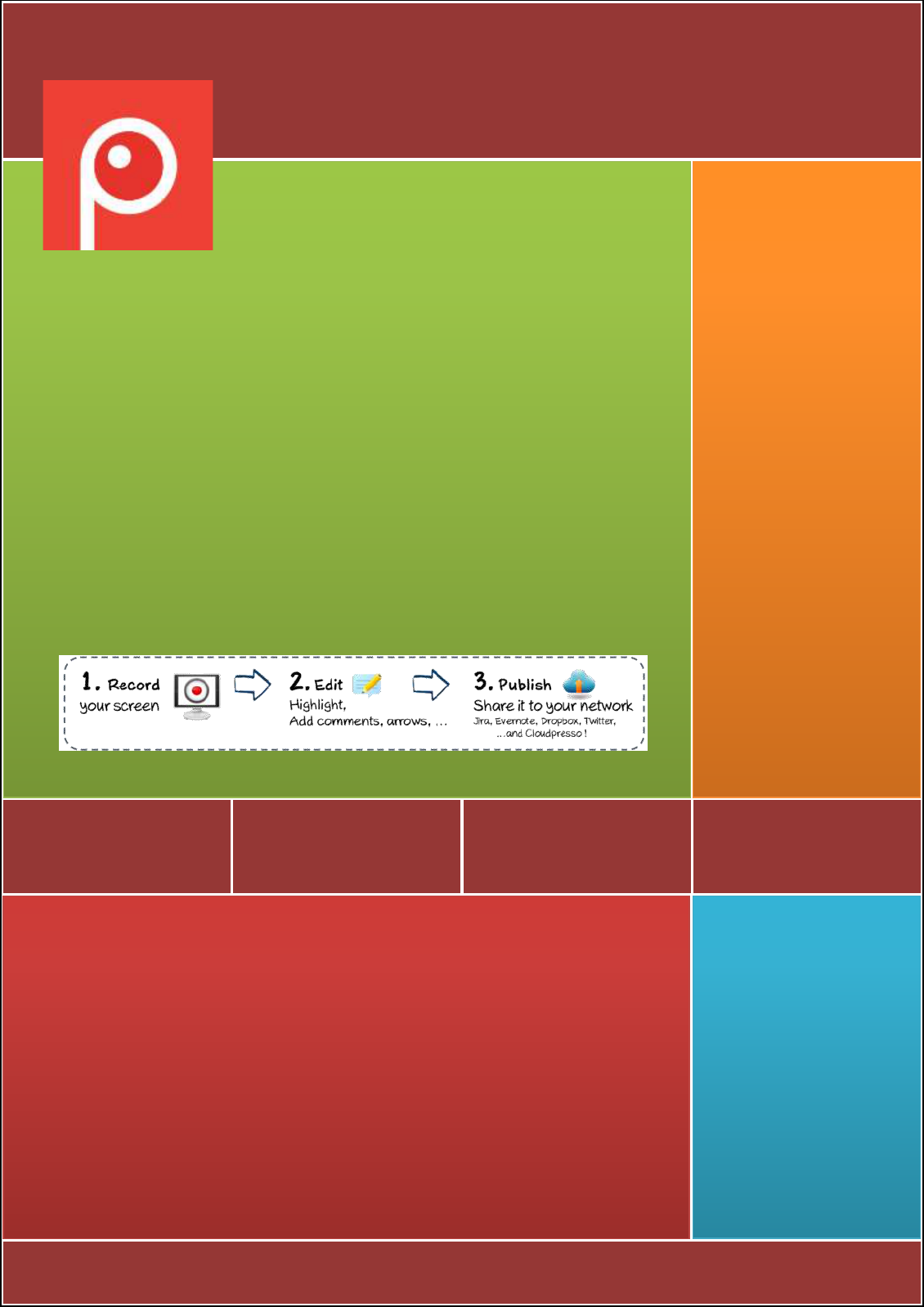
ailImgurenregistrerolicif
S c r e e n p r e s s o i s e d i t e d b y L E A R N P U L S E S A S
2024
Screenpresso User
Manual
Screenpresso captures your screen (screenshots and HD videos screencasts) for your
training documents, collaborative design work, IT bug reports, and more... It is a light-
weight Windows screen grab tool with built-in image editor and publishing options.

Screenpresso User Manual
Chapter
: About this document
1
1 About this document
The purpose of this document is to list and describe all the features available in the tool, Screenpresso. This is
the official user manual edited by LEARNPULSE.
Latest version of this document is available at https://www.screenpresso.com/docs/ScreenpressoHelp.pdf
This document is also available directly in Screenpresso by pressing the key. By default, the online help is
opened. However, if the PDF file is present locally in the same folder as Screenpresso.exe, the local file is used.
You can also find additional information online: https://www.screenpresso.com/support/
You may also find some video tutorials on YouTube:
https://www.youtube.com/results?search_query=screenpresso
If you have any questions, remarks or if you need further information, feel free to contact the support team by
e-mail: contact@screenpresso.com

Screenpresso User Manual
Chapter
: Table of content
2
2 Table of content
1 About this document ....................................................................................................................... 1
2 Table of content .............................................................................................................................. 2
3 Minimum system requirements ...................................................................................................... 5
4 Installation and updates .................................................................................................................. 5
4.1 Where to download the latest version.................................................................................... 5
4.2 Installation modes ................................................................................................................... 5
4.3 Default Installation .................................................................................................................. 6
4.4 Installation in Program Files .................................................................................................... 7
4.5 Installation using the command line (advanced user only) .................................................... 7
4.6 Uninstall ................................................................................................................................... 8
4.7 Portable mode ......................................................................................................................... 9
4.8 Updates / new releases ........................................................................................................... 9
4.8.1 Official versions ............................................................................................................... 9
4.8.2 Intermediate versions ................................................................................................... 10
4.8.3 Check for update ........................................................................................................... 10
4.9 Enterprise deployment .......................................................................................................... 11
4.9.1 Deploy the activation key .............................................................................................. 11
4.9.2 Deploy the binaries (and all the files) ............................................................................ 11
4.9.3 Policies and default settings (PRO) ................................................................................ 13
5 How to activate PRO version ......................................................................................................... 14
5.1 Activation............................................................................................................................... 14
5.2 License retrieval .................................................................................................................... 15
6 Main concepts of Screenpresso .................................................................................................... 15
6.1 Always available .................................................................................................................... 15
6.2 No need to bother with file location ..................................................................................... 15
6.3 Workspace for all your captures ........................................................................................... 16
6.4 Default file format ................................................................................................................. 17
6.5 Simple shortcuts .................................................................................................................... 17
6.5.1 Main shortcuts to know: ............................................................................................... 17
6.5.2 Other shortcuts ............................................................................................................. 18
7 Capture an image .......................................................................................................................... 19

Screenpresso User Manual
Chapter
: Table of content
3
7.1 All in one capture mode ........................................................................................................ 19
7.2 Screenshot full screen ........................................................................................................... 22
7.3 Screenshot previous region ................................................................................................... 23
7.4 Screenshot scrolling windows ............................................................................................... 24
7.4.1 Capture of a Web page .................................................................................................. 25
7.4.2 Automatic auto scroll capture ....................................................................................... 25
7.4.3 Manual auto scroll capture ........................................................................................... 25
7.5 Capture workflow .................................................................................................................. 27
7.6 Color picker (PRO) ................................................................................................................. 29
7.7 Screenshot text (PRO) ........................................................................................................... 29
7.8 Capture a QR code (PRO) ...................................................................................................... 31
8 Capture a video ............................................................................................................................. 31
8.1 Overview ................................................................................................................................ 31
8.2 Video Toolbar ........................................................................................................................ 33
8.3 Sound recording .................................................................................................................... 34
8.4 Webcam................................................................................................................................. 34
8.5 Video zoom ............................................................................................................................ 36
8.6 Start recording ....................................................................................................................... 36
8.7 Video capture workflow ........................................................................................................ 37
8.8 Screenpresso media player ................................................................................................... 38
8.9 Convert video to another format .......................................................................................... 40
8.10 Recording limitation .............................................................................................................. 40
8.11 Merging videos (PRO) ............................................................................................................ 41
9 Android center ............................................................................................................................... 41
9.1 Install ADB ............................................................................................................................. 42
9.2 Configure your device ........................................................................................................... 42
9.3 Take captures ........................................................................................................................ 43
10 Workspace window ................................................................................................................... 43
10.1 Overview ................................................................................................................................ 43
10.2 Filter ....................................................................................................................................... 45
10.3 Drag & Drop ........................................................................................................................... 45
10.4 Auto clean-up of files ............................................................................................................ 45
10.5 Workspaces management ..................................................................................................... 46
10.6 Collaborative work ................................................................................................................ 47

Screenpresso User Manual
Chapter
: Table of content
4
10.6.1 Synchronization with Dropbox, Google Drive or Microsoft OneDrive .......................... 47
11 Managing files ........................................................................................................................... 49
11.1 File management ................................................................................................................... 49
11.1.1 Deleting a media ............................................................................................................ 51
11.1.2 Renaming a media ......................................................................................................... 51
11.1.3 Moving a media to another workspace......................................................................... 51
11.1.4 Sorting ........................................................................................................................... 52
12 Editing an image ........................................................................................................................ 53
12.1 Main tab ................................................................................................................................ 53
12.2 Using the drawing tools ......................................................................................................... 56
12.3 Change main image (PRO) ..................................................................................................... 67
12.4 Hidden features ..................................................................................................................... 67
12.5 Third party editors ................................................................................................................. 68
12.6 Edit other images .................................................................................................................. 68
13 Editing a video ........................................................................................................................... 68
13.1 Built-in editor......................................................................................................................... 68
13.2 Third party editors ................................................................................................................. 69
14 Document generator ................................................................................................................. 69
14.1 General use ............................................................................................................................ 69
14.2 Generator settings ................................................................................................................. 73
15 Publishing files ........................................................................................................................... 74
15.1 Local publishing ..................................................................................................................... 74
15.2 Web and cloud sharing .......................................................................................................... 74
15.2.1 Get a public URL thanks to Screenpresso Cloud............................................................ 75
15.2.2 Sharing history ............................................................................................................... 77
16 Settings ...................................................................................................................................... 78
16.1 General .................................................................................................................................. 78
16.2 Screenshot ............................................................................................................................. 78
16.3 Sharing ................................................................................................................................... 80
16.4 Video capture ........................................................................................................................ 80
16.5 Advanced configuration ........................................................................................................ 81
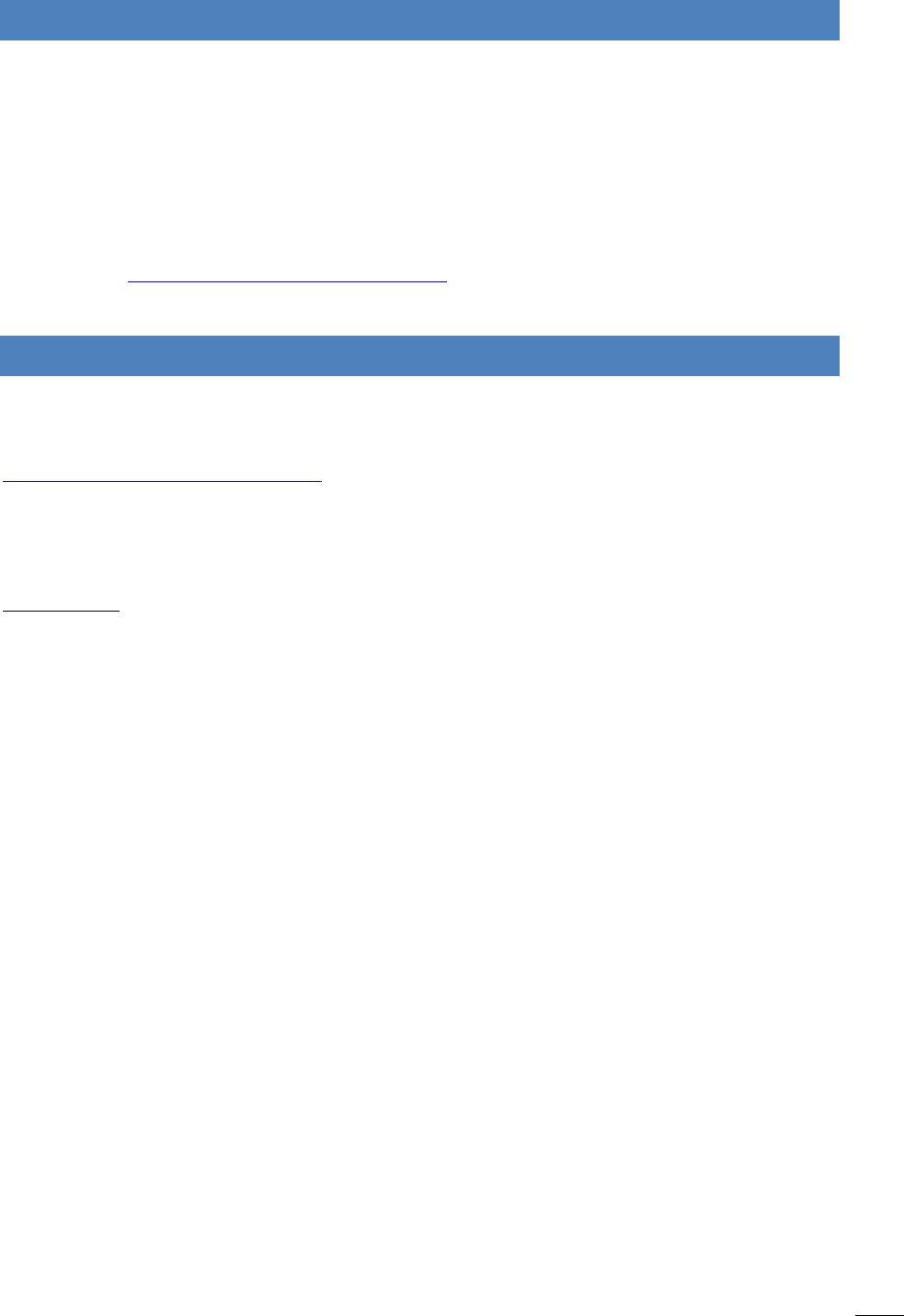
Screenpresso User Manual
Chapter
: Minimum system requirements
5
3 Minimum system requirements
The minimum system requirements are:
• Microsoft Windows 10 64-bit
• 2.0 GHz processor
• 4 GB of RAM
• 1 GB of free hard disk space
Screenpresso.exe requires both Microsoft .NET Framework 4.8 installed on your computer. You may find links
on our web site: https://www.screenpresso.com/download.
4 Installation and updates
4.1 Where to download the latest version
The latest official version of Screenpresso can be downloaded from our website at this address:
https://www.screenpresso.com/download
The FREE version and the PRO version are using the same binary (Screenpresso.exe). A license key is required
to switch FREE to PRO version.
Important note
Some intermediate releases (beta versions) are also available with some new features and fixes. You can get
them once you have installed Screenpresso by using the Check for update button in the tool itself.
Release notes are available only for official releases.
4.2 Installation modes
Screenpresso can be used in 4 modes:
- Installed mode: Screenpresso is installed on your computer. It doesn’t require administrator privileges
so it can be installed even if you are not the administrator of the computer. This is the recommended
mode since Screenpresso consumes less memory.
- Installed in program files mode: Screenpresso is installed on your computer. It requires administrator
privileges.
- Direct mode: you don’t need to install anything. Run Screenpresso.exe and it will just work.
- Portable mode: you don’t need to install anything. This mode is automatic when Screenpresso.exe is
run from a USB key or with “--portablemode” command line argument. In this mode all files are saved
next to the exe.
All modes are available via the same binary: Screenpresso.exe
Double-click on Screenpresso.exe to run Screenpresso.
The very first screen allows you to install Screenpresso or run it has it. You can also change the default
language if necessary. This window is not displayed anymore when Screenpresso is installed on the computer
and you run Screenpresso.exe again.
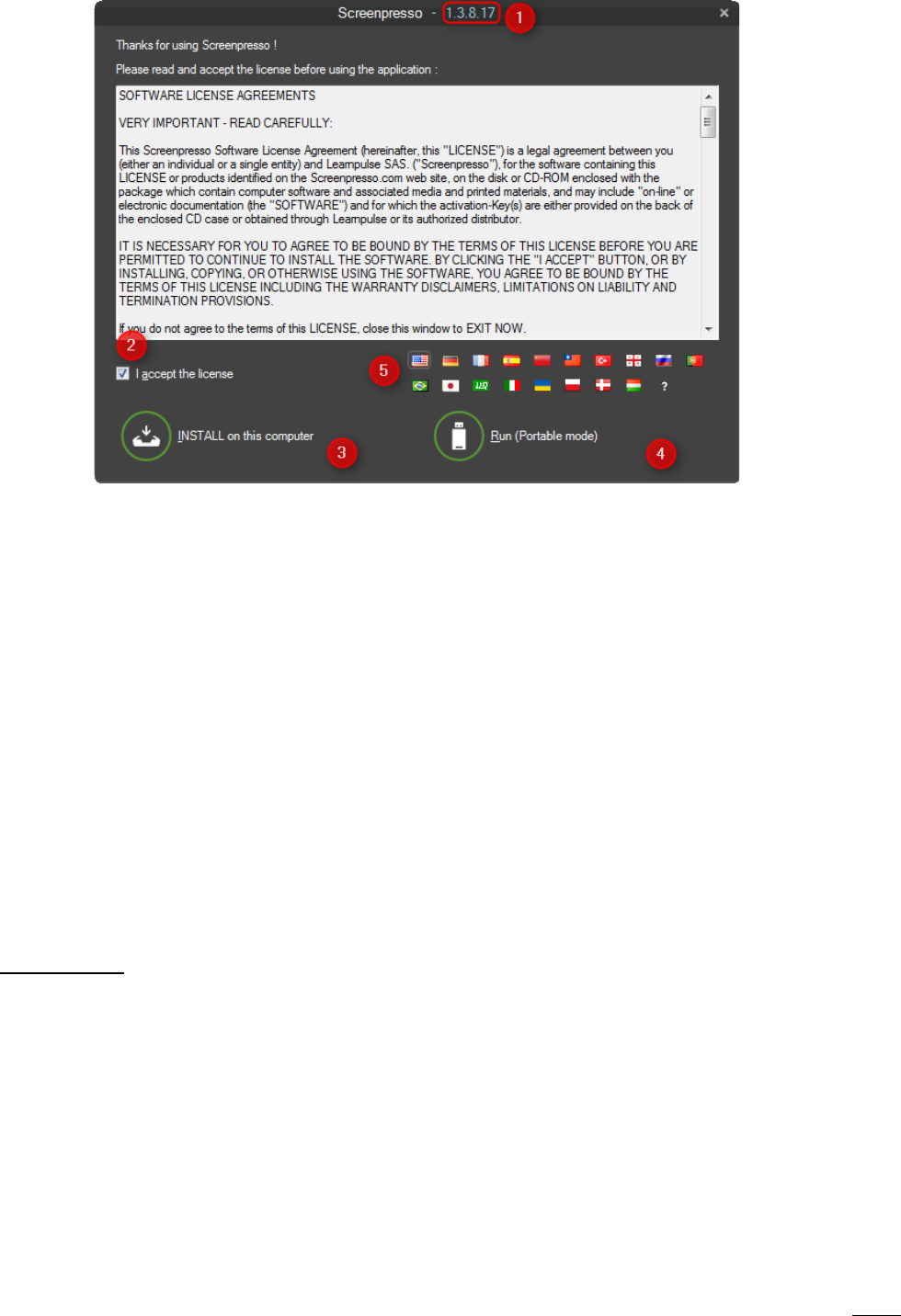
Screenpresso User Manual
Chapter
: Installation and updates
6
Figure 1 : Startup screen
1) This is the version of the running Screenpresso
2) Tick the checkbox if you accept the license
3) Run the installation mode
4) Run the portable mode
5) Change display language
4.3 Default Installation
When you click on the button “INSTALL on this computer”, the install setup is run in silent mode (no manual
input is required). Screenpresso:
- Installs the program in the user profile folder. Basically, it is:
C:\Users\<your login>\AppData\Local\LearnPulse\Screenpresso;
- Create a shortcut in the Windows’ start programs;
- Setup Screenpresso to run on Windows startup (you can change this option later in the Screenpresso
settings window);
- Run Screenpresso at the end of the setup.
Important notes
- Screenpresso does not require administrator privileges
- As Screenpresso.exe is both an executable program and a setup program (it copies itself in a new
folder), some antivirus software might display some warning messages and prevent Screenpresso
from installing properly. If an alert occurs, please temporarily shut down your antivirus software
during the installation process
- Using this installation procedure, Screenpresso is only available for the current Windows user
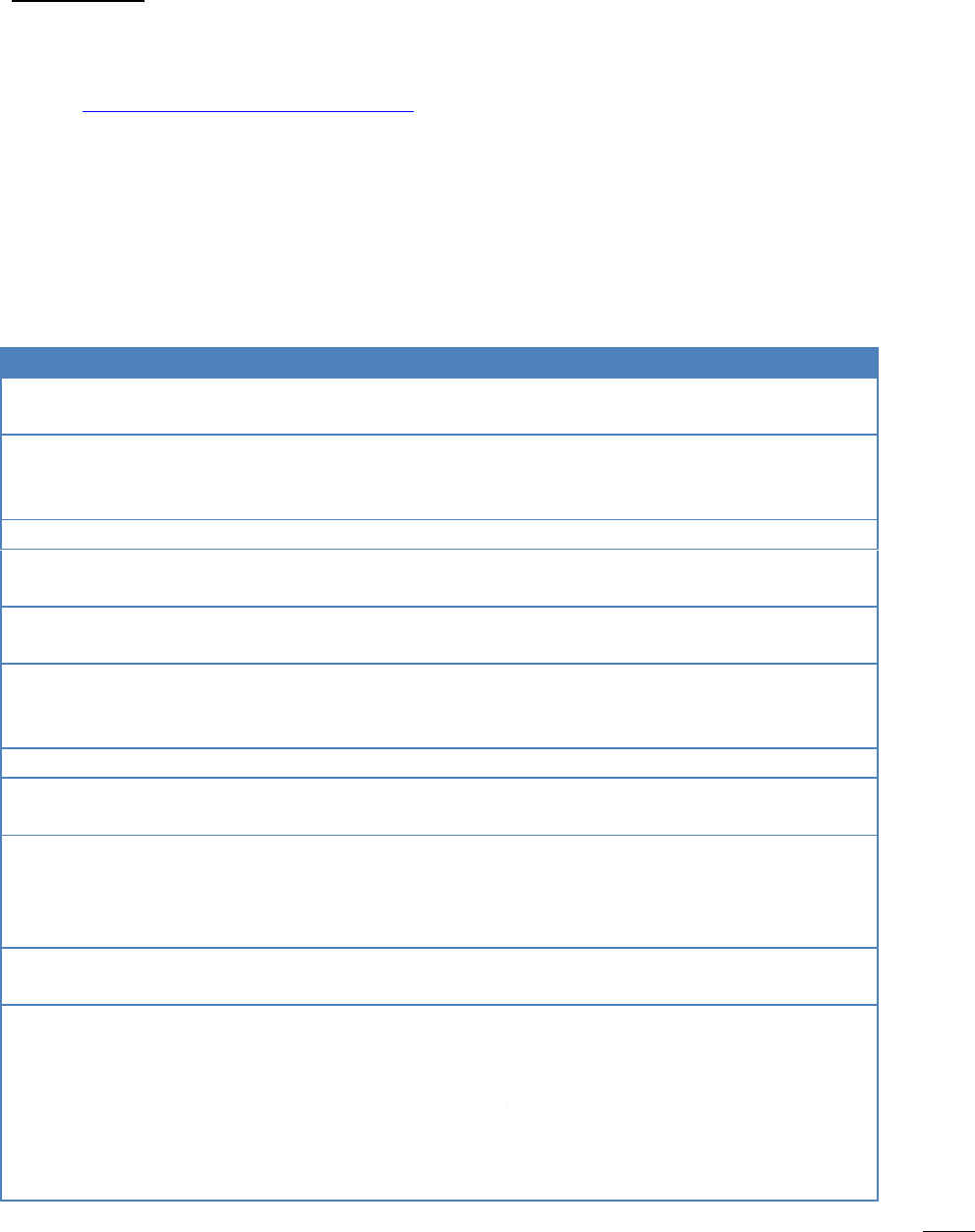
Screenpresso User Manual
Chapter
: Installation and updates
7
4.4 Installation in Program Files
If you want to install Screenpresso in the Windows’ Program Files folder, you need administrator privileges.
If you have these privileges, run Screenpresso.exe then click on the « INSTALL on this computer » button while
holding the Control key.
Important notes
- Administrator privileges will also be required later for automatic updates and uninstall
- When Screenpresso is installed in Program Files, it is then available to all users of the computer
- IT team can find some additional information about deployment online:
https://www.screenpresso.com/support/
4.5 Installation using the command line (advanced user only)
Advanced installation options are available by using the command line. Type « Screenpresso.exe --help » in a
Windows command prompt to get all information.
Those options can be used to deploy Screenpresso in silent mode or using Microsoft SMS (Systems
Management Server).
Command line arguments
Description
deploy --install
Install Screenpresso in user's profile folder
(C:\Users\<login>\AppData\Local\LearnPulse\Screenpresso).
deploy --install --programfiles
Install Screenpresso in Program Files folder
(C:\Program Files\Learnpulse\Screenpresso)
(Administrator privileges are required).
deploy --uninstall
Uninstall Screenpresso from user's profile folder.
deploy --uninstall --programfiles
Uninstall Screenpresso from Program Files folder
(Administrator privileges are required).
--quiet
Keyword used to install or uninstall silently without any
windows. A log file is generated next to the exe file.
--nofirsttimemessages
Indicates whether all tips and tricks messages must not be
displayed. This is useful for users having their settings.xml file
deleted at every reboot.
license --reset
Remove current license key (Screenpresso PRO).
--portablemode
Force Screenpresso to be executed in Portable mode (it will
store all data next to the executable).
deploy --policies
Dump “ScreenpressoPolicies.admx”,
“ScreenpressoPolicies.aml” and “ScreenpressoPolicies.reg” files
on desktop to be used by administrators.
Details are given in 4.9.3.
license –activate […]
Immediately activate Screenpresso PRO for one user. Activation
key must be given via next command line parameter.
capture --ScreenshotRegion –filepath
c:\output.png –rect 0;0;800;600
Branding is added when used in the
FREE version.
Capture a screenshot at the specific coordinates (optional) and
save it to the given file path (optional).
Rect (optional): Coordinates of the rectangular region of the
screen to capture: X;Y;Width;Height, for instance: 0;0;640;480
Use -1 for full screen: -1;-1;-1;-1
When the coordinates are not present, the user will be
prompted to select the region to capture using the mouse.
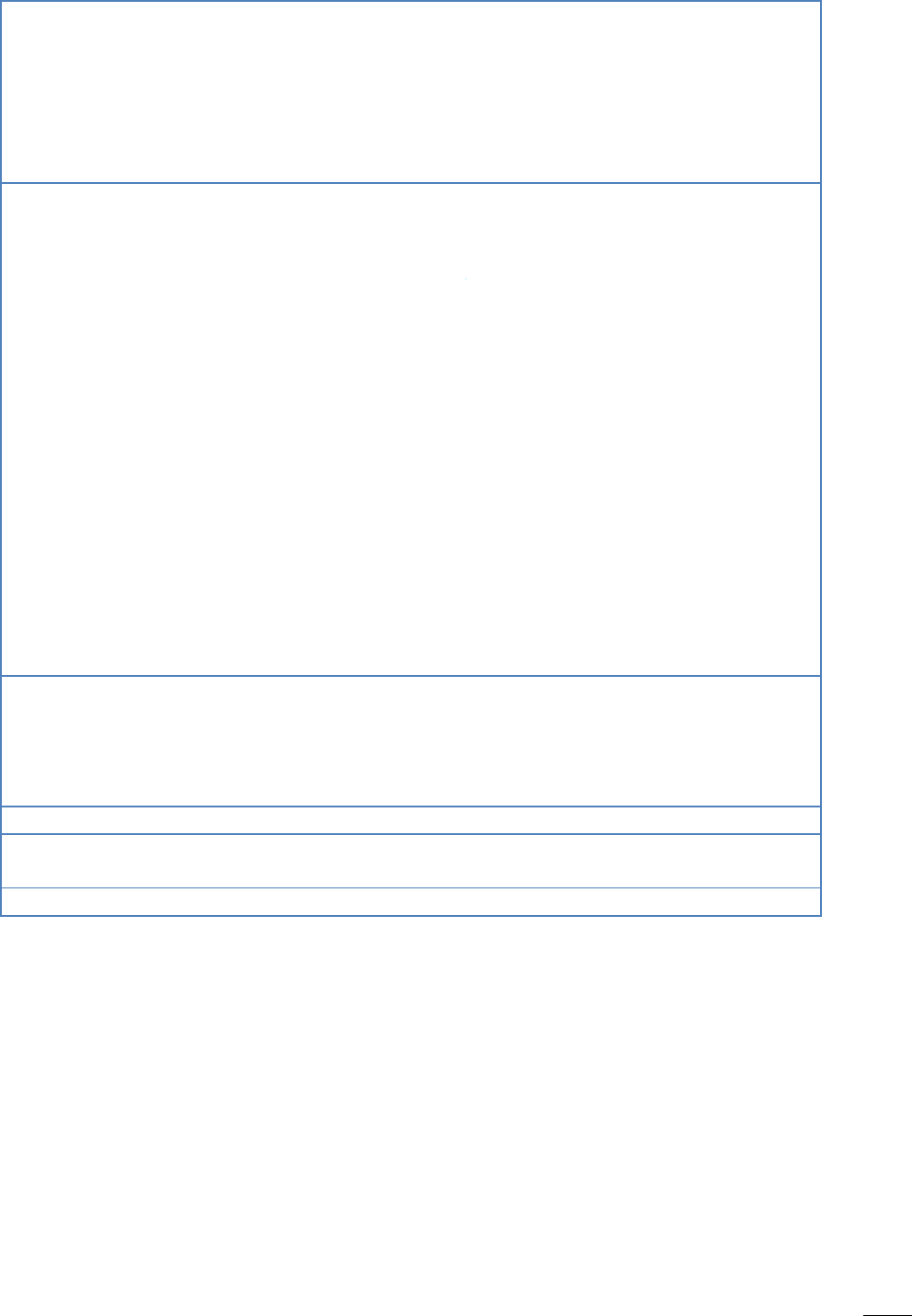
Screenpresso User Manual
Chapter
: Installation and updates
8
Filepath: the absolute filepath of the image.
Examples:
Screenpresso.exe capture –screenshotregion –rect 0;0;640;480
Screenpresso.exe capture --screenshotregion
screenpresso.exe capture --screenshotregion –filepath
"C:\Users\ME\Desktop\test2.png"
capture --videoregion –filepath
c:\output.mp4 –rect 0;0;800;600 --
delay 60
Branding is added when used in the
FREE version.
Capture a video at the specific coordinates (optional) and save
it using the given filepath (optional).
Rect (optional): Coordinates of the rectangular region of the
screen to capture (X;Y;Width;Height), for instance: 0;0;640;480
Use -1 for full screen: -1;-1;-1;-1
When the coordinates are not present, the user will be
prompted to select the region to capture using the mouse.
Filepath: the absolute file path of the image.
Delay: defines a maximum duration in minutes for the video
recording. Auto stop recording after a period of time.
Example:
Screenpresso.exe capture --videoregion 0;0;640;480 --
capturedelay 15
Examples:
Screenpresso.exe capture --video 0;0;640;480
screenpresso.exe capture --videoregion
"C:\Users\ME\Desktop\test2.png" 0;0;640;480
screenpresso.exe -capturevideoregion 0;0;640;480
"C:\Users\ME\Desktop\test3.png"
videos --merge
Only available in PRO version
Merge multiple video file having the same format to one video
file.
Example:
Screenpresso.exe videos --merge c:\temp\video1.mp4
c:\temp\video2.mp4
--newinstance
Start a new instance of Screenpresso and kill the previous one.
--multiinstances
Start a new instance of Screenpresso without checking if
another instance is already running. To be used with care.
--help
Display the help popup about the command line arguments.
Examples:
Screenpresso.exe deploy --install –programfiles --quiet
Screenpresso.exe license --activate [3]-[screenpressopro]-[1]-[…]-[…]-[…==]
4.6 Uninstall
Screenpresso can be uninstalled like any other software using Windows’ control panel.
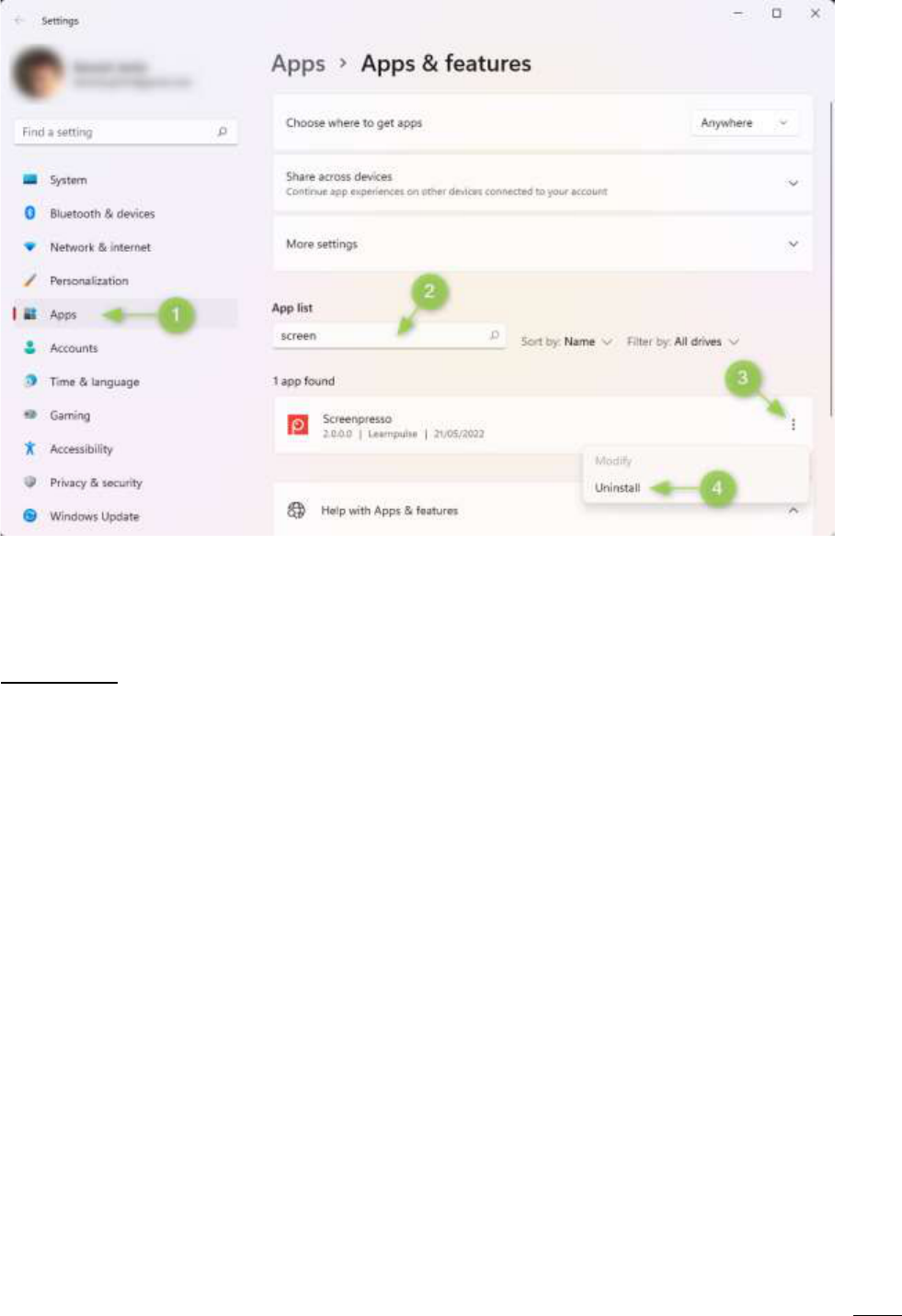
Screenpresso User Manual
Chapter
: Installation and updates
9
Figure 2 : Windows 11 Control Panel
It is also possible to uninstall Screenpresso by using the command line: “Screenpresso.exe deploy --uninstall”.
Refer to section 4.5.
Important note
- Administrator privileges are required to uninstall Screenpresso from Program files folder.
4.7 Portable mode
Screenpresso can also work without being installed. This is a great feature for people that only want to use it a
few times, try it, or run it from a USB key on several computers.
To start Screenpresso using the portable mode, run Screenpresso.exe and click on the “Run” button on the
startup screen.
Screenpresso detects if it is started from a USB flash drive. In this case, it runs as portable mode and no file is
generated on the computer. All files and screen captures will be stored in a folder next to the executable file.
Basically, this option allows you to go on some computers, take screen captures using Screenpresso from your
USB flash drive, then go back to your computers and find the captures on the USB flash drive.
4.8 Updates / new releases
Screenpresso is a tool that is continuously improved, so a lot of new versions are available throughout the year.
There are 2 kinds of new versions:
1) Official versions
2) Intermediate versions (beta)
4.8.1 Official versions
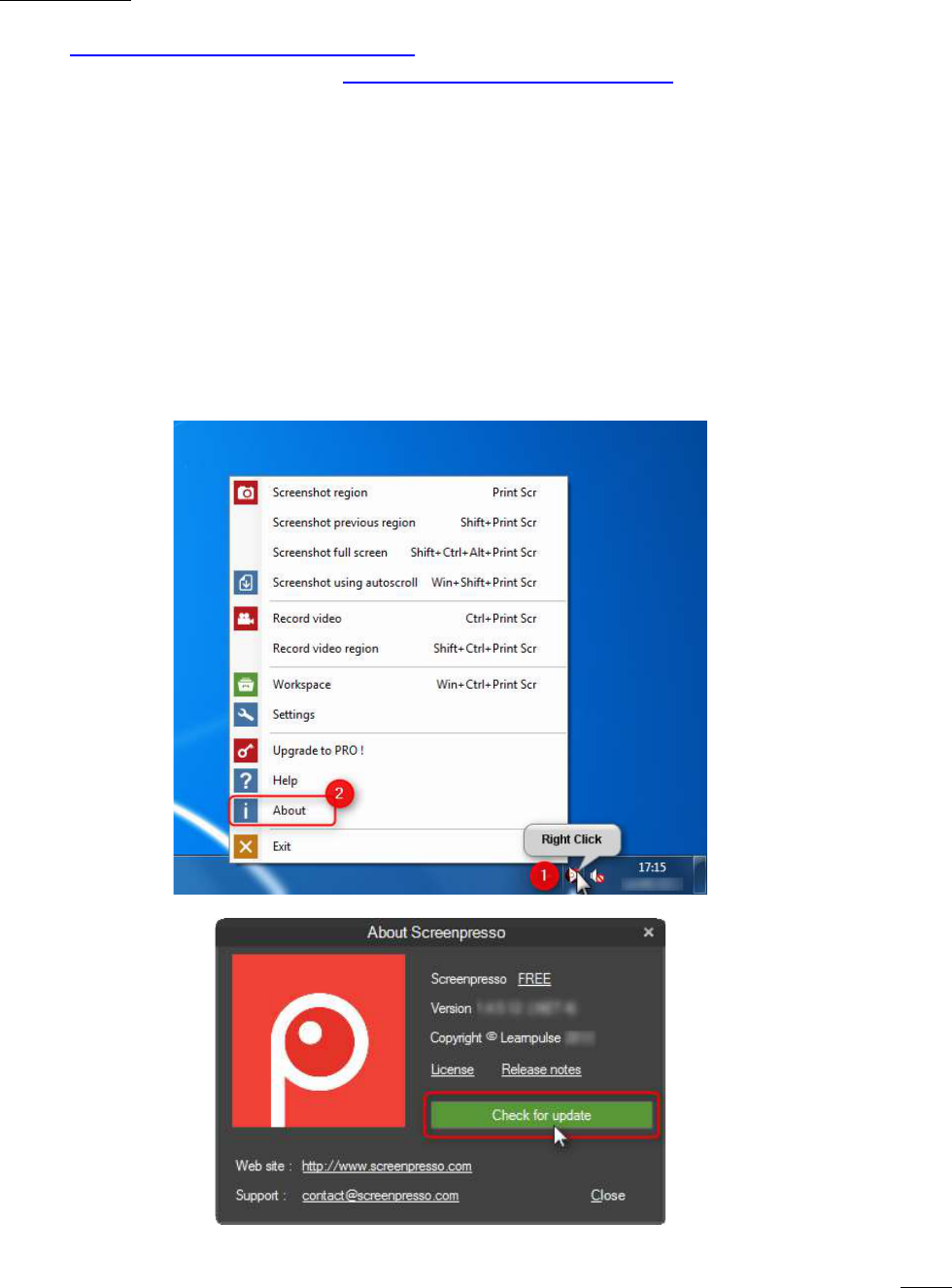
Screenpresso User Manual
Chapter
: Installation and updates
10
When a new official version is available and is ready for deployment, a popup is displayed at Screenpresso
startup in the next three weeks to ask you to update your current version of Screenpresso.
Important notes
- The latest official version is always available on our website at
https://www.screenpresso.com/download/
- The release note is available here: https://www.screenpresso.com/releases/
- All users are not updated at the same time, so a new version can be available on our website before
you receive the update prompt. Refer to section 4.8.3 to update manually
- Official updates are mandatory for the FREE version of Screenpresso; this is to avoid support of an old
version
4.8.2 Intermediate versions
Beta versions have intermediate releases between 2 official releases. Most of the time beta versions contain
fixes and new features. Refer to section 4.8.3 to update manually to a beta version.
4.8.3 Check for update
You can click on the “Check for update” button in the ‘About Box’ to verify if a new version is available if you
want to get it more rapidly.
Figure 3 : Systray context menu
Figure 4 : About Box
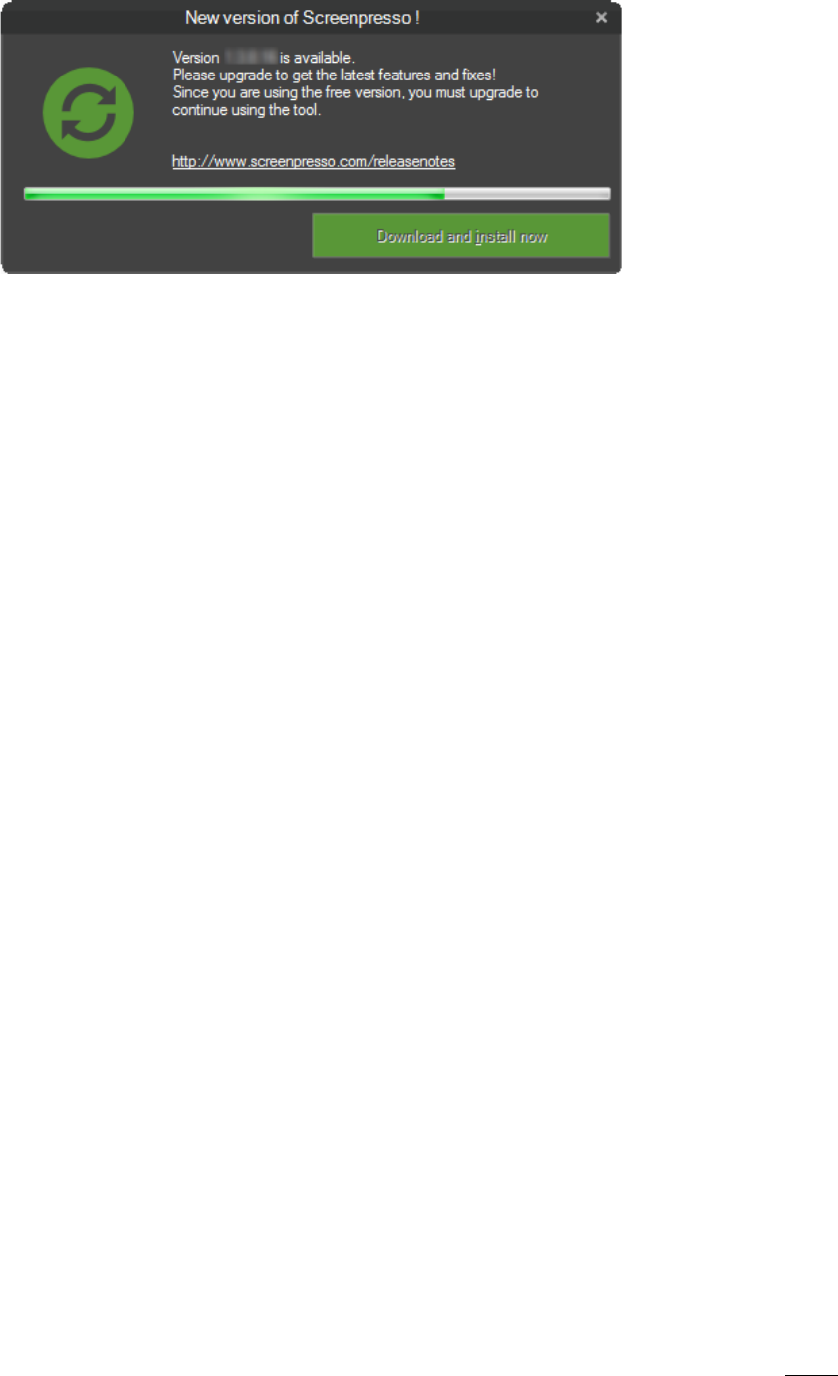
Screenpresso User Manual
Chapter
: Installation and updates
11
If there is a new version (official or beta), a prompt will be displayed:
Figure 5 : Automatic update
Download and installation are completely automatic.
4.9 Enterprise deployment
Screenpresso can be deployed using a batch file, for instance using Microsoft System Management Server
(SMS).
4.9.1 Deploy the activation key
When Screenpresso PRO is bought for several users, a single activation key (containing several licenses) is
provided by email. Unlike using a site license, using a per user license it is still possible to deploy the key but
each user will have to confirm activation.
To deploy the activation key, simply add a text file named "activation.lic" containing the activation key and
store it next to Screenpresso.exe on the target machine (where Screenpresso.exe is installed).
4.9.2 Deploy the binaries (and all the files)
The following files need to be deployed:
- Screenpresso.exe
- activation.lic (optional)
- settings.xml (optional)
- ffmpeg.exe and libvlc folder (optional)
- ScreenpressoHelp.pdf (optional)
Using “ScreenpressoSetup.msi” is recommended.
Here is a step-by-step procedure to achieve this:
1) On the target machine, deploy the following files in a temporary folder, for instance in c:\temp\:
• c:\temp\Screenpresso.exe
• c:\temp\activation.lic (optional)
• c:\temp\settings.xml (optional)
• c:\temp\ScreenpressoHelp.pdf (optional)
• c:\temp\FFmpeg\ (optional)
• c:\temp\Tesseract (optional)

Screenpresso User Manual
Chapter
: Installation and updates
12
2) Then run the command with administrator privileges to install Screenpresso into the program files
folder.
C:\temp\screenpresso.exe deploy --install –programfiles --quiet
This command will install Screenpresso and all the files defined in 1) in the folder
C:\Program Files\Learnpulse\Screenpresso
Refer to section 4.5 for command line details.
3) If not provided in step 1), you can deploy the license key manually (optional), refer to 4.9.1 for details:
- C:\Program Files\Learnpulse\Screenpresso\activation.lic
or C:\Program Files\Learnpulse\Screenpresso\settings.xml
4) If not provided in step 1) you can deploy default settings manually (optional):
C:\Program Files\Learnpulse\Screenpresso\settings.xml
5) If not provided in step 1) you can deploy user manual manually (optional):
C:\Program Files\Learnpulse\Screenpresso\ScreenpressoHelp.pdf
Important notes
- During testing, make sure you don’t already have a settings.xml file in
%AppData%\Learnpulse\Screenpresso or %LocalAppData%\Learnpulse\Screenpresso folders since it
will override the settings.xml file stored next to Screenpresso.exe.
- To define the Screenpresso directory where the screenshots and videos will be stored, you can modify
the key TempFolderScreenShots in “settings.xml” file and use environment variables such as:
o %Personal%
o %MyDocuments%
o %MyPictures%
o %Desktop%
o %DesktopDirectory%
o %ApplicationData%
o %CommonApplicationData%
o %LocalApplicationData%
o %ComputerName%
o %UserName%
o %UserDomain%
- Screenpresso’s “autostart with user login” is not controlled via settings.xml file but via Windows
registry instead. If you manually install Screenpresso and want it to autostart at user logon, add
Screenpresso to the registry with command line argument “-startup”. Do not add a shortcut to startup
menu’s startup folder.
- If you don’t want Screenpresso to auto-update itself (for instance because users don’t have admin
privileges), it is recommended to apply “NoUpdate’ policy (refer to next chapter).
- At runtime, if video is used, Screenpresso automatically downloads a video pack based on third party
software (FFmpeg and LibVLC). If not provided in step 1), you can download the Video Pack from our
Web site (https://www.screenpresso.com/binaries/ffmpeg64_20220608.zip) and store it next to
Screenpresso.exe; the path should be:
C:\Program Files\Learnpulse\Screenpresso\FFmpeg\
- At runtime, if OCR is used, Screenpresso automatically downloads third party software (Tesseract). If
not provided in step 1), you can download the tool from our Web site

Screenpresso User Manual
Chapter
: Installation and updates
13
(https://www.screenpresso.com/binaries/tesseract64_20220608.zip) and store the extracted folder
next to Screenpresso.exe; the path should be:
C:\Program Files\Learnpulse\Screenpresso\Tesseract
4.9.3 Policies and default settings (PRO)
PRO administrators can override some settings and disable some features using the Windows Registry. Refer to
section 4.5 for generating a sample registry file.
The values must be stored in HKEY_LOCAL_MACHINE\SOFTWARE\LearnPulse\Screenpresso\Policies
[HKEY_LOCAL_MACHINE\SOFTWARE\LearnPulse\Screenpresso\Policies]
"NoRoaming"=dword:00000001
"NoUpdate"=dword:00000001
"NoUpdateBeta"=dword:00000001
"NoSharing"=dword:00000001
“Sharings”=”Gmail;Twitter;Evernote;EMail;Ftp;YouTube;Script;Dropbox;Imgur;ScreenpressoCloud;Drive;S3;FileC
opy;OneNote;OneDrive;Linear”
"NoGoogleTranslate"=dword:00000001
"NoVideo"=dword:00000001
"NoDevice"=dword:00000001
"NoOcr"=dword:00000001
"NoInstall"=dword:00000001
"NoBrowserExtension"=dword:00000001
"NoErrorReportingEmail "= dword:00000001
"NoLicenseManagement"= dword:00000001
"NoFirstTimeMessages"=dword:00000001
"NoSettings"=dword:00000001
"NoImagePack"=dword:00000001
"SupportEmail"="contact@screenpresso.com"
NoRoaming: set it to 1 for all files to be saved in local AppData folder instead of Roaming AppData.
NoUpdate: set it to 1 to disable the automatic update of Screenpresso.
NoUpdateBeta: set it to 1 to disallow the user to get beta releases of Screenpresso.
NoSharing: set it to 1 to disable the sharing capabilities.
Sharings: [optional] list of sharing features available to the user. Entries are separated by a semicolon.
NoGoogleTranslate: set it to 1 to disable the use of Google Translate for the user.
NoVideo: set it to 1 to disable the video capture feature. In this case, you don’t need to provide ffmpeg.exe.
NoDevice: set it to 1 to disable the mobile device capture capabilities (e.g., Android center).
NoOcr: set it to 1 to disable the OCR feature for the user.
NoInstall: set it to 1 to disallow the user to install the software himself.
NoBrowserExtension: set it to 1 to disable the integration with the Screenpresso Google Chrome extension.
NoErrorReportingEmail: when a crash occurs, hide the “Send email” button.
NoLicenseManagement: set it to 1 to disable the display of the ‘License management’ menu item to the users.
NoFirstTimeSettings: set it to 1 to disable all tips and tricks. This is useful for users having their settings.xml file
deleted at every reboot.
NoSettings: settings cannot be changed by the user. Useful if the company want to force settings and make
them immutable.
NoImagePack: Indicates that the user is not authorized to use the extended image format (WebP and JPEG XL).
This reduces the attack scope by preventing Screenpresso from downloading additional native binaries.
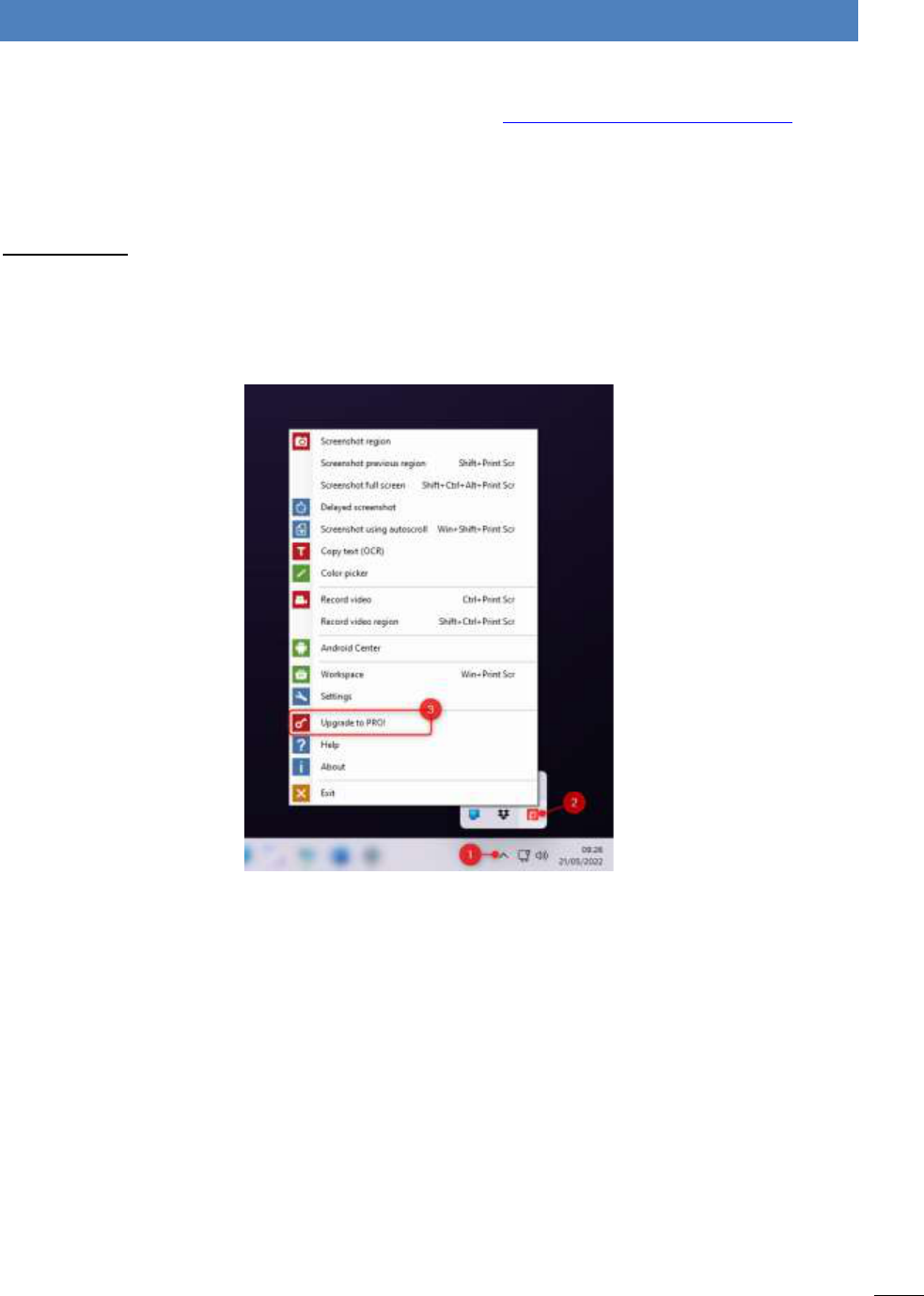
Screenpresso User Manual
Chapter
: How to activate PRO version
14
SupportEmail: replace Screenpresso team email to set company’s IT email.
5 How to activate PRO version
5.1 Activation
When you bought a license for Screenpresso PRO on our website https://www.screenpresso.com/store, you
received an activation key by email.
To switch Screenpresso FREE into Screenpresso PRO, enter your activation key using the following procedure
on the FREE version of Screenpresso.
Important note:
- Internet connection may be required for the activation process;
- It is recommended that you update to the latest available version, refer to 4.8.3.
Right click on the Screenpresso icon (1) and click on « Upgrade to PRO! » (2).
Figure 6 : Systray context menu
In the following window, click on the button, « Enter activation key » (1) and enter your activation key in (2):
use a copy-paste action to avoid errors. Your key should look like:
[0]-[screenpressopro]-[1]-[1234455]-[12/18/2011]-[zienqsdovsodpdovpsodvjspovjspodvjspodjvspovjspdojg==]
Then click on the activate button (3)
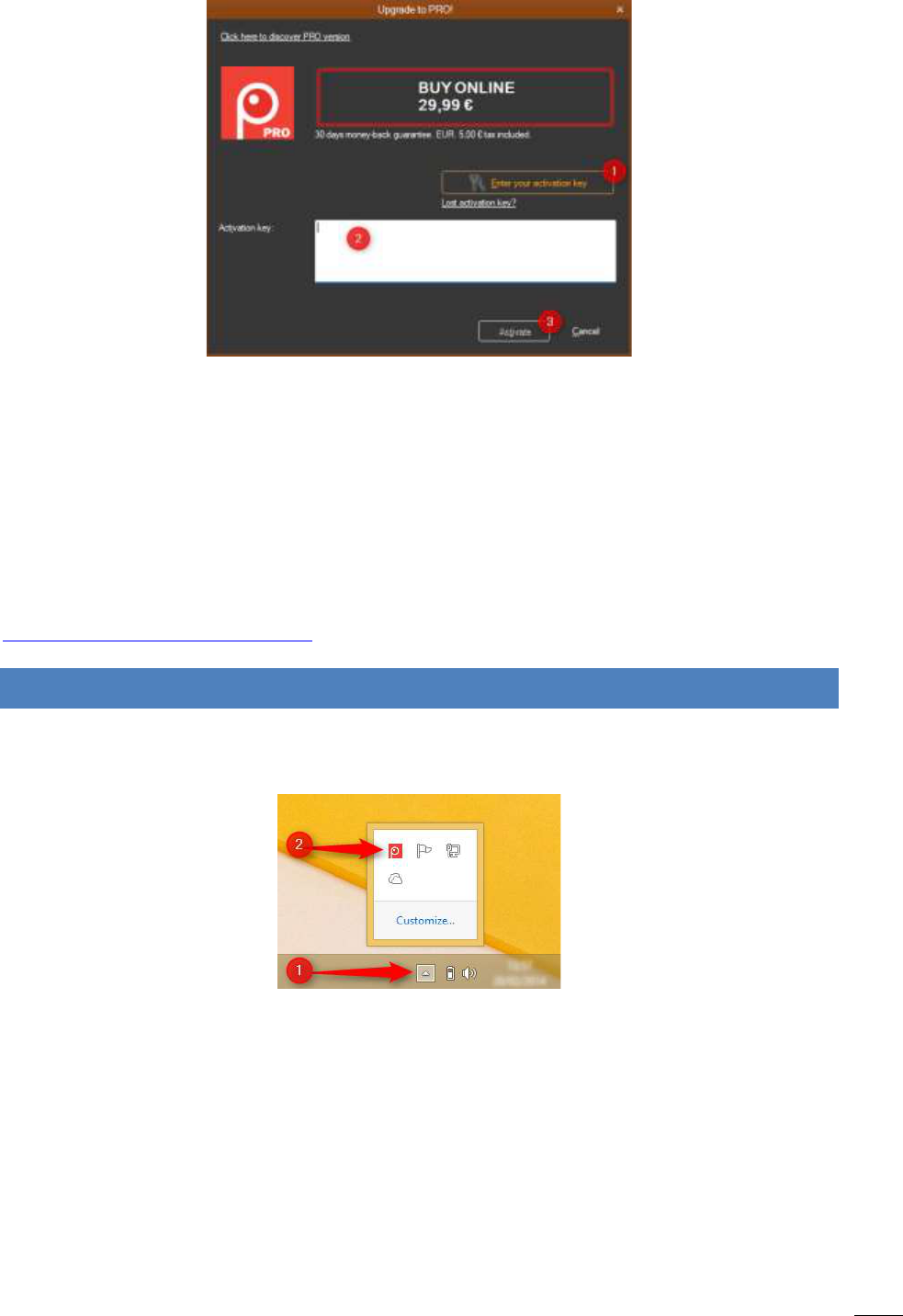
Screenpresso User Manual
Chapter
: Main concepts of Screenpresso
15
Figure 7 : Activation window
If your activation key is valid, the FREE version is switched to the PRO version and the limitations of the FREE
version are removed.
5.2 License retrieval
When changing computer, it is possible to re-use the same activation key. One user can use this activation key
on up to 5 computers before having to purchase a new license. It is not possible to unregister a previous
computer.
If lost, it is possible to retrieve an activation key using an e-mail address via this Web page:
https://www.screenpresso.com/lost-key/
6 Main concepts of Screenpresso
6.1 Always available
When Screenpresso is running, it is visible in the Windows system tray at the bottom right of the screen:
You can:
- Left click (simple click) to open the workspace window, which is the main window of Screenpresso;
- Right click to display the context menu with all the actions and the shortcuts;
- Use the shortcuts to start a capture (or the context menu or workspace button). Refer to section 6.5
to find the list of all shortcuts.
Screenpresso starts with Windows by default if you have installed it.
Refer to section 4.3 to install Screenpresso and refer to section 16 if you do not want Screenpresso to start with
Windows.
6.2 No need to bother with file location
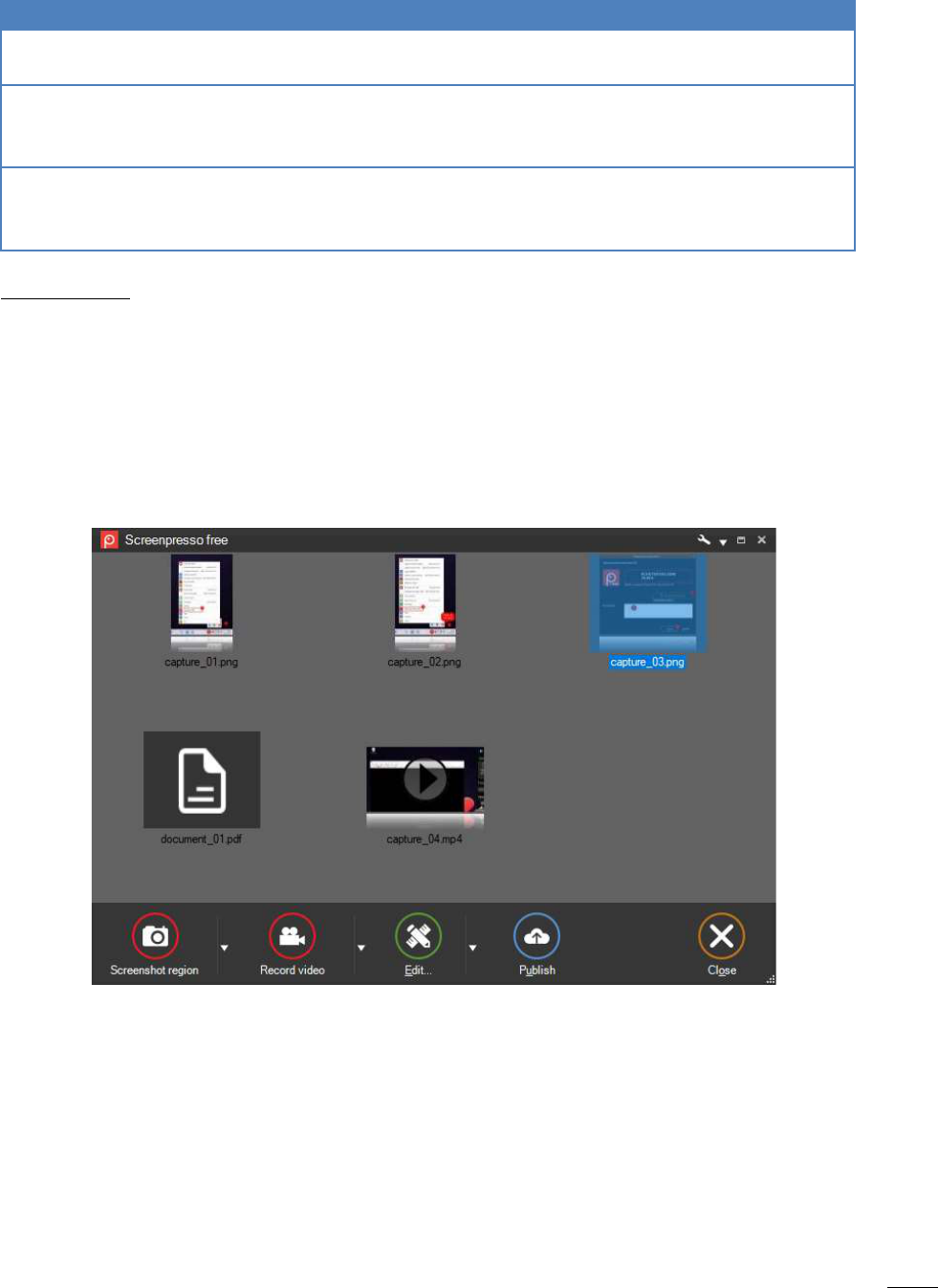
Screenpresso User Manual
Chapter
: Main concepts of Screenpresso
16
Screenpresso handles all the file locations for you, thanks to the use of a temporary folder as well as the
concept of workspaces.
By default, the following folders are used:
Folder
Description
My Pictures\Screenpresso
(C:\Users\<your login>\Pictures\Screenpresso)
This folder is the working folder and contains all the
images and videos created by Screenpresso.
My Pictures\Screenpresso\Originals
This is a technical folder for Screenpresso. It is
managed by Screenpresso and we advise against
modifying its content. It is hidden by default.
My Pictures\Screenpresso\Thumbnails
This is a technical folder for Screenpresso. It is
managed by Screenpresso and we advise against
modifying its content. It is hidden by default.
Important notes
- Screenpresso can automatically delete old files; refer to section 10.4 for details
- Refer to section 16 to change the default working folder
- Refer to section 10 to learn how to use the workspaces
6.3 Workspace for all your captures
Screenpresso handles the files for you and displays the capture in its main window, the Screenpresso
workspace.
Figure 8 : Screenpresso workspace handles the capture history
In this window, you can easily
- Create new captures
- Edit existing captures
- Copy an image or a video into the clipboard
- Generate a document (a user guide for instance)
- Drag & drop a file from or to the workspace
- Publish and share a selection of files to built-in sharing services (Dropbox, Google Drive, Evernote,
Email, etc)
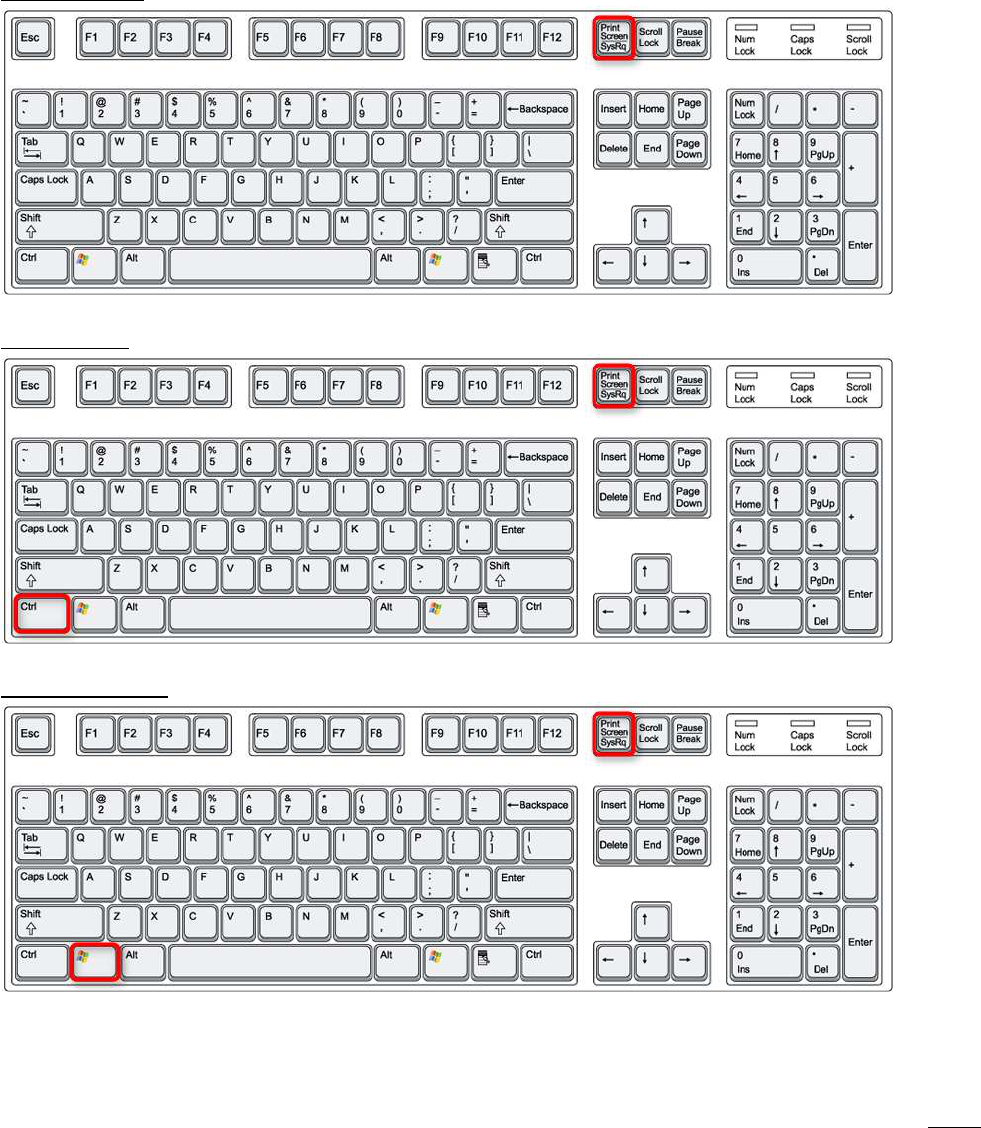
Screenpresso User Manual
Chapter
: Main concepts of Screenpresso
17
6.4 Default file format
The default image format is PNG.
The default video format is MP4.
The default document format is PDF.
6.5 Simple shortcuts
The following shortcuts are always available as long as Screenpresso is running.
6.5.1 Main shortcuts to know:
Capture an image (all in one mode: full screen, region, windows, scrolling windows): [Print screen]
Capture a video (screencast, the previous region or a default region is used): [Ctrl] + [Print screen]
Open the workspace: [Win] + [Print screen]
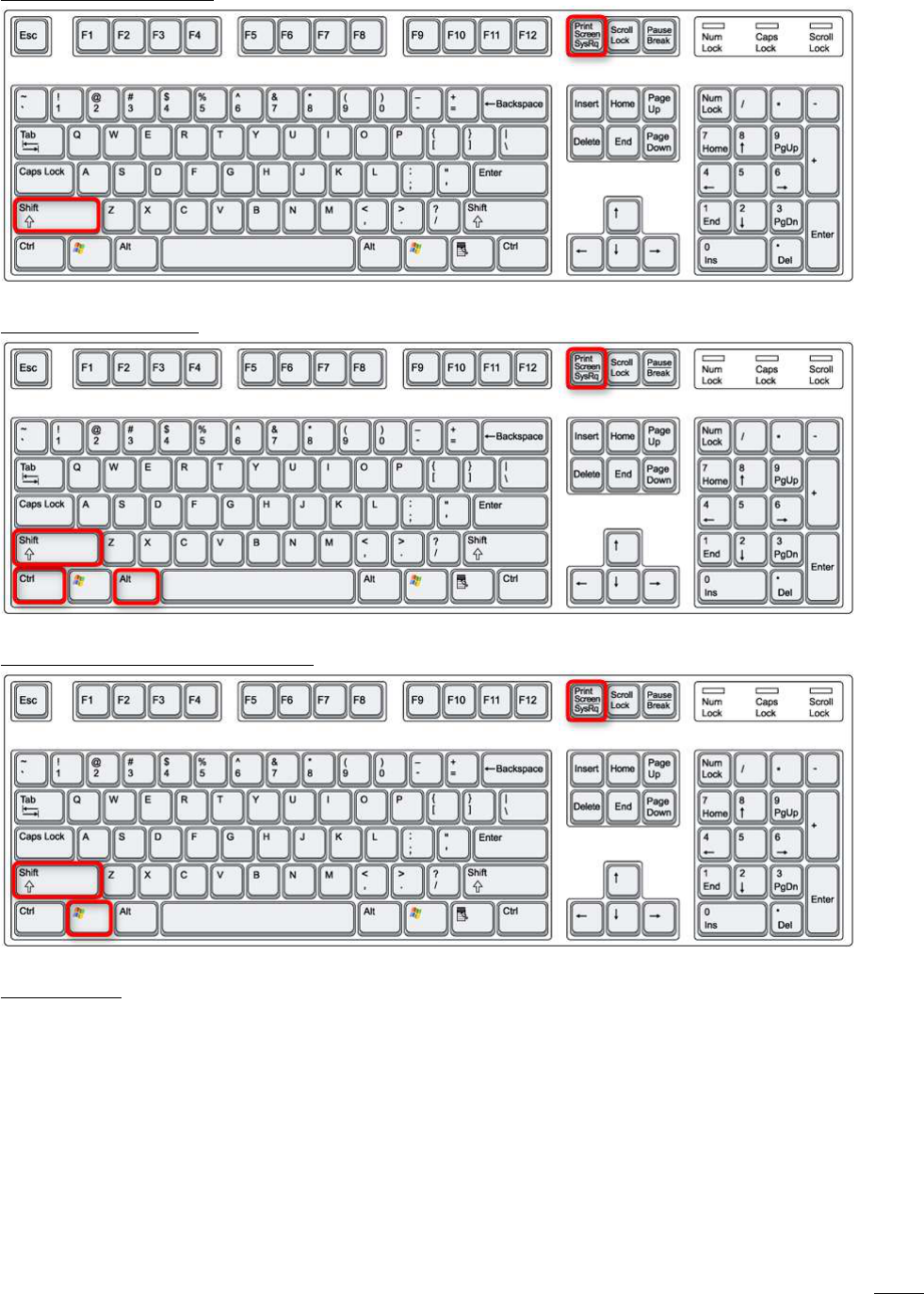
Screenpresso User Manual
Chapter
: Main concepts of Screenpresso
18
6.5.2 Other shortcuts
Screenshot the same region of the previous one: [Shift] + [Print screen]
Screenshot the full screen: [Ctrl] + [Alt] + [Shift] + [Print screen]
Screenshot a scrolling windows manually: [Win] + [Shift] + [Print screen]
Capture a video (screencast, a new region is defined): [Ctrl] + [Shift] + [Print screen]
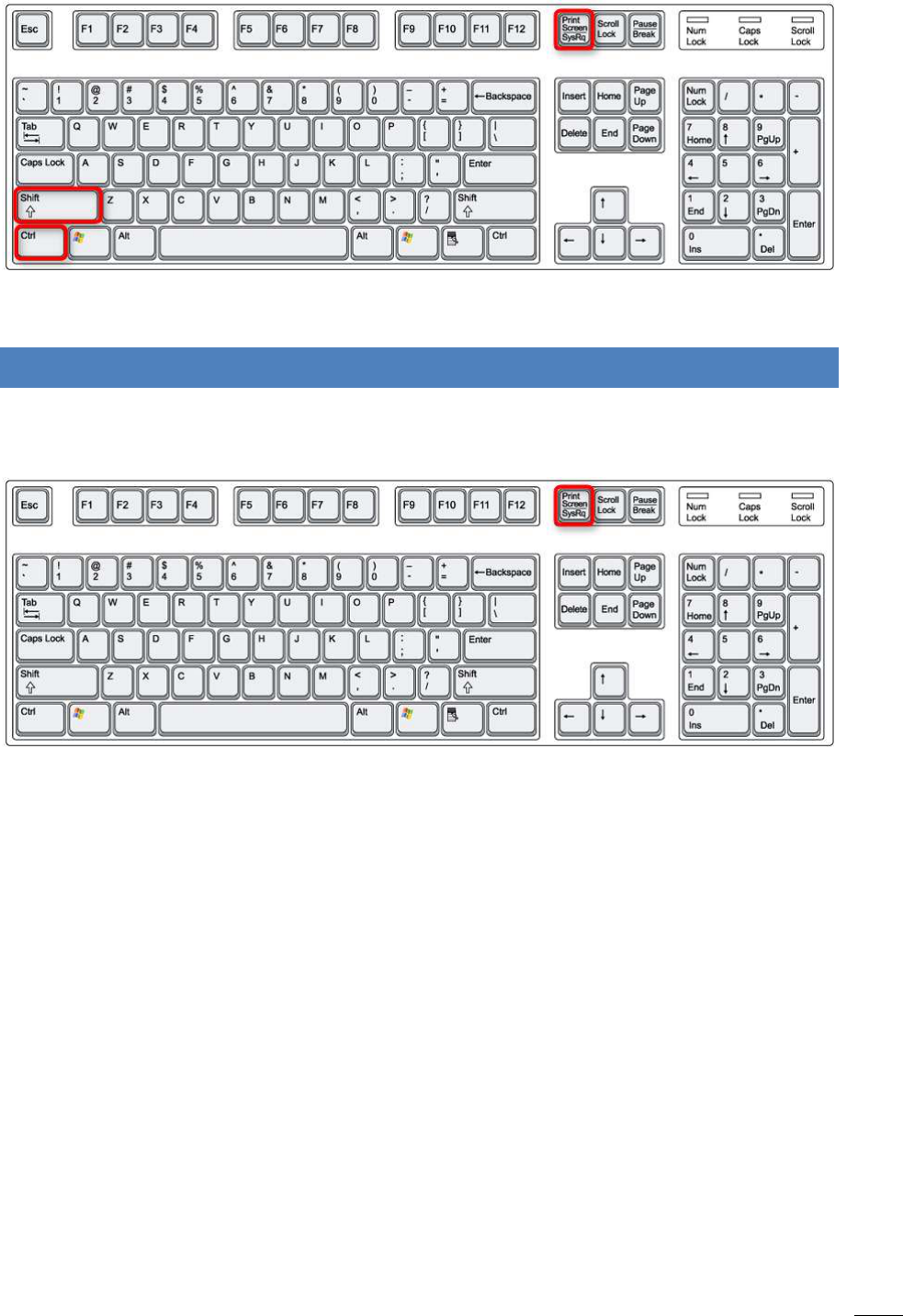
Screenpresso User Manual
Chapter
: Capture an image
19
Refer to section 16 to change shortcuts.
7 Capture an image
7.1 All in one capture mode
To create a new screenshot, press the [Print screen] key:
Figure 9 : Shortcut to create a new screenshot
Or use the System tray context menu: “Screenshot region” or use the main button of the Workspace window.
You can also use the command line: refer to section 4.5 for details.
This is an “all in one” capture mode: full screen, region, windows, scrolling windows. When you start a capture,
the screen becomes frozen and a mouse cursor becomes a crosshair. Screenpresso is now in capture mode.
You can press:
- ‘Escape’ key to quit this mode
- ‘m’ key to toggle the display of the mouse cursor
- ‘h’ key to show or hide the help panel
- You can use the mouse wheel to zoom or unzoom
Move the mouse cursor and you will see:
- Part of the screen highlighted in red;
- A red arrow pointing down if the highlighted part of the screen is a scrollable window;
- A magnifier is displayed when the mouse is moved slowly to indicate the capture dimensions and
make a selection of the pixel resolution.
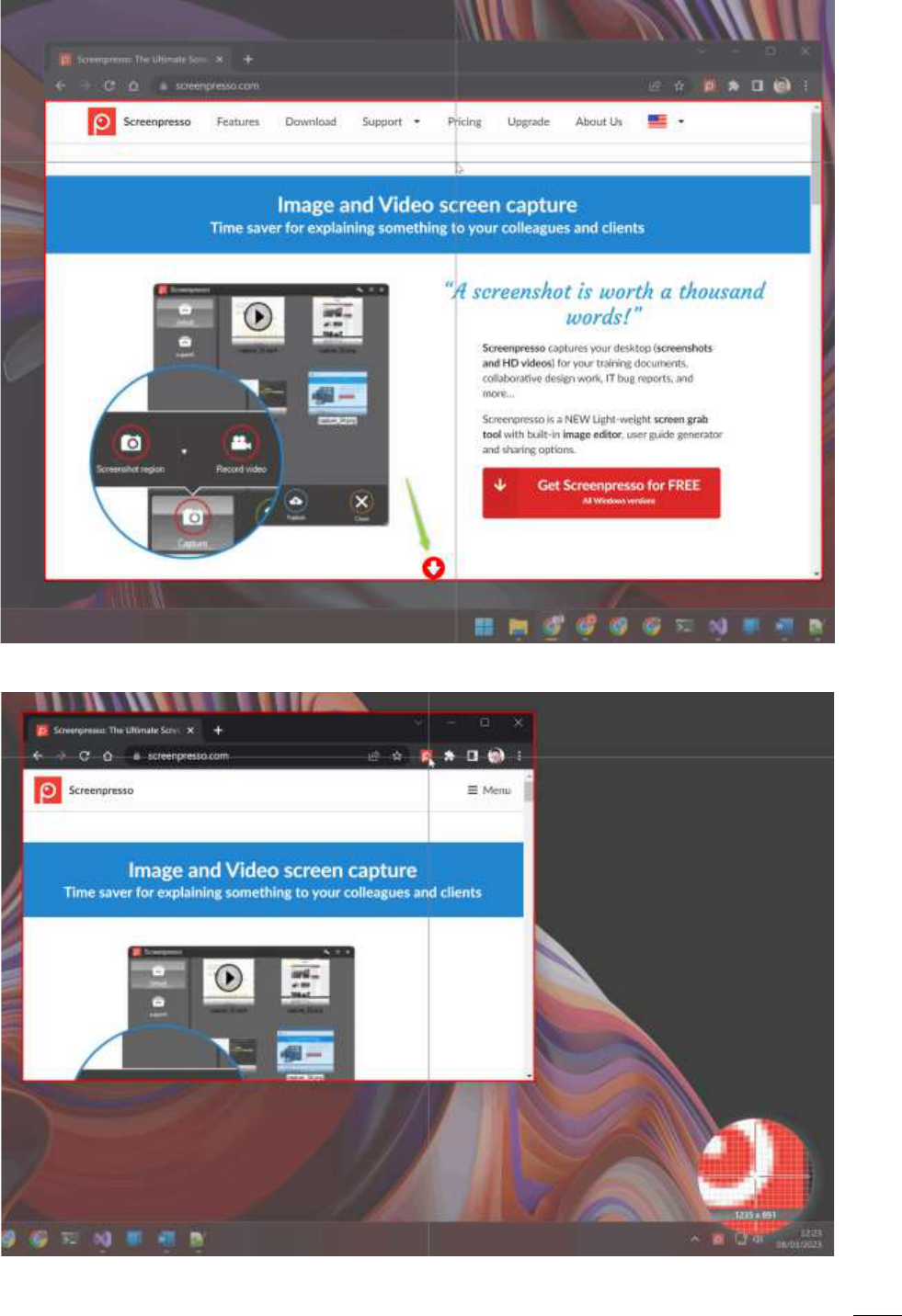
Screenpresso User Manual
Chapter
: Capture an image
20
Figure 10 : The Chrome browser is highlighted and a red arrow indicates that it is a scrolling window
Figure 11 : Magnifier glass with current capture dimensions
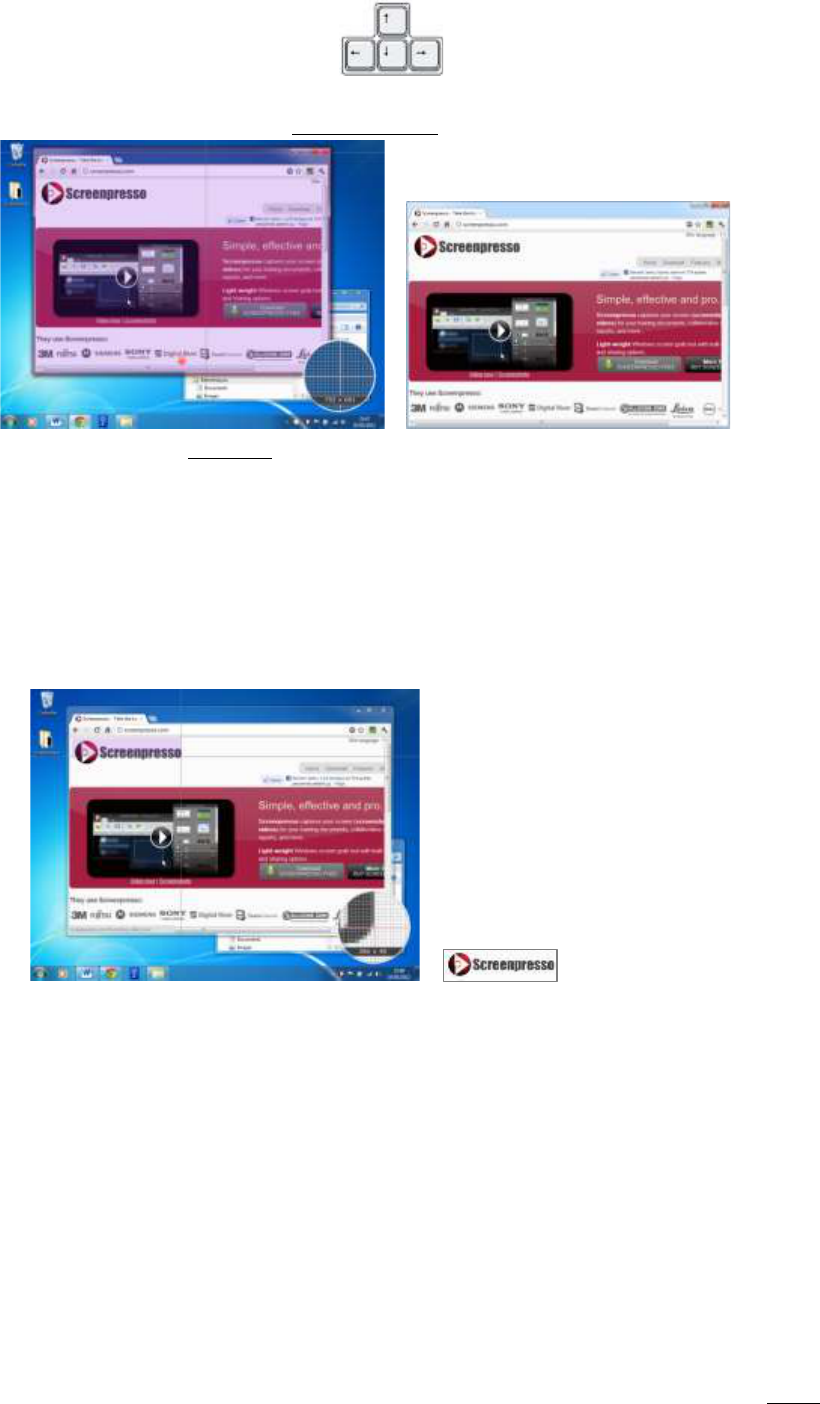
Screenpresso User Manual
Chapter
: Capture an image
21
- You can use the arrows keys to adjust your capture:
- A simple click (left button of the mouse) on a red highlighted area will capture this area
o Basically, you can use this way to capture a window or a predefined part of a window
➔
o You can also capture the full screen: move the mouse to the top of your screen and you will
see the red box covering the screen.
- Or select the area to capture by defining a window box:
o Move the mouse to the upper left or the area to capture;
o Press left mouse button and hold it;
o Move the mouse to the bottom-right of the area to capture (keep the left mouse button
down);
o Release mouse button.
➔
- Or click on the animated red downward arrow to capture a scrolling window.
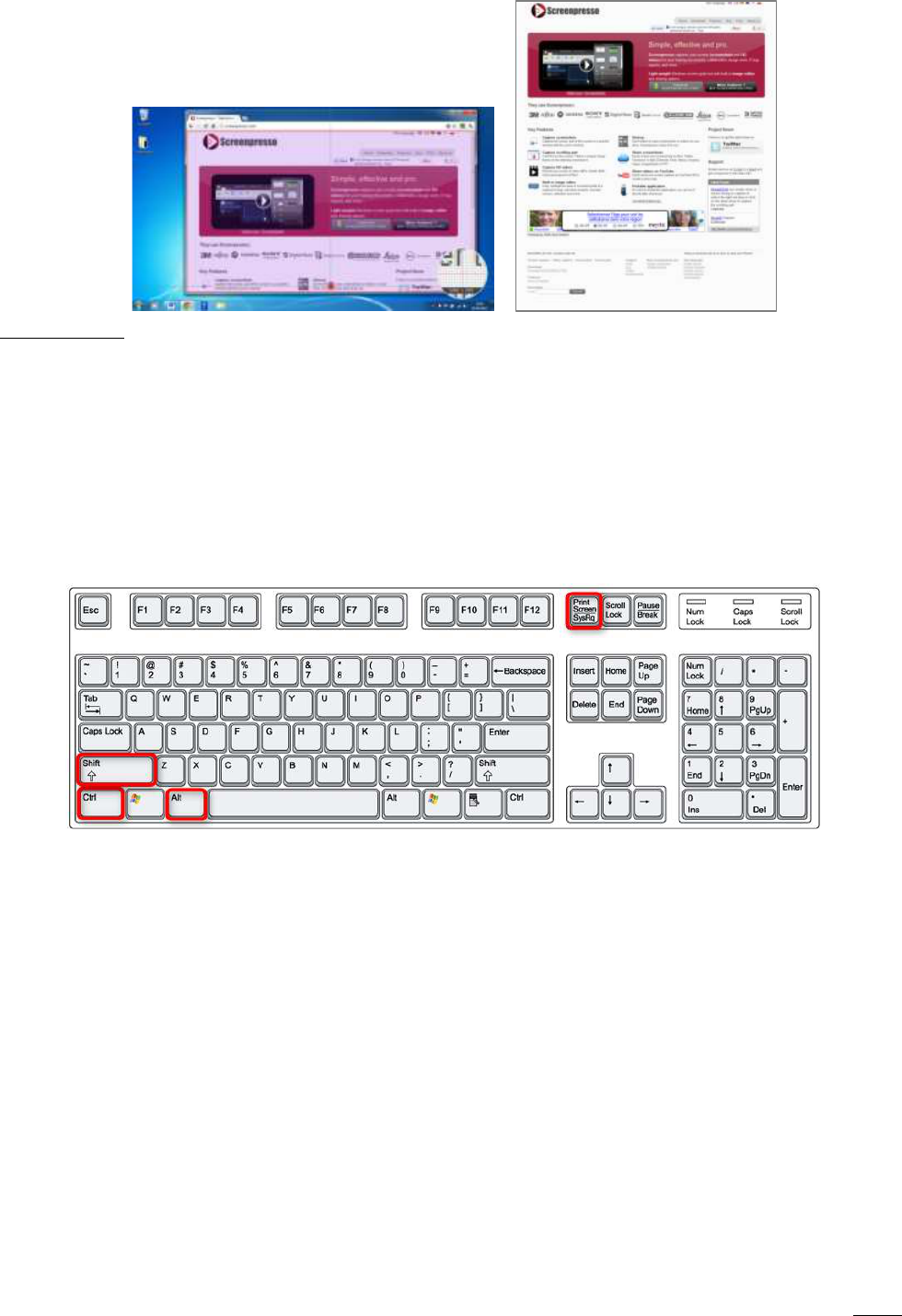
Screenpresso User Manual
Chapter
: Capture an image
22
➔
Important notes
- Mouse cursor can always be used to capture: refer to settings section 16.
- Shortcut keys (e.g., print screen key) won’t work if a window having elevated privileges has the focus
unless you have installed Screenpresso in Program Files folder.
7.2 Screenshot full screen
There are many ways to perform a screenshot of the whole screen:
1. Using the all-in-one capture mode, refer to 7.1;
2. Press « Ctrl + Alt + Shift + Print screen » key;
3. Open Screenpresso workspace; then click the small arrow of the « Screenshot region » button; then
choose the « Screenshot full screen » from the menu:
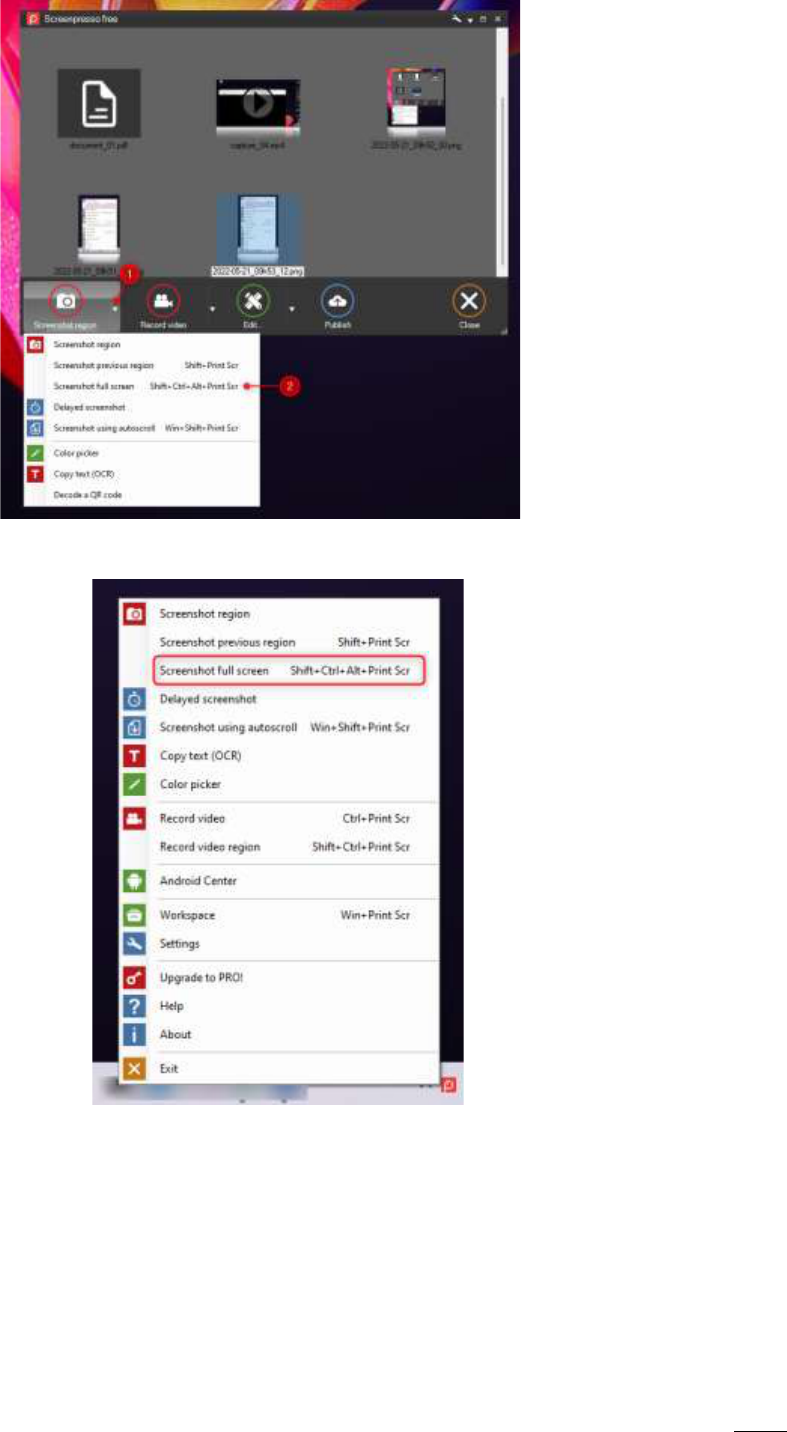
Screenpresso User Manual
Chapter
: Capture an image
23
4. Right-click the Screenpresso icon in system tray (usually at the bottom right of your screen) then select
the « Screenshot full screen » from the menu:
You capture is immediately completed.
7.3 Screenshot previous region
There are many ways to perform a screenshot of the last screen area:
1. Press « Shift + Print screen » key;
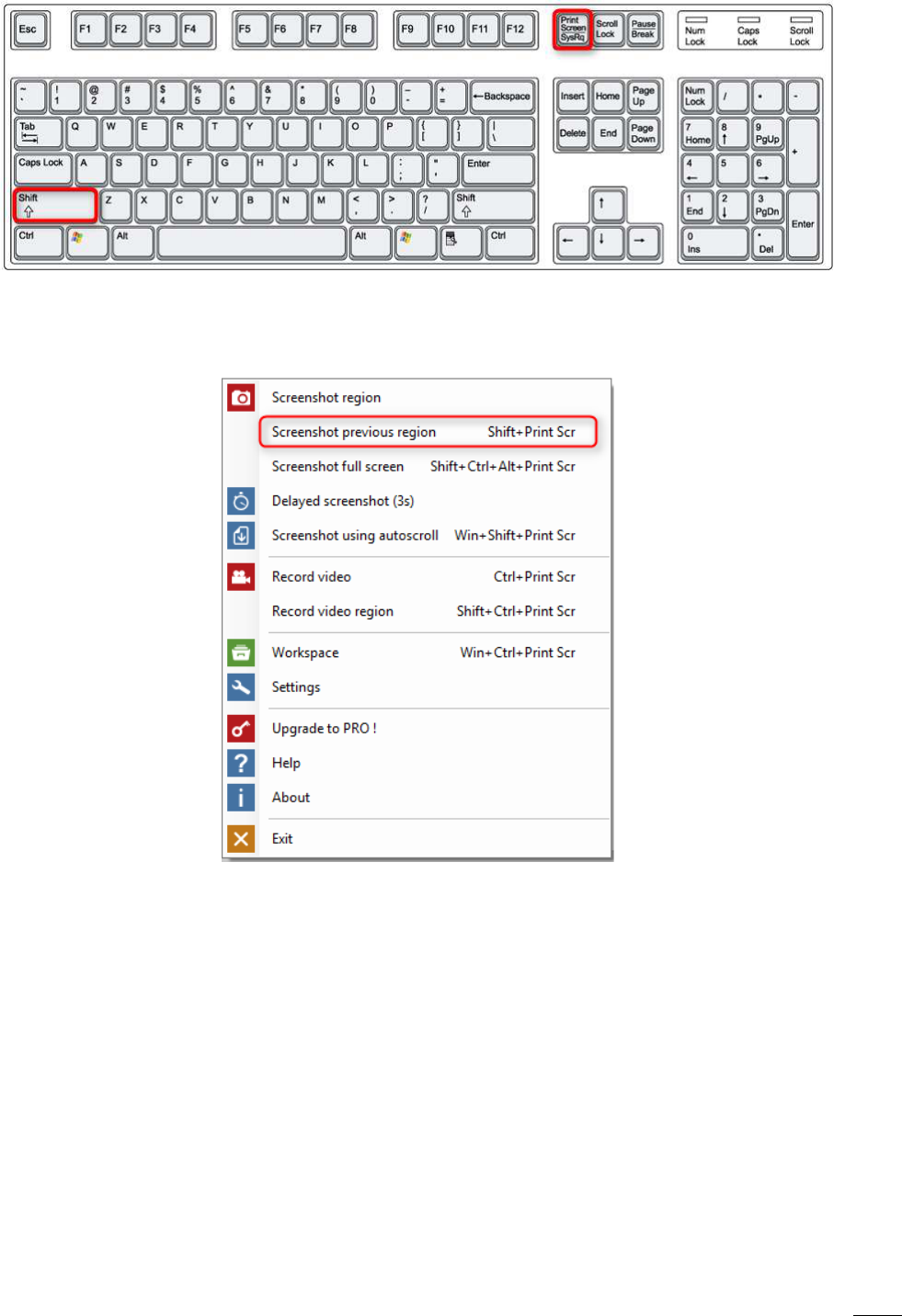
Screenpresso User Manual
Chapter
: Capture an image
24
2. Open the Screenpresso workspace; then click the « Capture » button; then click the small arrow of the
« Screenshot region » button; then choose the « Screenshot previous region » from the menu.
3. Right-click the Screenpresso icon in system tray (usually at the bottom right of your screen) then select
« Screenshot previous region » from the menu.
You capture is immediately completed.
This command is very useful for people who always want to capture the same area of the screen and also have
all screenshots using the same boundaries.
7.4 Screenshot scrolling windows
The area to capture may not be fully displayed on screen, for instance a long webpage is not completely visible
and scrollbars are present to scroll the visible part.

Screenpresso User Manual
Chapter
: Capture an image
25
Screenpresso can capture the complete window:
7.4.1 Capture of a web page
The best way to capture a whole web page, including scrolling area, is to install the specific’s Screenpresso Web
browser extension when available. The extension can work standalone. If you don’t have Screenpresso running
on your computer then the Web page is captured, and an image file is generated. Via settings you can setup
the generated file to be a PNG, a JPG or even a PDF file. You can also choose the capture to be simply stored in
the clipboard. If Screenpresso is running, the extension sends the capture to it automatically, so it behaves like
if you performed the capture using Screenpresso itself.
To be able to install the extension for Google Chrome, open this URL:
https://chrome.google.com/webstore/detail/screenpresso/agffhkejbocomabiogfdjnbfcnpdljie
7.4.2 Automatic auto scroll capture
Refer to the “All in one” capture mode in section 7.1
Important notes
- Before starting the capture, you should put the scrollbar cursor at the top position.
- This mode captures only a vertically scrolling window. If you need horizontal scrolling captured, refer
to 7.4.3.
7.4.3 Manual auto scroll capture
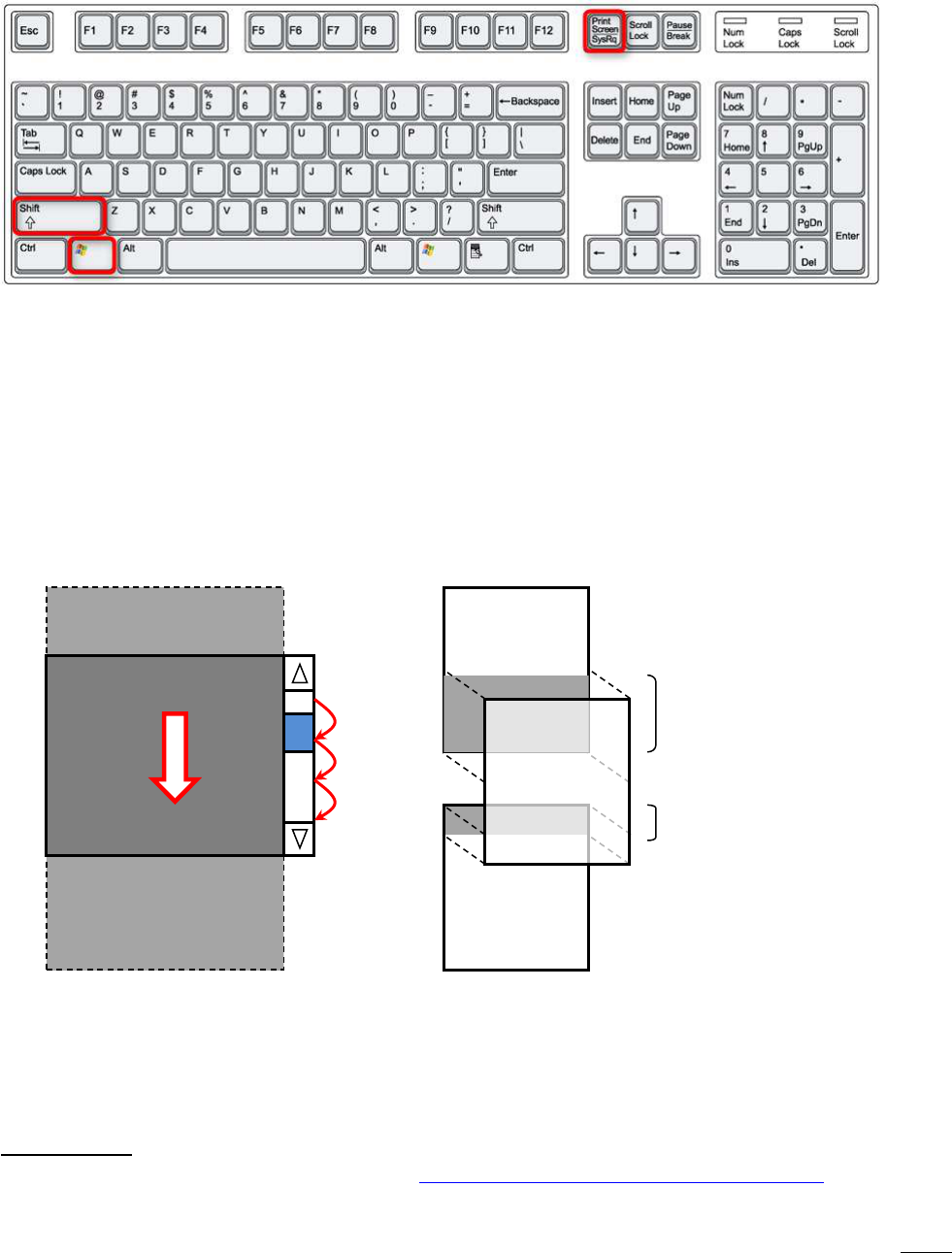
Screenpresso User Manual
Chapter
: Capture an image
26
When the automatic mode does not work, for instance if you try to capture a horizontal scrolling window, use
this manual mode that captures several images and merge them using a stitching algorithm.
There are many ways to perform a manual auto scroll screenshot:
1. Press « Win + Shift + Print screen » key
2. Open Screenpresso workspace; then click the small arrow of the « Screenshot region » button; then
choose the « Screenshot using auto scroll » from the menu.
3. Right-click the Screenpresso icon in system tray (usually at the bottom right of your screen) then select
« Screenshot using auto scroll » from the menu.
A window will explain how to use the feature:
1. Select the scrolling part of the screen to capture, without the scrollbar
2. Scroll down and release the left mouse button several times during scrolling to take successive
screenshots which each overlap their predecessor. A screenshot is stored each time the left mouse
button is released:
3. Click the right mouse button to finish the capture operation and start the processing to merge the
screenshots and generate the result
Important notes
- you can find video tutorials on the Internet: https://www.youtube.com/watch?v=pssN7gWXfVs
Screenshot 1
Screenshot 2
Screenshot 3
Overlaps
between the 2
screenshot
Overlaps
between the 2
screenshot
Screenshot 1
Screenshot 2
Screenshot 3
Figure 12 : Capture process for manual stitching

Screenpresso User Manual
Chapter
: Capture an image
27
7.5 Capture workflow
The following workflow applies when you want to capture a new image, the optional part within the dotted
line.
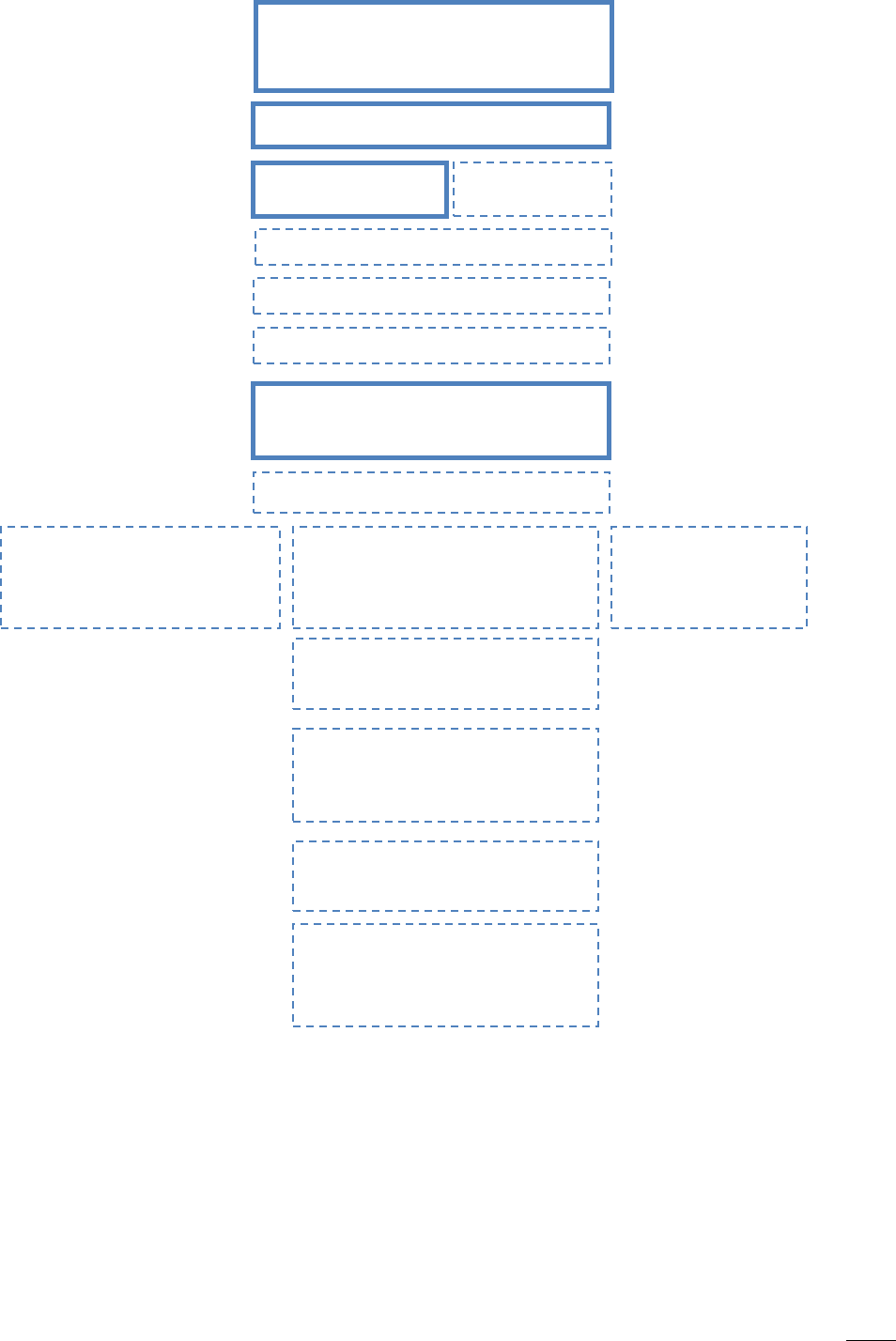
Screenpresso User Manual
Chapter
: Capture an image
28
Press the [Printscreen] key or
Workspace > Capture > Screenshot region or
System tray context menu > Screenshot region
Select the part of your screen to capture
The image is saved in the current
workspace and on the clipboard
Paste, Publish or drag&drop
your image in your application
(e-mail, document, etc…)
The Workspace window is displayed
Click on the Edit button to open
the built-in editor
Edit your image: add rectangles, arrows,
annotations, highlights …
Click on the “Copy & Exit” button
to close the editor, save the file and
put the file in the clipboard
The Workspace window is
displayed
Paste, Publish or drag&drop your
image in your application (e-mail,
document, etc…)
The Workspace
window is
automatically closed
Automatic resize (optional)
Automatic effects (optional)
Watermark applies (optional)
An image is created
The context is
stored

Screenpresso User Manual
Chapter
: Capture an image
29
Important notes:
- The watermark can be used to add your signature or the name of your company in each Screenshot:
refer to section 16
- The filename of the image can be configured through the settings: refer to section 16.
- The image is saved to the disk. By default, “PNG” file format is used. This can be configured to JPG,
GIF, BMP or TIF via settings: refer to section 16
- The clipboard content can be also configured: refer to section 12
- All optional actions can be configured through the settings: refer to section 16
- The context of the capture can be captured if enabled. For instance, the URL of the captured Web
page can be captured so it could be used later. This option is disabled by default
- The resolution of your image depends on your screen resolution. By default, it is 96DPI
7.6 Color picker (PRO)
The magnifier will display the RGB values of the pixel under the mouse. Press ‘H’ to switch display between
hexadecimal and decimal. When you click, the value is sent to the clipboard.
7.7 Screenshot text (PRO)
Screenpresso can quickly capture an image then perform Optical Character Recognition (OCR).
Click “Copy text” from systray menu or workspace then select an area of text. Please notice there is no shortcut
configured by default, but you can add one via Screenpresso settings.
Figure 13 : Screenshot default workflow
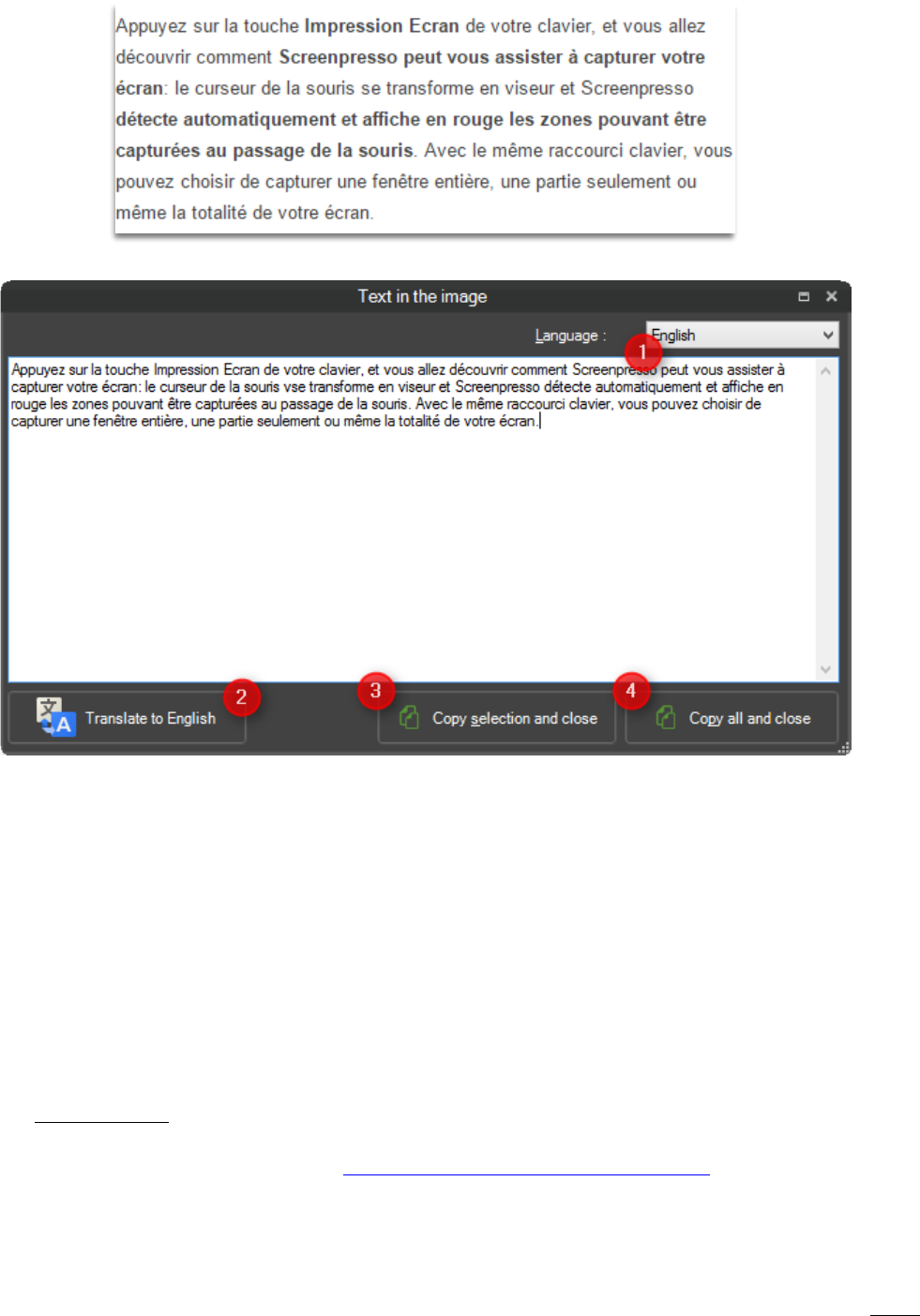
Screenpresso User Manual
Chapter
: Capture an image
30
This sample image, captured from Screenpresso Web site
is recognized and a window opens to display the result:
1. You may configure the language of the input text to improve OCR result
2. You may translate the result to your language.
This feature uses Google Translate service. Please make sure your text is not confidential and that you
have a working Internet connection.
3. You may change part of the displayed text then press this button to copy selected text to the clipboard
then close the window
4. You may change part of the displayed text then press this button to copy the whole text to the
clipboard then close the window
If you want to close the window without copying any text to the clipboard, simply use the cross at the
upper right of the window.
Please notice this window is sizable if you need to display more text to the screen.
Importants notes
Using the Tesseract engine you can add your own language:
1. Download your files from here: https://github.com/tesseract-ocr/tessdata_best
2. Move the downloaded file to the folder
%LocalAppdata%\Learnpulse\Screenpresso\Tesseract\tessdata
3. Run OCR from Screenpresso
4. Choose your language in the upper-right menu
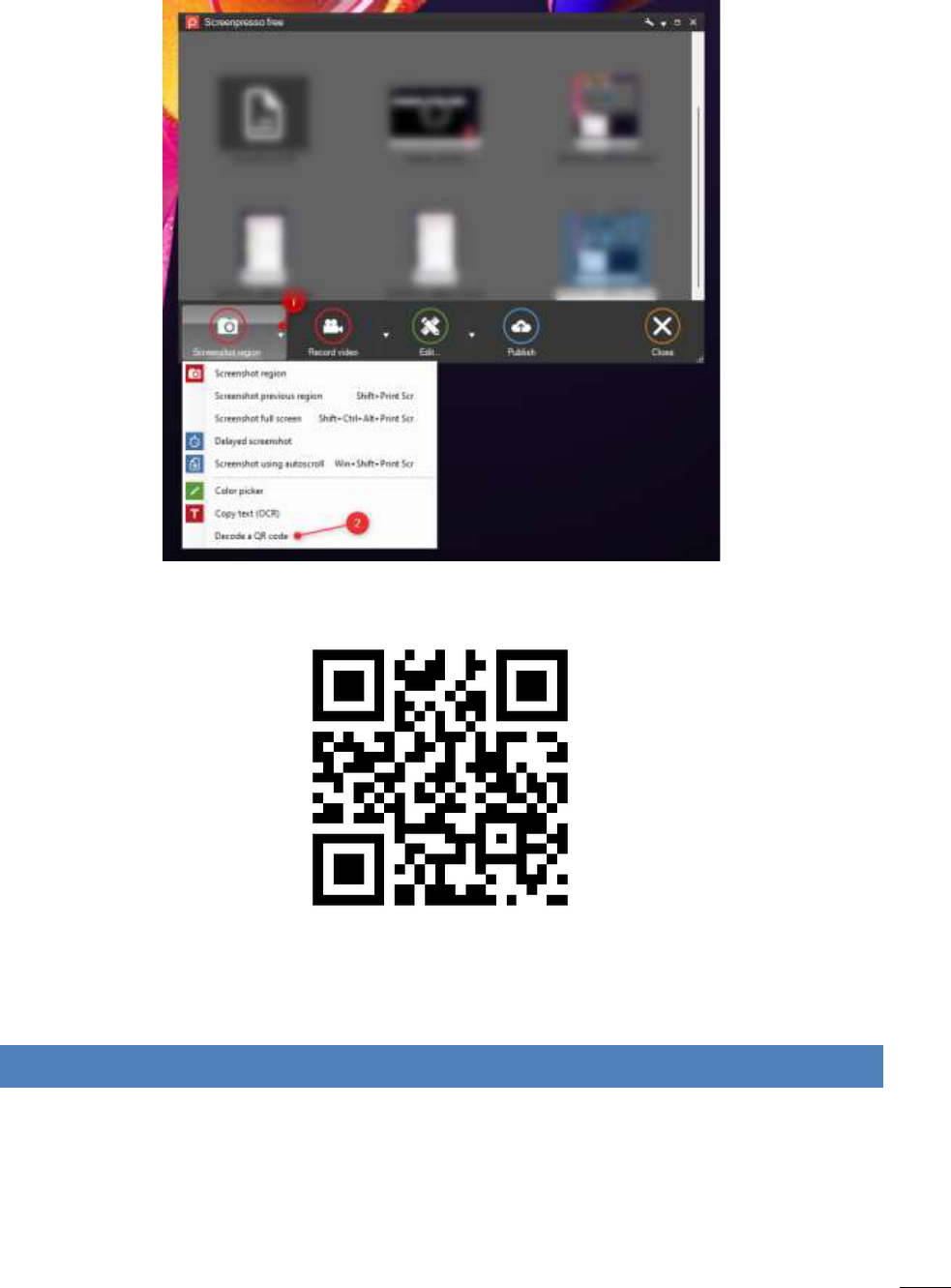
Screenpresso User Manual
Chapter
: Capture a video
31
7.8 Capture a QR code (PRO)
Screenpresso can quickly capture an image then perform QR code or Bar code decoding.
Click “Decode a QR code” from systray menu or workspace then select an area of text. Please notice there is no
shortcut configured by default but you can add one via Screenpresso settings.
Here’s a sample QR code:
It is analyzed then:
• either it is an URL, then your default browser is opened
• either it is text, then it is copied to the clipboard
8 Capture a video
8.1 Overview
Screenpresso allows you to record a movie of your screen activity, including sound using the microphone.
This is useful for creating tutorials, software demos or for reporting software issues.
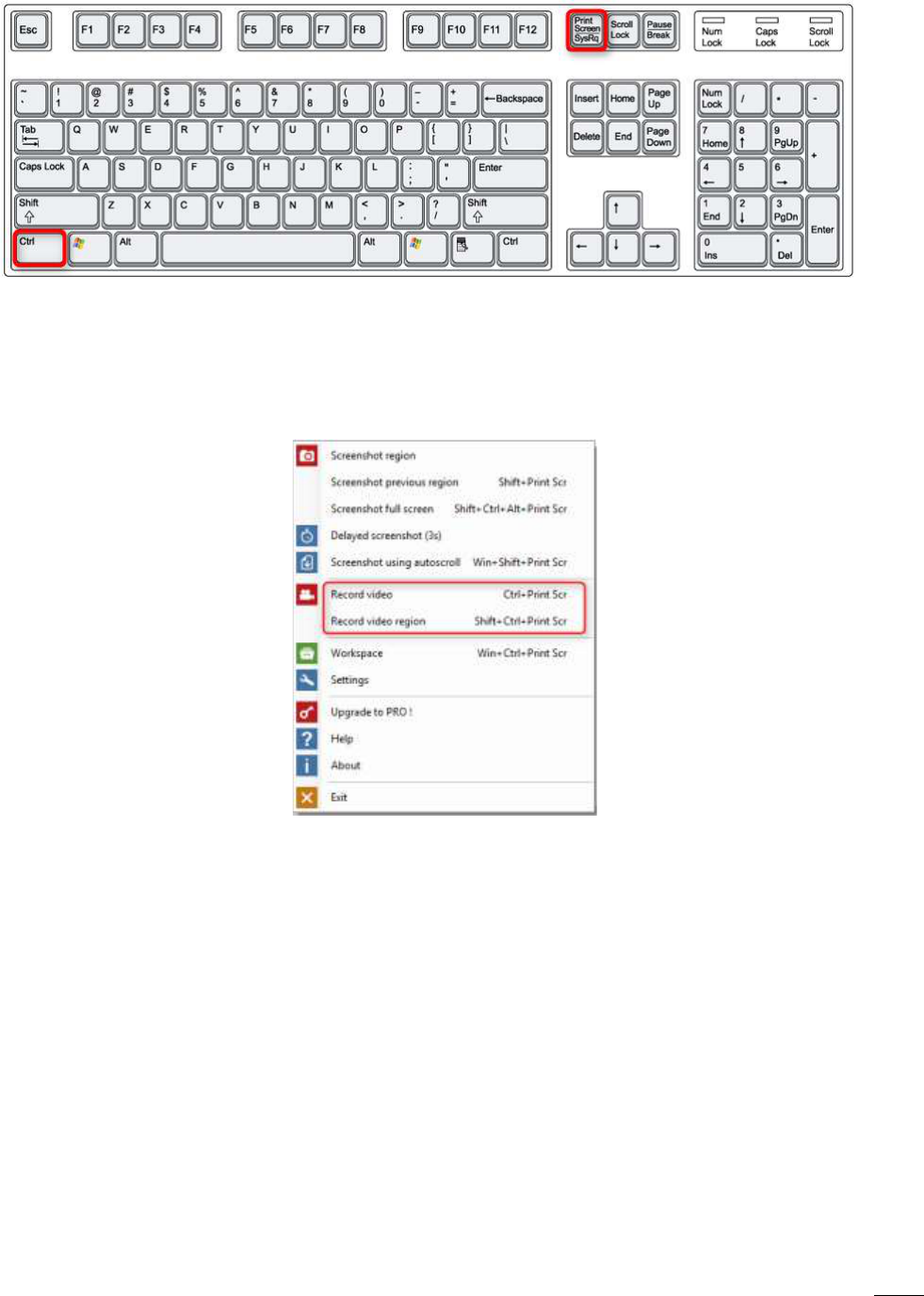
Screenpresso User Manual
Chapter
: Capture a video
32
There are many ways to start a video session:
1. Press « Ctrl + Print screen » key
2. Open Screenpresso’s workspace; then click the « Record video ».
3. Right-click the Screenpresso’s icon in the system tray (usually at the bottom right of your screen), then
select « Record video » from the menu.
4. Use the command line: refer to section 4.5 for details.
The area outside of the selection becomes grey and the video toolbar appears. The area is fully resizable if
necessary. The toolbar displays some options for recording.
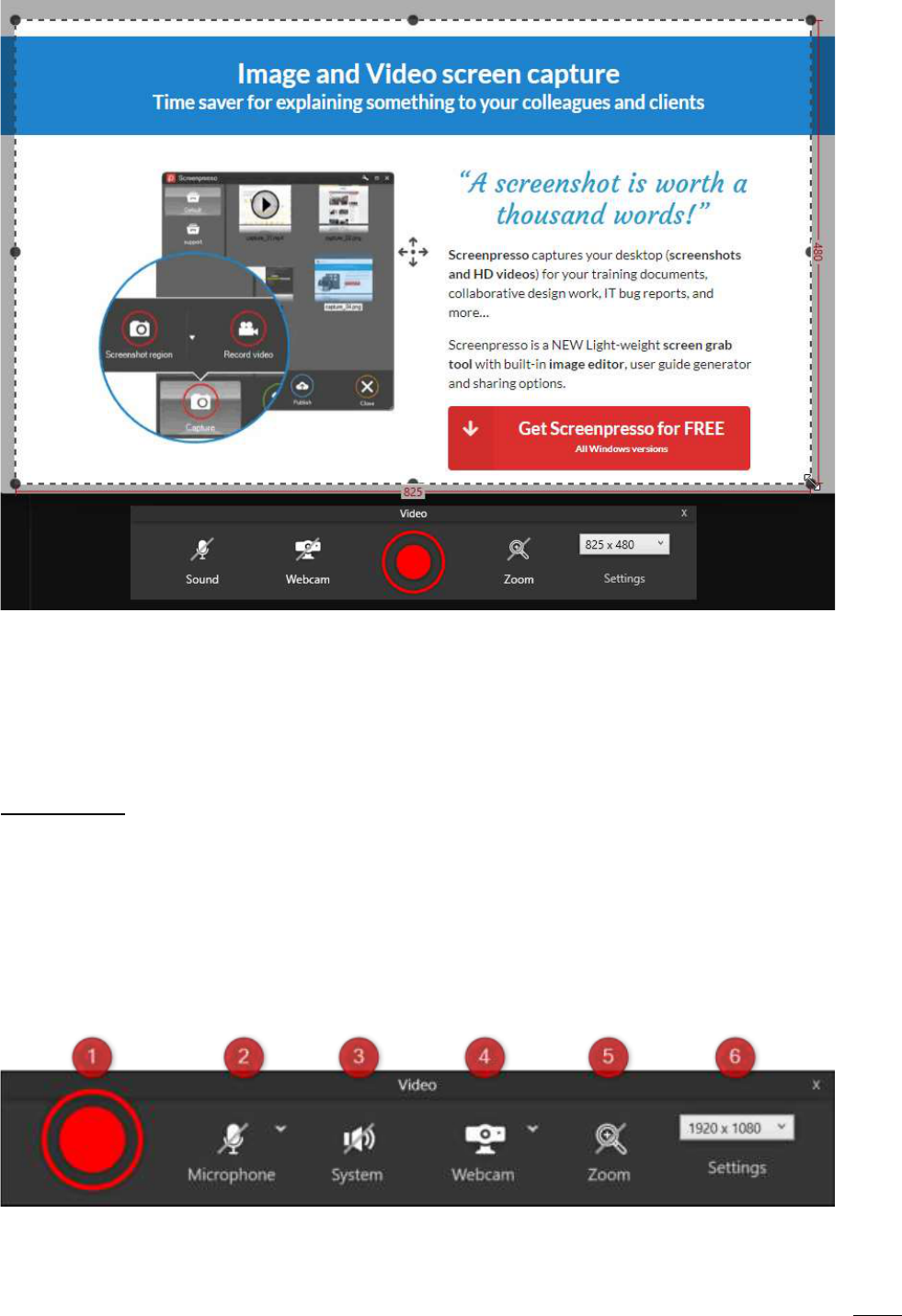
Screenpresso User Manual
Chapter
: Capture a video
33
1) The record area: this part of the screen will be recorded in the video:
2) Use the handles to resize the record area;
3) Use the handle to move the area to be recorded;
4) Video toolbar
5) This part of the screen is not recorded in the video. See below for details.
Important notes
- If “Direct MP4 recording” option is not checked, Screenpresso uses its own codec which is optimized
for screen capture. It records as AVI files and then converts the files into standard formats such as
MP4.
- It is not recommended that you change the codec as some codecs may not support the dimensions of
some recorded areas.
8.2 Video Toolbar
1) Start recording button
2) Enable sound recording of the microphone (to record what you say)
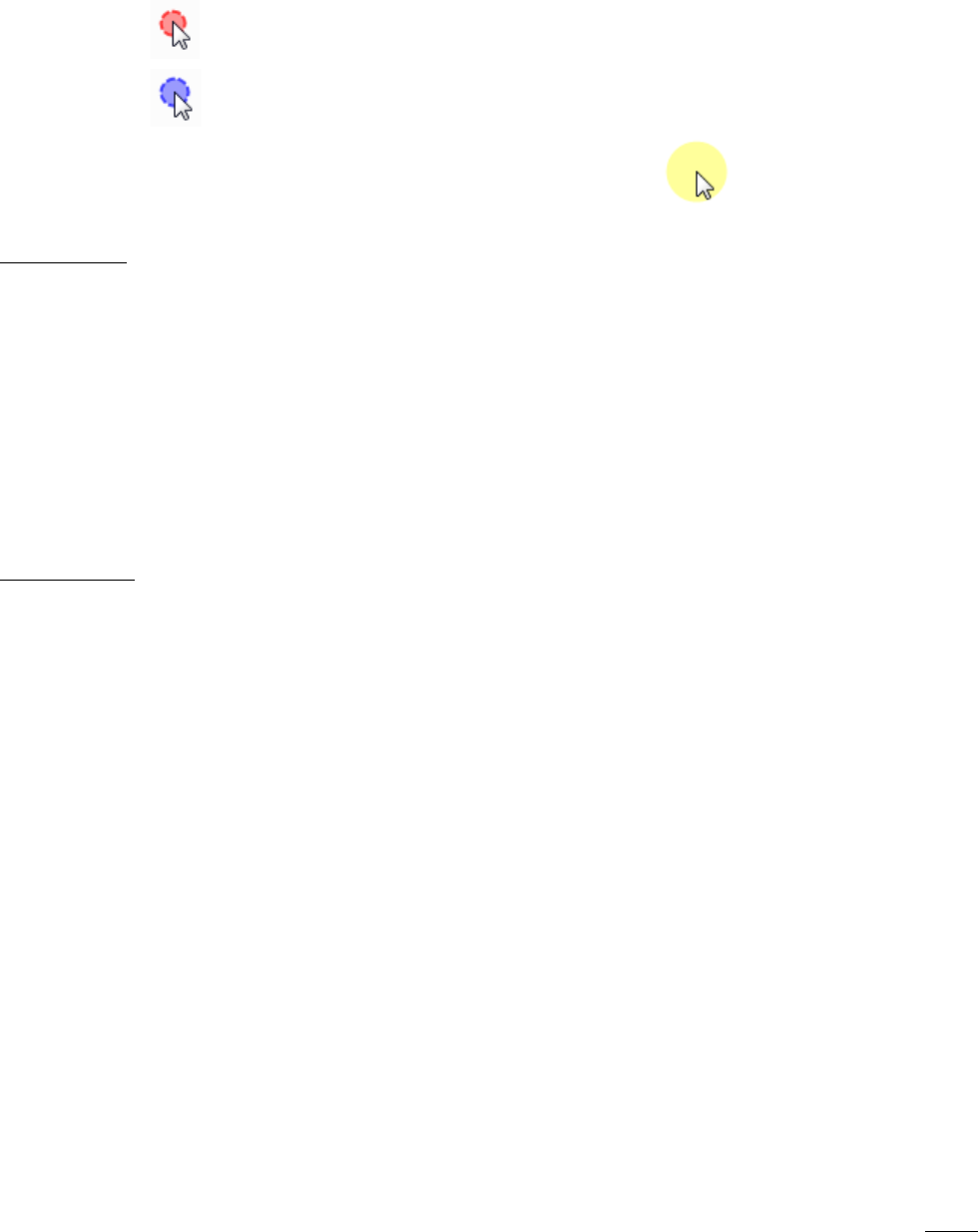
Screenpresso User Manual
Chapter
: Capture a video
34
3) Enable the system sound recording (to record what you hear)
4) Show or hide the Webcam
5) Zoom the recorded area around the cursor
6) Video area dimensions: width x height in pixels and list of predefined video area dimensions
(it is recommended that you use standard video size as post resizing may blur the video)
During recording, these mouse effects are available:
Left mouse click:
Right mouse click:
In the settings, you have also an option to highlight the cursor with a yellow halo:
Important note
- Refer to the settings section 16 for advanced configuration.
8.3 Sound recording
You can enable or disable sound recording.
Screenpresso fully supports recording sound from the microphone and is based on Microsoft Window’s engine.
You should first configure your recording input and levels using the Windows sound mixer. You may also record
sound from system (what you hear).
During recording, Screenpresso’s icon blinks in Windows system tray. Color is blue if sound recording is
enabled, purple if sound recording is disabled.
Important notes
- Before recording a long video, make a short video trial to ensure the microphone sound level is
acceptable.
- Make sure you have activated the sound recording via the configuration button.
- If sound is garbled, try this: in Windows’ control panel, open microphone properties, go to ‘Advanced’
tab, and then uncheck ‘Enable audio enhancement’.
8.4 Webcam
Webcam recording is supported by Screenpresso:
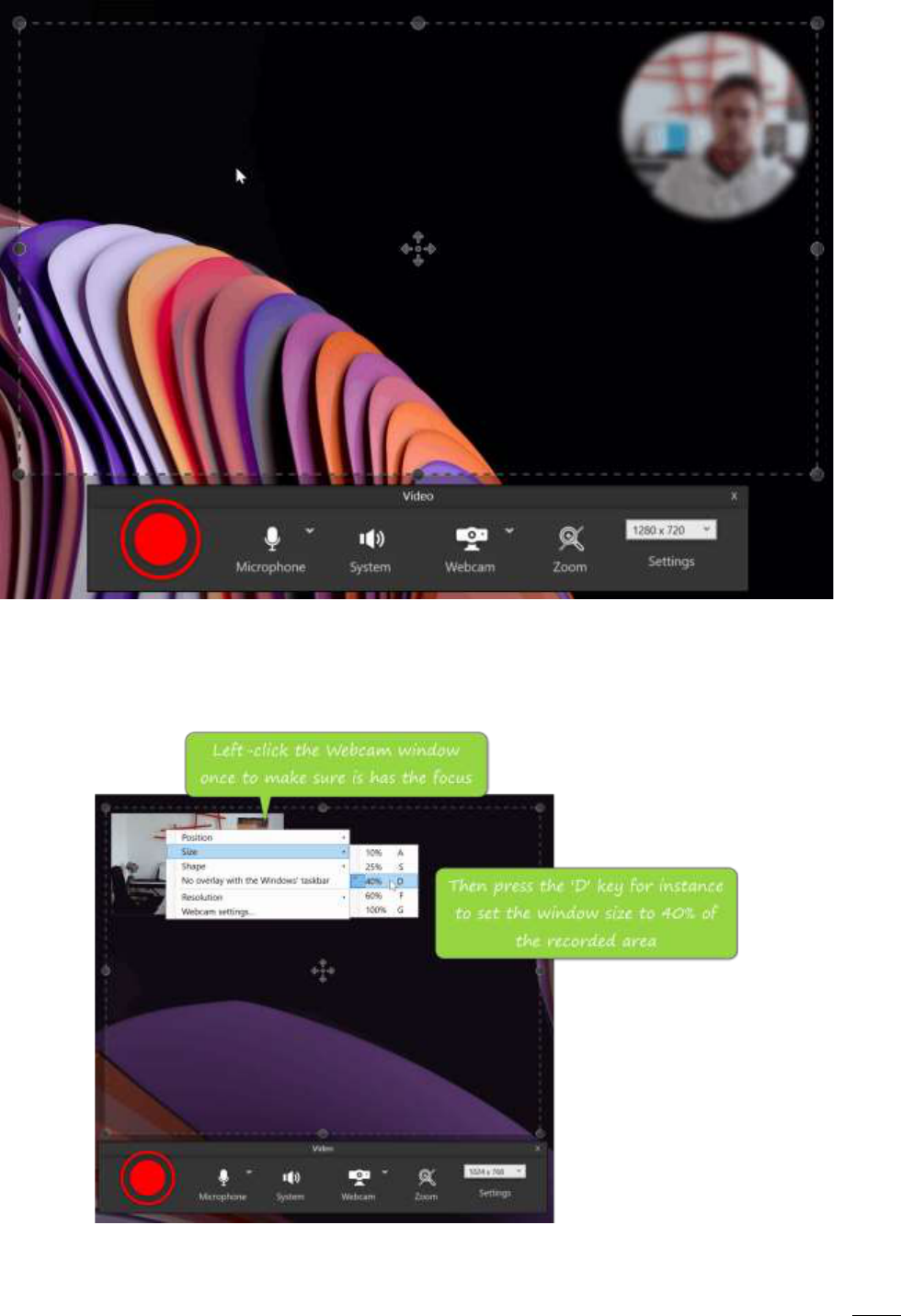
Screenpresso User Manual
Chapter
: Capture a video
35
To turn on the webcam, press “Win + F7” shortcut. You can hide the webcam using the same shortcut.
This shortcut is available during recording so you can easily toggle the display of the webcam.
If you right-click on the Web cam window, you can change some parameters
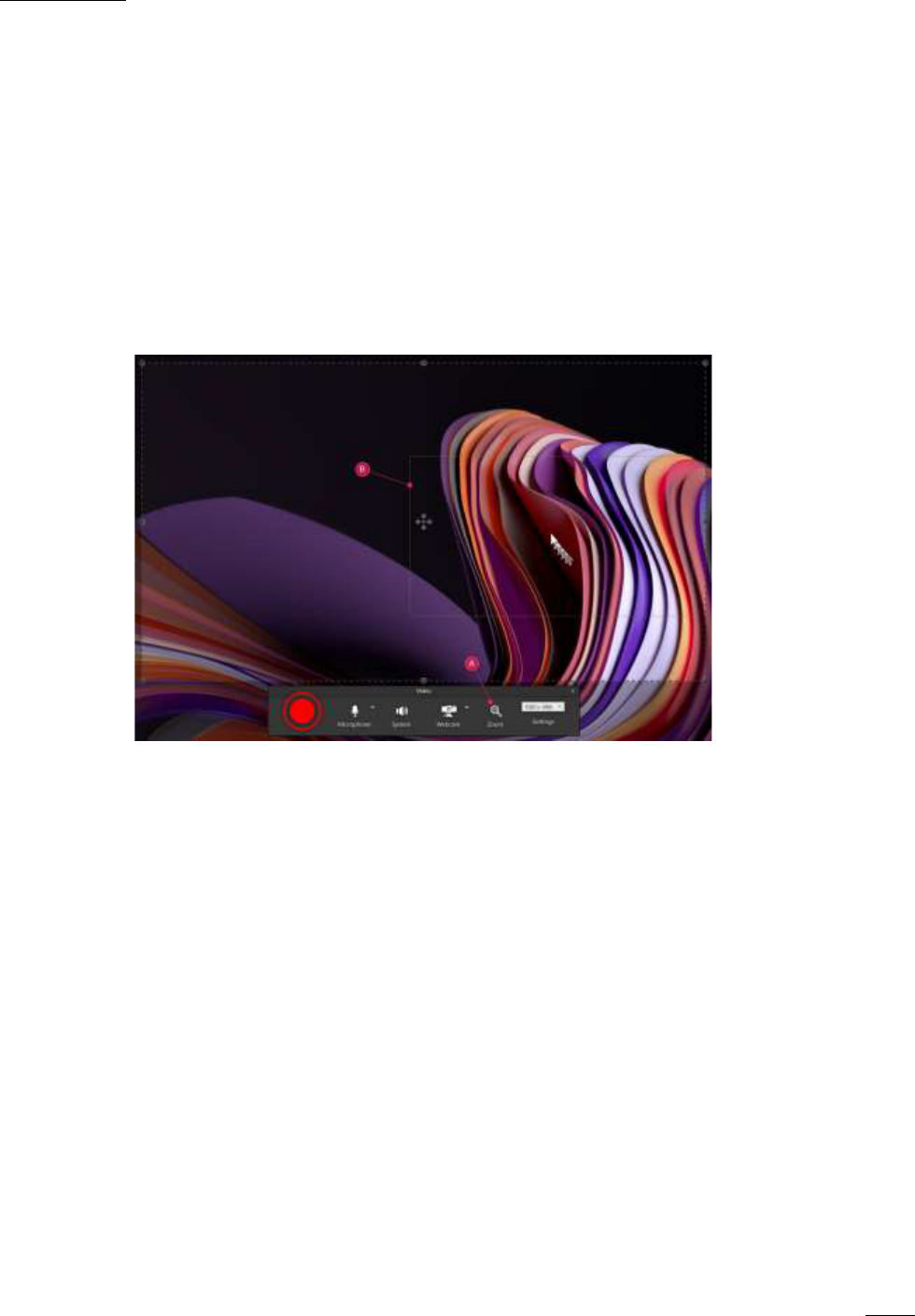
Screenpresso User Manual
Chapter
: Capture a video
36
Important notes
- Settings of the Webcam are persistent, you can show the Webcam window before starting video
recording, setup the size, and then hide it. During recording, when you will show the Webcam
window, it will appear with the correct position and size
- It is also recommended that you show the Webcam window once before recording to avoid the
webcam appearing slowly (due to initialization) in your record
- The shortcuts work only when the Webcam window has the focus
8.5 Video zoom
During recording, you can also zoom (x2) and focus the recording around the mouse cursor using the shortcut:
[Win] + [F8].
[Win] + [F8] will toggle the zoom (on/off).
Screenpresso will ensure that the mouse is always visible, even if the zoom is activated. A green rectangle (1) is
displayed to show you the zoomed recording area:
Figure 14: Video zoom box
8.6 Start recording
To start recording: click the big red button.
To pause or resume the video recording: press [Ctrl] + [Print Screen] shortcut or use the Screenpresso system
tray menu.
To stop the video recording:
• Press [Print Screen] key;
• Or right-click on Screenpresso’s icon in the system tray, then click on “Stop” from the menu.
Notice: if you click the “Exit video mode” instead, the recording stops and the video is lost.
When the recording ends, the Screenpresso’s built-in media player plays the video: refer to chapter below.
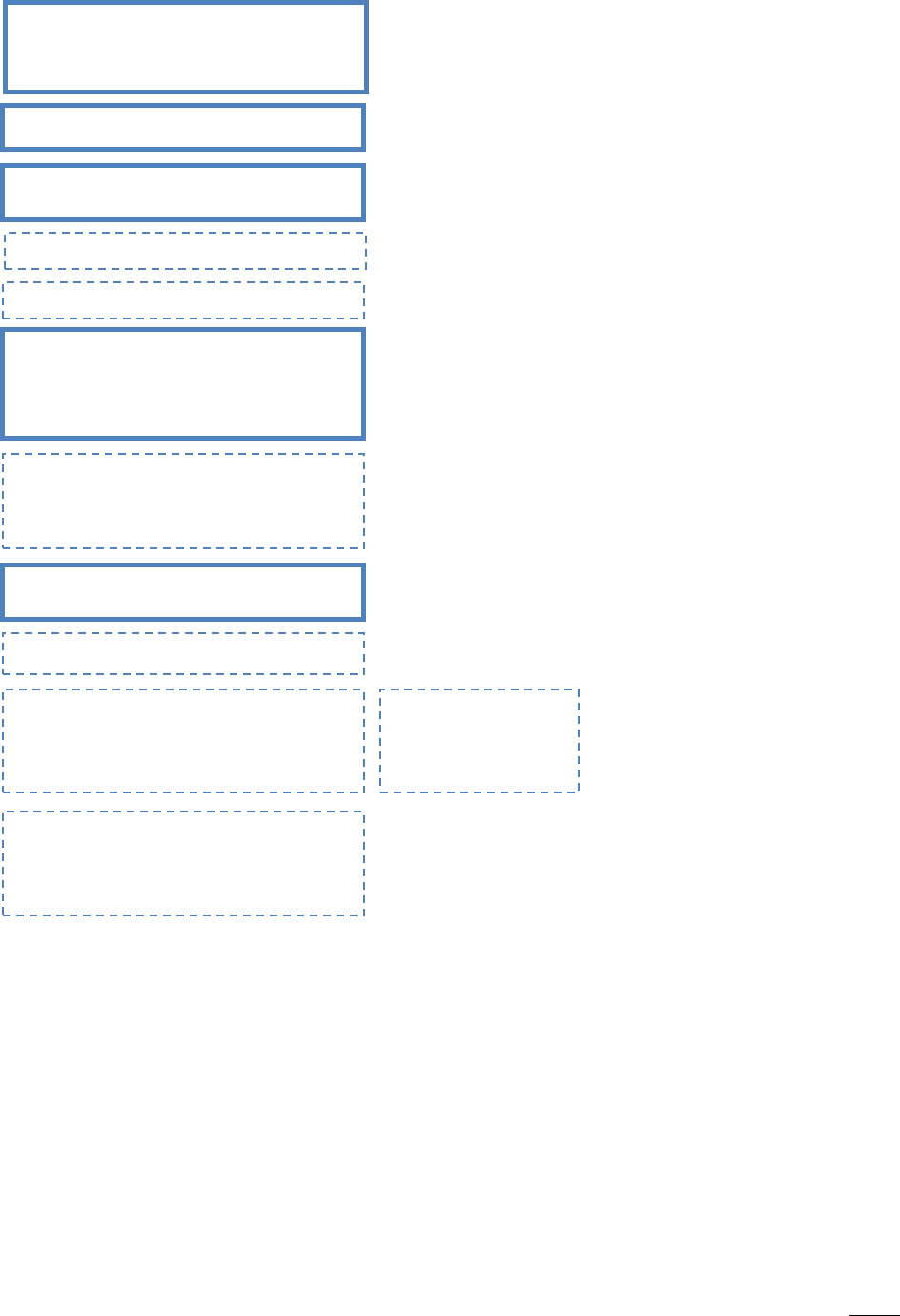
Screenpresso User Manual
Chapter
: Capture a video
37
8.7 Video capture workflow
Press the [Ctrl] + [Printscreen] key or
Workspace > Capture > record video
System tray context menu > Record video
Select the part of your screen to record
Stop recording: Press the [Printscreen]
key or
Workspace > Capture > record video
System tray context menu > Stop
The preview of the video is displayed in
the Screenpresso media player.
The Workspace window is displayed
Paste, Publish or drag&drop your video
into your application (e-mail, document,
etc…)
The Workspace
window is
automatically closed
Show/hide the webcam (Win + F7)
Zoom on a part of the screen (Win + F8)
Click on the record button
Click on the save button
The video is converted to MP4
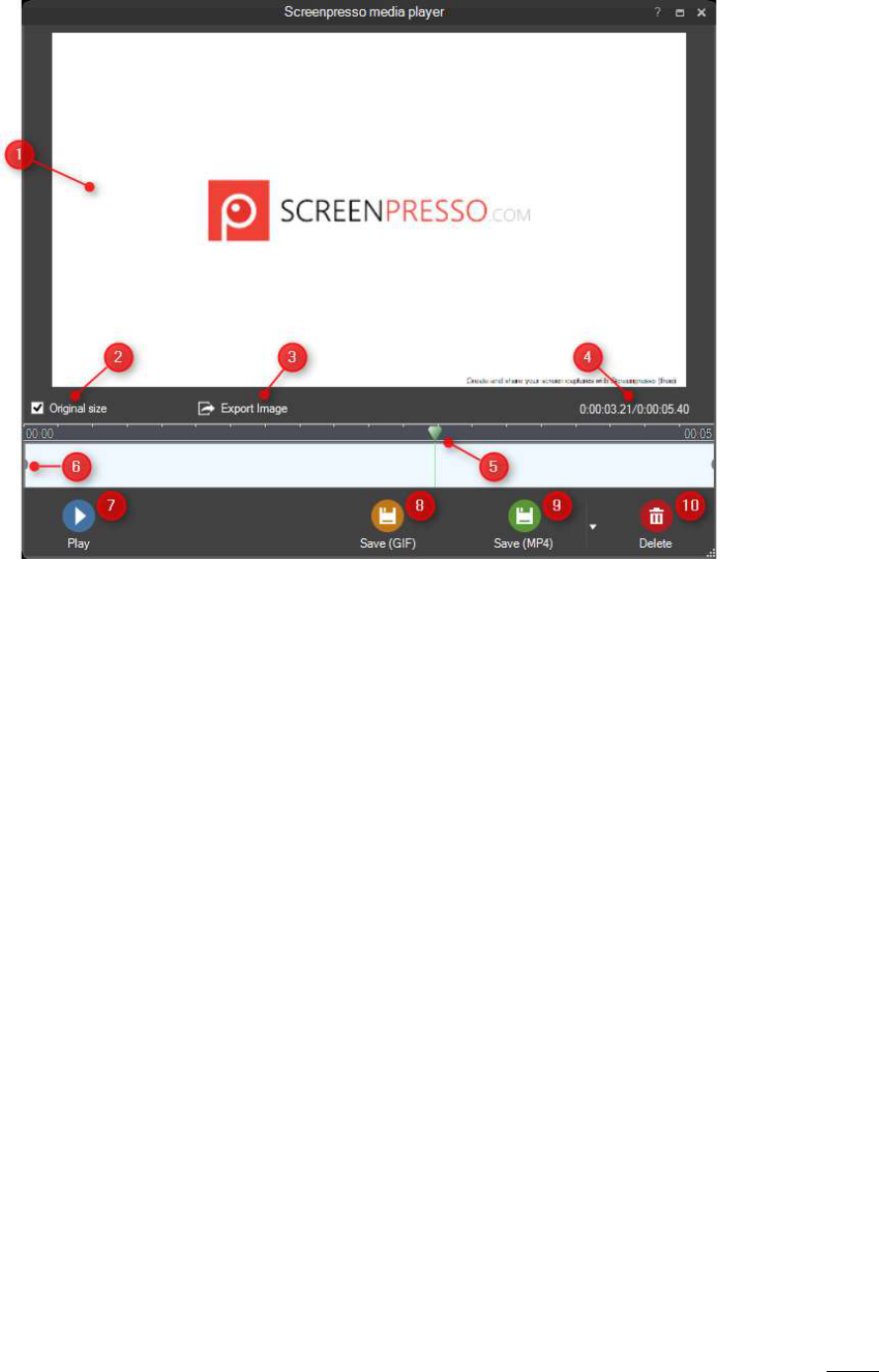
Screenpresso User Manual
Chapter
: Capture a video
38
8.8 Screenpresso media player
1) The video preview.
2) Change the preview mode: checked, the video is not resized, unchecked the video is resized to fit the
size of the preview window.
3) Export the current frame as an image. The extracted image is saved in the current workspace.
4) Current position in the video and total video length/duration.
5) The cursor of the timeline: define the current frame position in the video.
6) Resize grip. Allows clipping start and end of the video.
7) Play/Pause the preview.
8) Save recording as an animated GIF. Very useful to publish result on a Web site (notice that framerate
is reduced to avoid the output file to be too big)
9) Save recording as a standard video format. MP4 is the default but it can be changed via clicking the
small arrow to the right of the button.
10) Close window, discard recording.
Press the “Save” button to save the recorded video. The compression immediately starts according to your
settings. Default file format is MP4 (H264 video + AAC audio), which is the best format: highest compression
ratio for best quality video.
The Format menu item available to the right of the green button allows changing of the video format: MP4,
Animated GIF, Animated PNG, Animated WebP, WMV, OGV or WEBM as well as the dimension of the output
video:
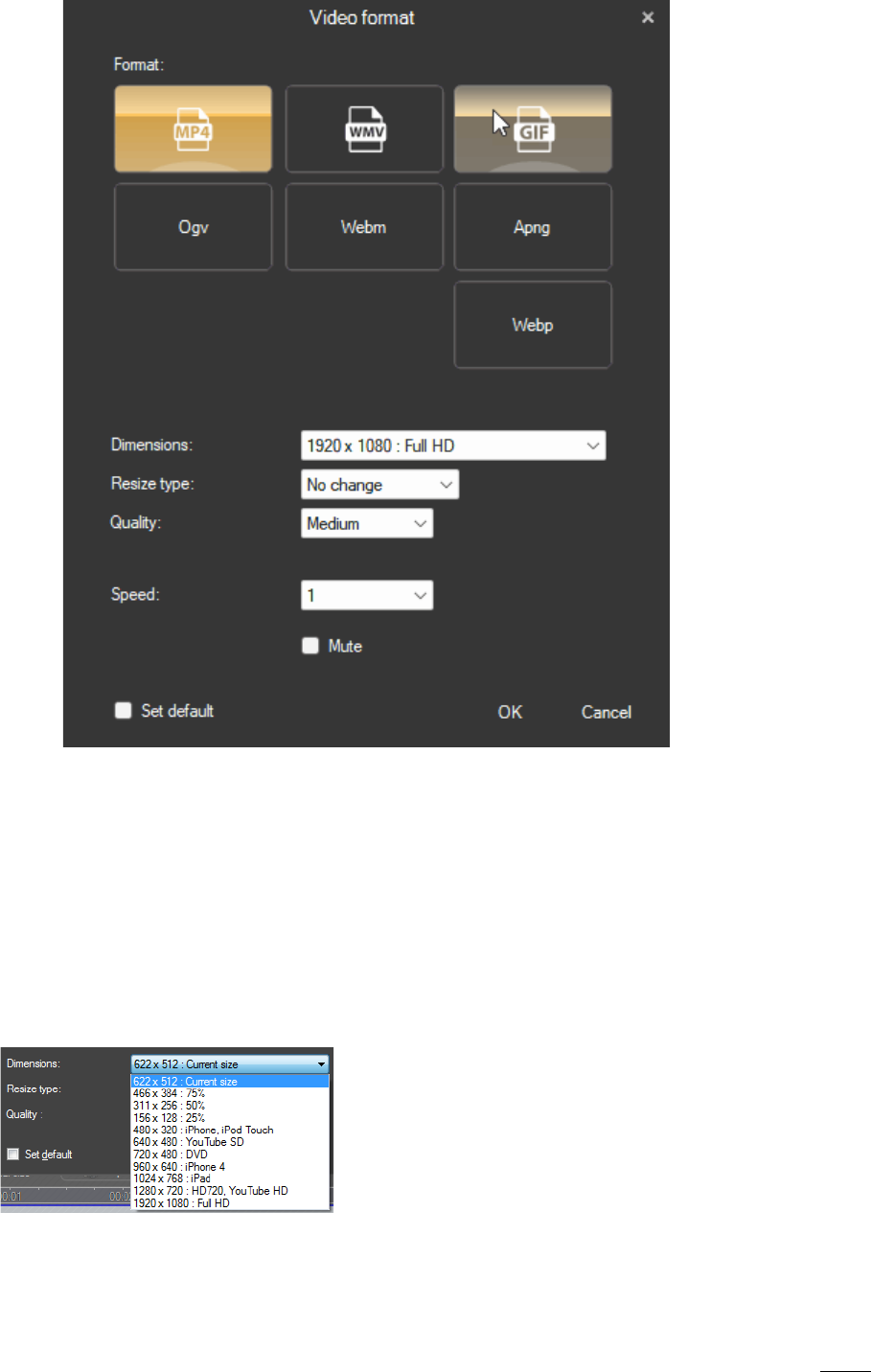
Screenpresso User Manual
Chapter
: Capture a video
39
MP4 provides a very good compression ratio and is the standard that most devices can read.
Animated GIF is a great option for sending the video via e-mail for instance or putting it on a Web site. It is
important to notice that framework is reduced to 5 images per seconds instead of 15.
Animated PNG is better quality than animated gif. It is new technology.
Wmv is the Microsoft video codec that has been supported for a long time under Windows. Use this codec if
your viewers are using Microsoft Windows and you want to make sure they will be able to read the file.
Web-M is a great codec supported by Google.
Ogv is an open-source codec.
1) Define the video format: MP4, GIF, WMV, OGV or WEBM or WEBP. MP4 is the recommended format.
2) The size of the output video among predefined sizes:
3) Define the video resize mode (ratio is always preserved)
a. Fit Max: the video is scaled to fit the target size. No padding is used so one dimension can be
smaller than the target size.
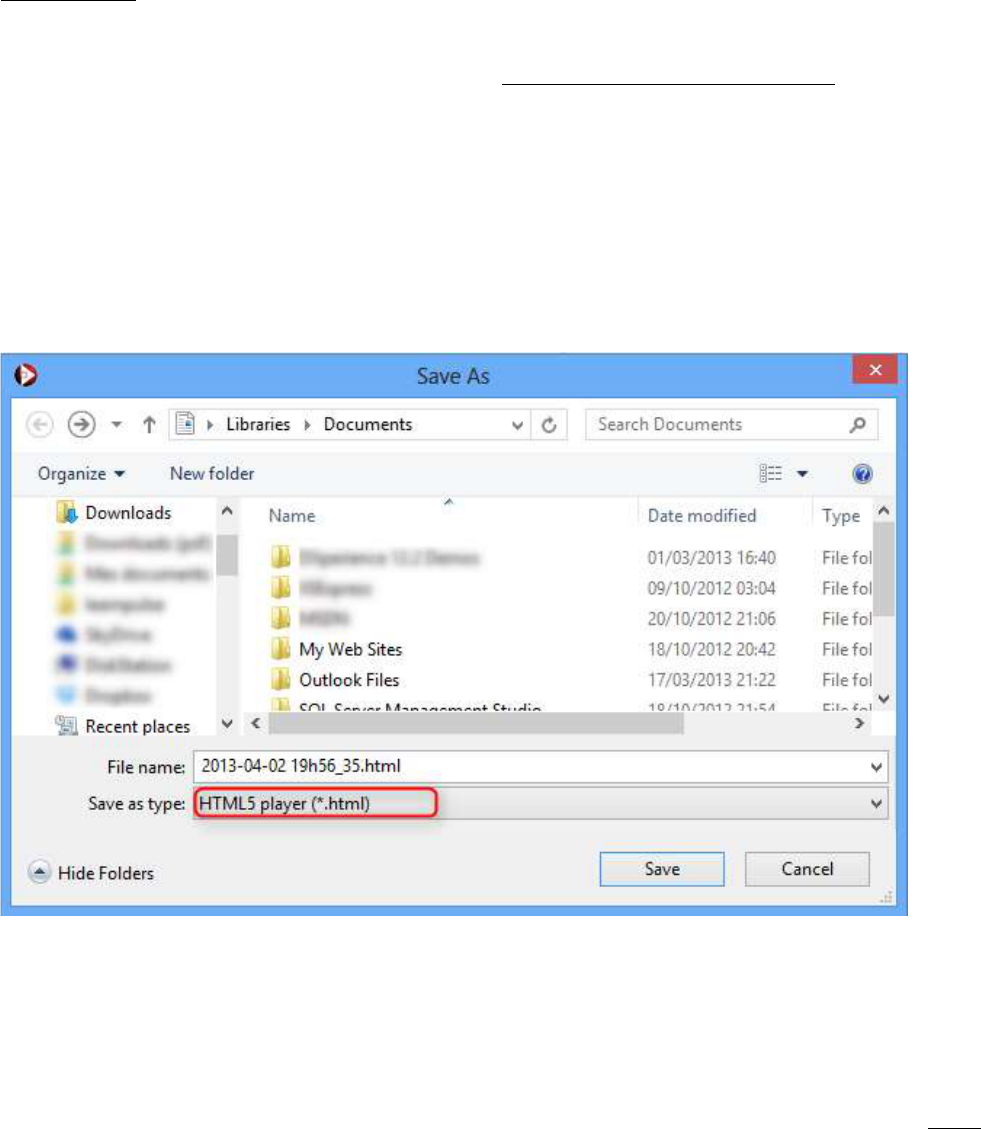
Screenpresso User Manual
Chapter
: Capture a video
40
b. Max: the video is not resized if the video is smaller than the target size; otherwise, the video
is scaled to fit the target size without padding.
c. Exact: the video is scaled to fit exactly the target size. Some black area is added to keep the
aspect ratio.
For instance, our original video is 622 x 512px, if we resize to 960 x 640px
- Max: the output will be 622 x 512px
- Fit Max: the output will be 960 x 640px
4) Define the compression quality.
5) Check this option to persist the current settings as default.
Important notes
- Screenpresso requires third-party tools: FFmpeg and LibVLC. Screenpresso will download them once
before the first conversion. An Internet connection is required for this. You can download it manually
if necessary. More information is on our online FAQ: https://www.screenpresso.com/support/
- Screenpresso captures in AVI format with its own lossless and CPU optimized codec and will then
convert the video to MP4 after the capture. The video codec used for recording is fully configurable via
settings
8.9 Convert video to another format
The original video capture is always kept by Screenpresso. This allows you to convert as many times as required
without decreasing the quality.
Many video formats are supported but it is also possible to generate a HTML Web page. To do so, select a video
in the Screenpresso workspace, right-click on it, then choose “Save as”.
It will generate a HTML 5 file, a folder containing all images and a flash player to be used if necessary and video
file. The generated Web page automatically detects supported Web browser’s features to correctly display the
video.
8.10 Recording limitation
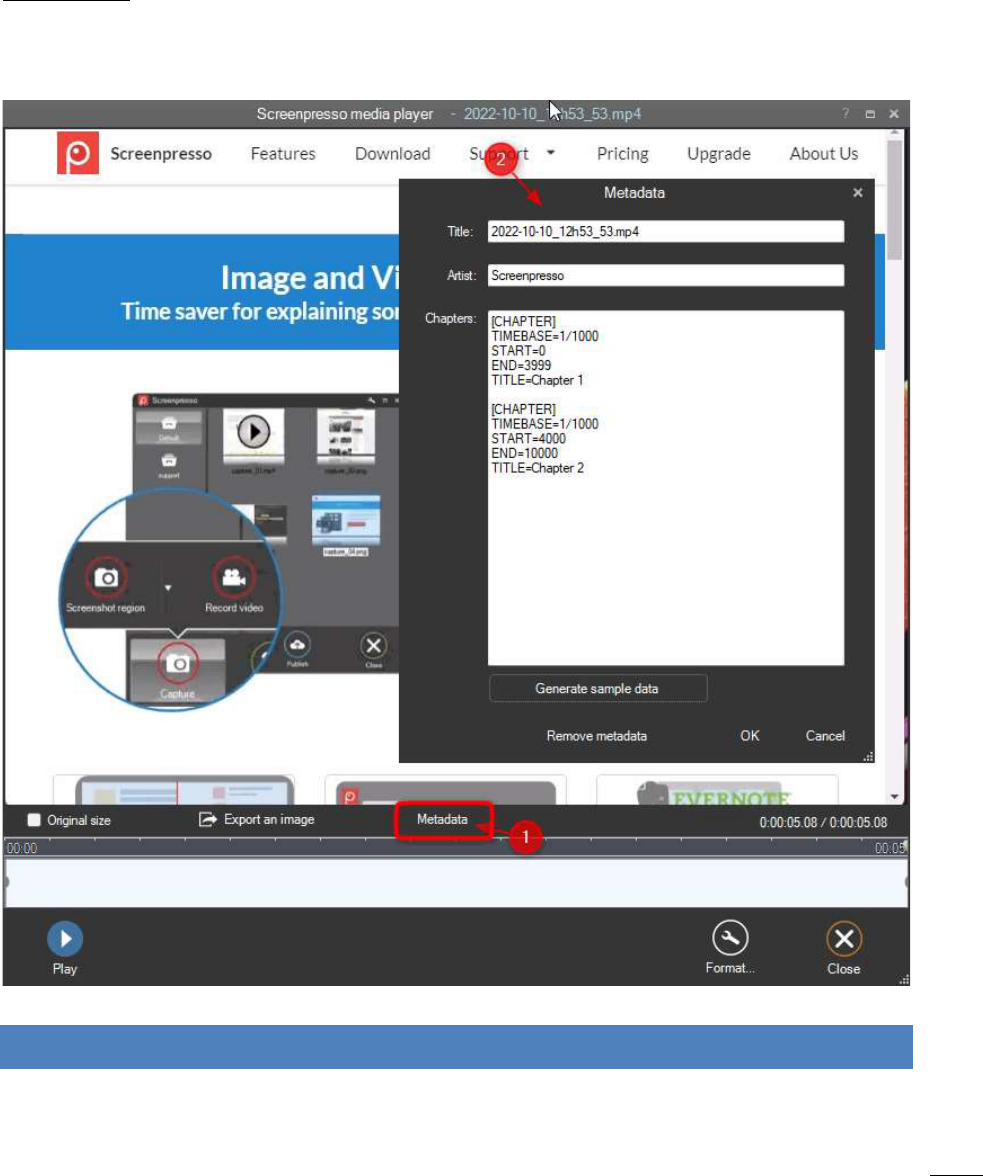
Screenpresso User Manual
Chapter
: Android center
41
Screenpresso video codec is optimized to record working activity on the screen. It is not made to record videos.
AVI standard is limited to 2GB file size. When the file becomes too large during recording, Screenpresso
generates more than one AVI file.
8.11 Merging videos (PRO)
Screenpresso provides a merging utility for being able to publish one video file instead of multiple files. In
Screenpresso workspace, select your videos, right-click on one then choose “Merge videos” menu item.
Important note
• All files must have same resolution and must be compressed using the same codec.
8.12 Edit video metadata (PRO)
9 Android center
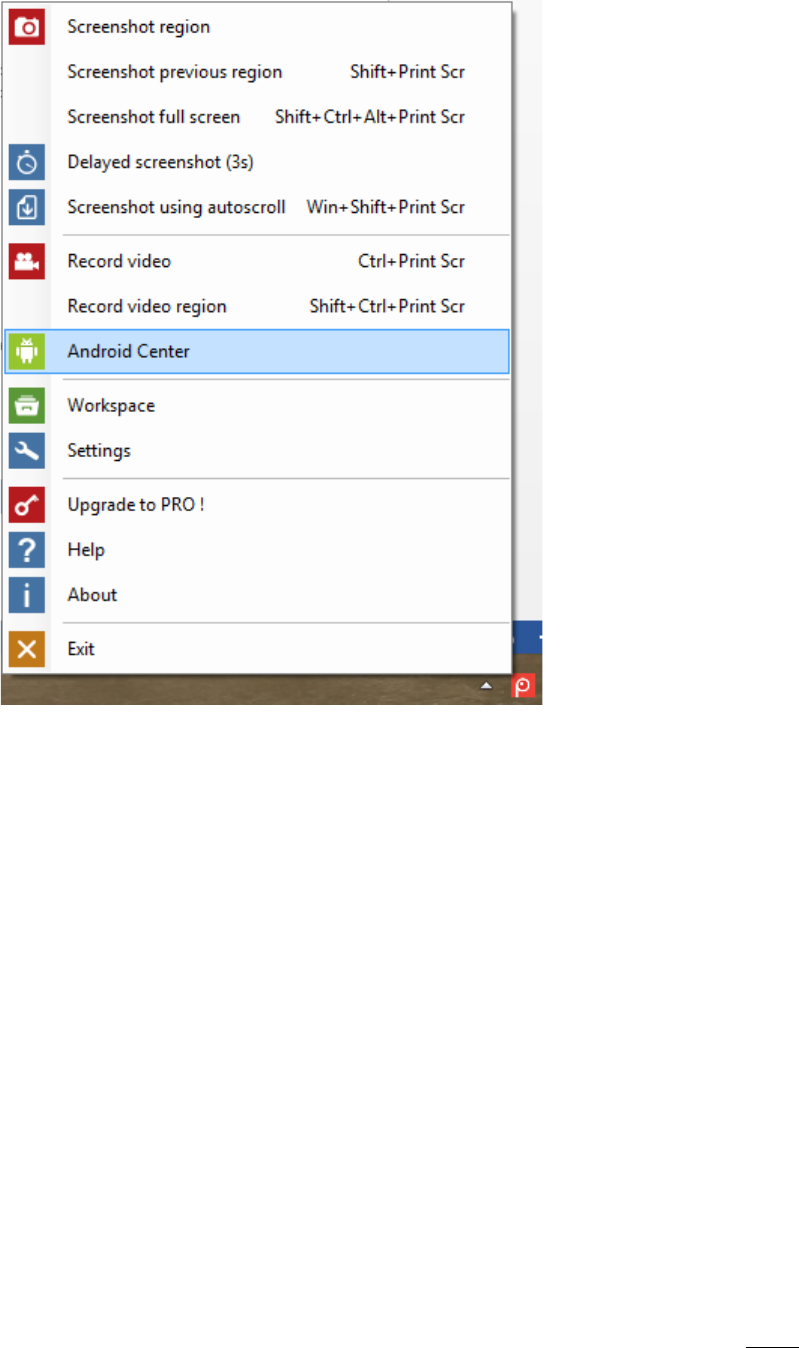
Screenpresso User Manual
Chapter
: Android center
42
Thanks to Android Debug Bridge (ADB), software officially published by Google, Screenpresso can take captures
on your android device running Android 4.4 or above. To open “Android Center” window, use system tray
menu:
9.1 Install ADB
Screenpresso needs ADB software. It will search it:
• Next to the exe
• Next to the exe, in a sub-folder named “Android”
• In %LocalAppData%\Learnpulse\Screenpresso\Android
• In %ANDROID_SDK_HOME%\platform-tools
If not found a Window will popup allowing you to download and install it in
%LocalAppData%\Learnpulse\Screenpresso\Android
9.2 Configure your device
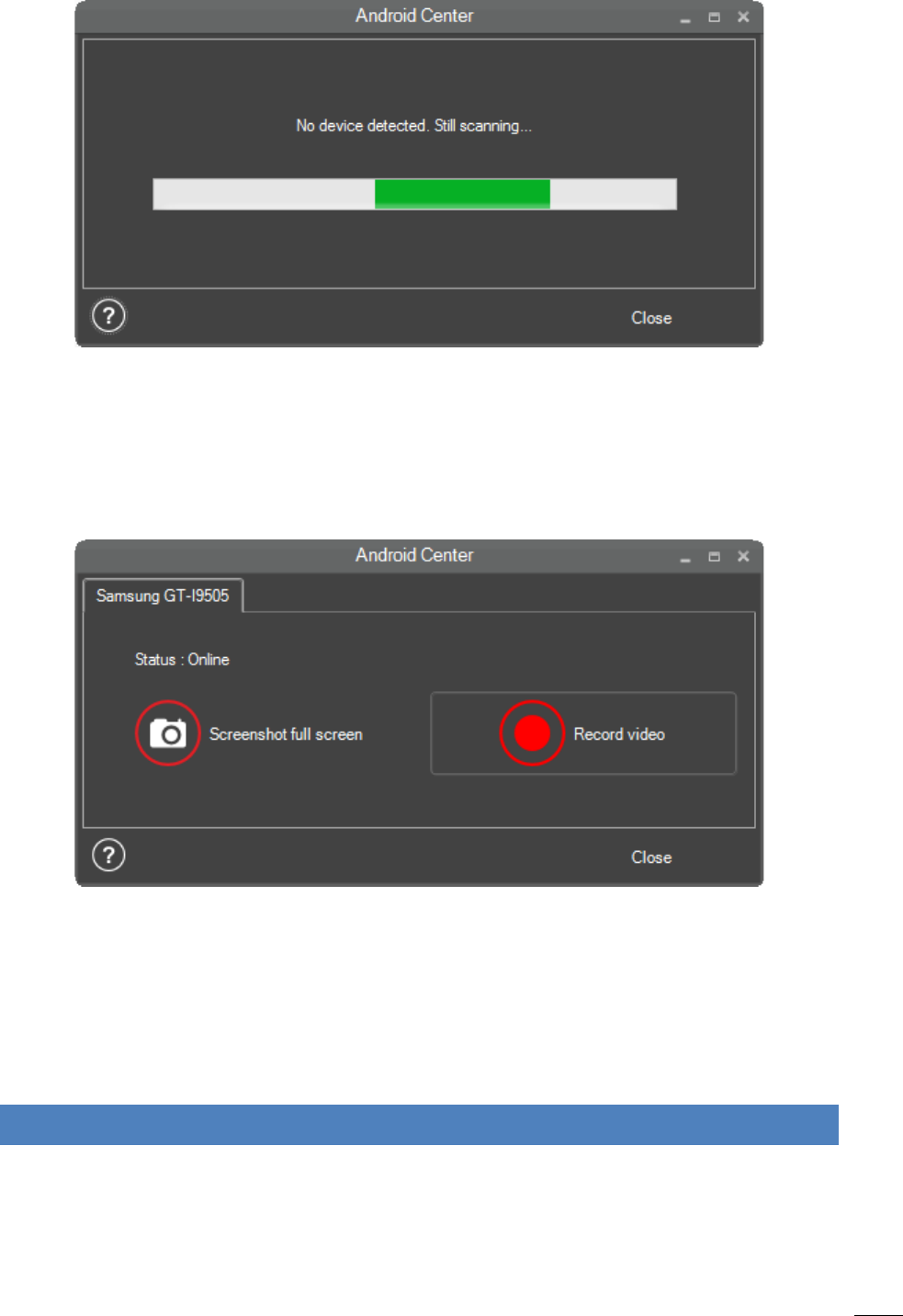
Screenpresso User Manual
Chapter
: Workspace window
43
Your device (mobile phone or tablet) needs to be configured to allow captures. Press the help button at the
bottom left of the window read the tutorial. If you need some more information, search over the Web how to
enable debug mode for your device.
When in debug mode and linked to your computer using an USB cable, your device should appear in Android
Center window.
9.3 Take captures
Screenpresso can recognize more than one device connected at once. Select the correct device in the tabs at th
top of the Window. If your device is disconnected, the buttons are disabled until reconnected.
Press “Screenshot full screen” to take a screen capture (make sure your device’s screen displays what you want
to capture).
Press “Record video” to make a screen recording. Recording’s max duration is 3 minutes and will generate a
MP4 file. Issues might sometime occur if your recording is less than 10 seconds. Press “Stop” to stop video
recording.
10 Workspace window
10.1 Overview
This is the main Screenpresso window and it is displayed:
• When Screenpresso starts;
• using [Win] + [Print Screen] shortcut;
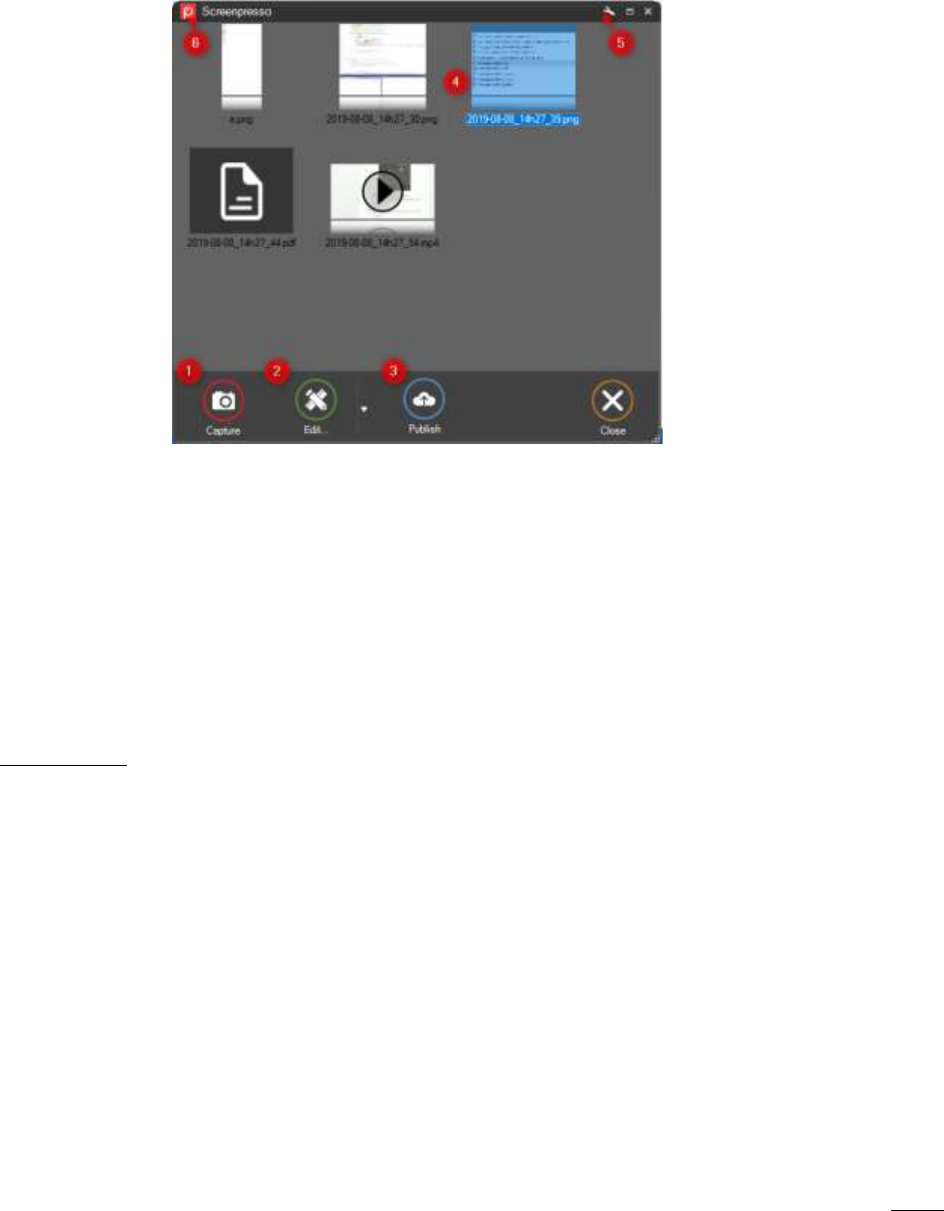
Screenpresso User Manual
Chapter
: Workspace window
44
• using a single click on Screenpresso icon in the system tray (usually at the bottom right of the screen);
• after a capture is performed (can be disabled via settings);
• when you start Screenpresso when another instance is already running.
The workspace window displays all captures stored in the Screenpresso working folder (refer to section 6.2)
and provides some direct-action buttons.
Main features:
Figure 15 : Workspace window
1) Perform a new capture (image or video)
2) Edit the selected capture using the built-in editor or third party editors,
or generate a new document (available when multiple images are selected)
3) Publish the selected captures: refer to dedicated section
4) The captures (images and videos), support the drag & drop as well as the copy/paste. Right click on a
file selection to obtain all the context actions
5) Open Screenpresso settings
6) Show or hide the other workspaces
Important note
- The window is optimized to handle thousands of images but opening the window will be slower when
using more than 5000 images.

Screenpresso User Manual
Chapter
: Workspace window
45
10.2 Filter
The workspace features a filter to find some media and hide the other ones. First click on a file in the
workspace to give it the focus, then start typing your search criteria (pressing Ctrl+F is optional). The
corresponding files are displayed, and the other ones are hidden. Press Escape key to close the feature.
10.3 Drag & Drop
This window fully supports drag and drop and can be used to copy a capture to your desktop, to one of your
existing folders or to attach it to an e-mail.
Figure 16 : Example of drag & drop in Gmail
Important note
If you hold shift key before starting dragging the media, the corresponding “.presso” file is dragged instead of
the image itself.
10.4 Auto clean-up of files
By default, the workspace keeps only the 30 newest captures and deletes the old ones (they are moved to the
recycle bin).
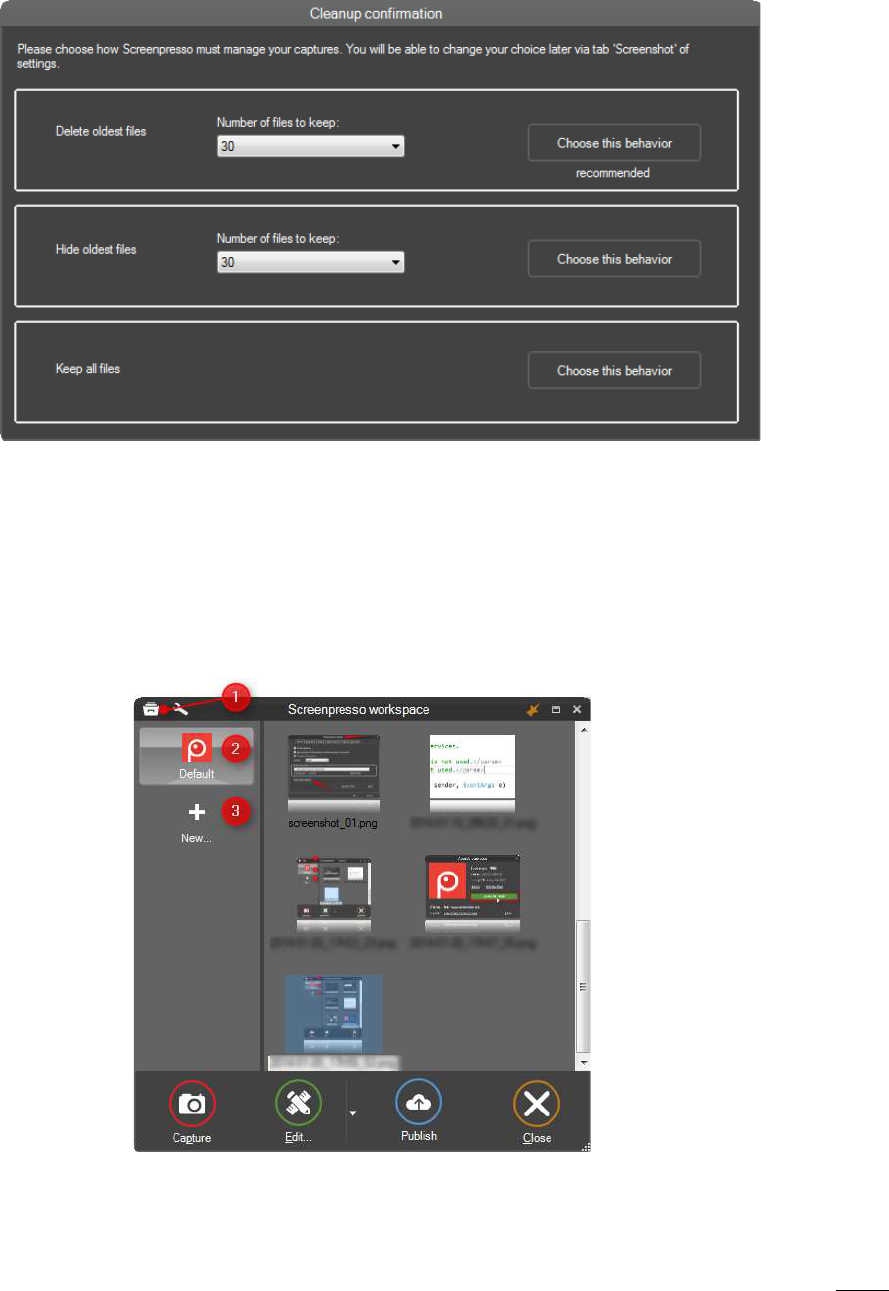
Screenpresso User Manual
Chapter
: Workspace window
46
A popup will warn you after several captures to allow you to select the file management behavior:
- Auto clean-up and setup the number of files to keep (oldest files are deleted);
- Keep all files (never delete files) but the workspace will only display a subset (the new file) for
performance reasons.
Please notice this occurs only on the “Default” workspace and not on the other ones (refer to chapter about
workspaces management).
10.5 Workspaces management
A workspace is a folder where your media (images, videos or documents) are stored. You can create multiple
workspaces in addition to the default one to classify your media, for instance one for personal screenshots and
one for professional screenshots.
Figure 17 : Several workspaces
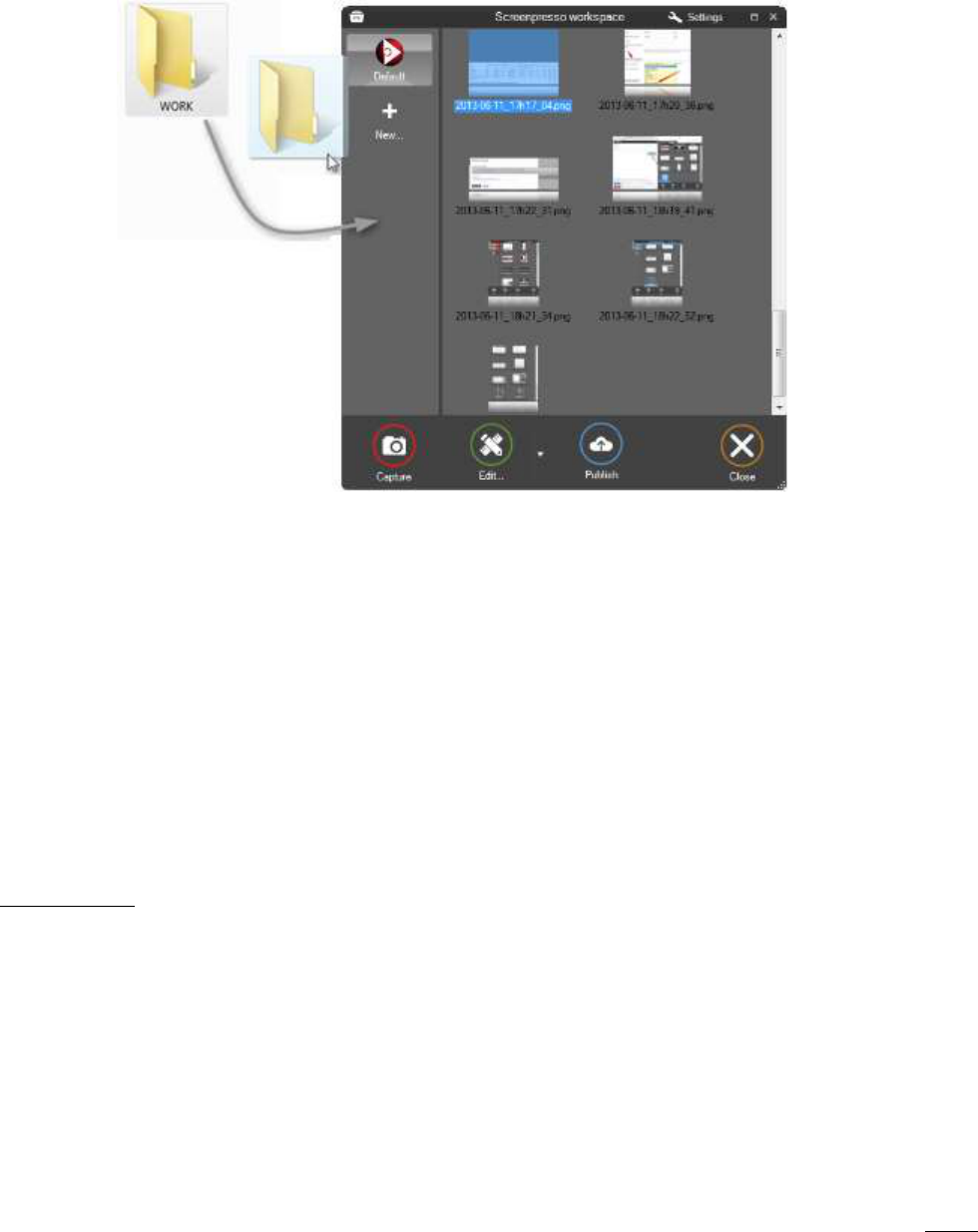
Screenpresso User Manual
Chapter
: Workspace window
47
1) Click once on the arrow at the top-left of the workspace window to toggle the display in the
workspaces list (or press F10)
2) The currently selected workspace is highlighted
3) Click to create a new workspace (a new folder on your disk), a prompt will ask for a name. A sub-folder
is then created in the Screenpresso working folder.
You can also drag & drop an existing folder from your hard drive disk:
Figure 18 : Drag & drop to create a new workspace
In this case no sub-folder named “Screenpresso” is created.
You can right-click on a workspace button to display its context menu:
• “Open folder”: browse corresponding folder in Windows’ file explorer.
• “Delete”: removes workspace from workspaces list. If you also want to delete the folder from your
disk, check the “Delete all files from disk” checkbox.
• “Properties…”: open a window to rename the workspace, change its icon or change synchronization
setting (see 10.5).
To change the order of the displayed workspaces, select one workspace to move then press Control+Up or
Control+Down keys.
Important notes
- The “Default” workspace always exists, refer to section 6.2
- When a new capture is created, the new file is moved to selected workspace
- Unlike the “Default” workspace, the other workspaces have no automatic cleanup of files (number of
files is unlimited) and do not create a subfolder named “Screenpresso”
10.6 Collaborative work
A workspace can be linked with an online Cloud service to synchronize local files with remote files.
10.6.1 Synchronization with Dropbox, Google Drive or Microsoft OneDrive
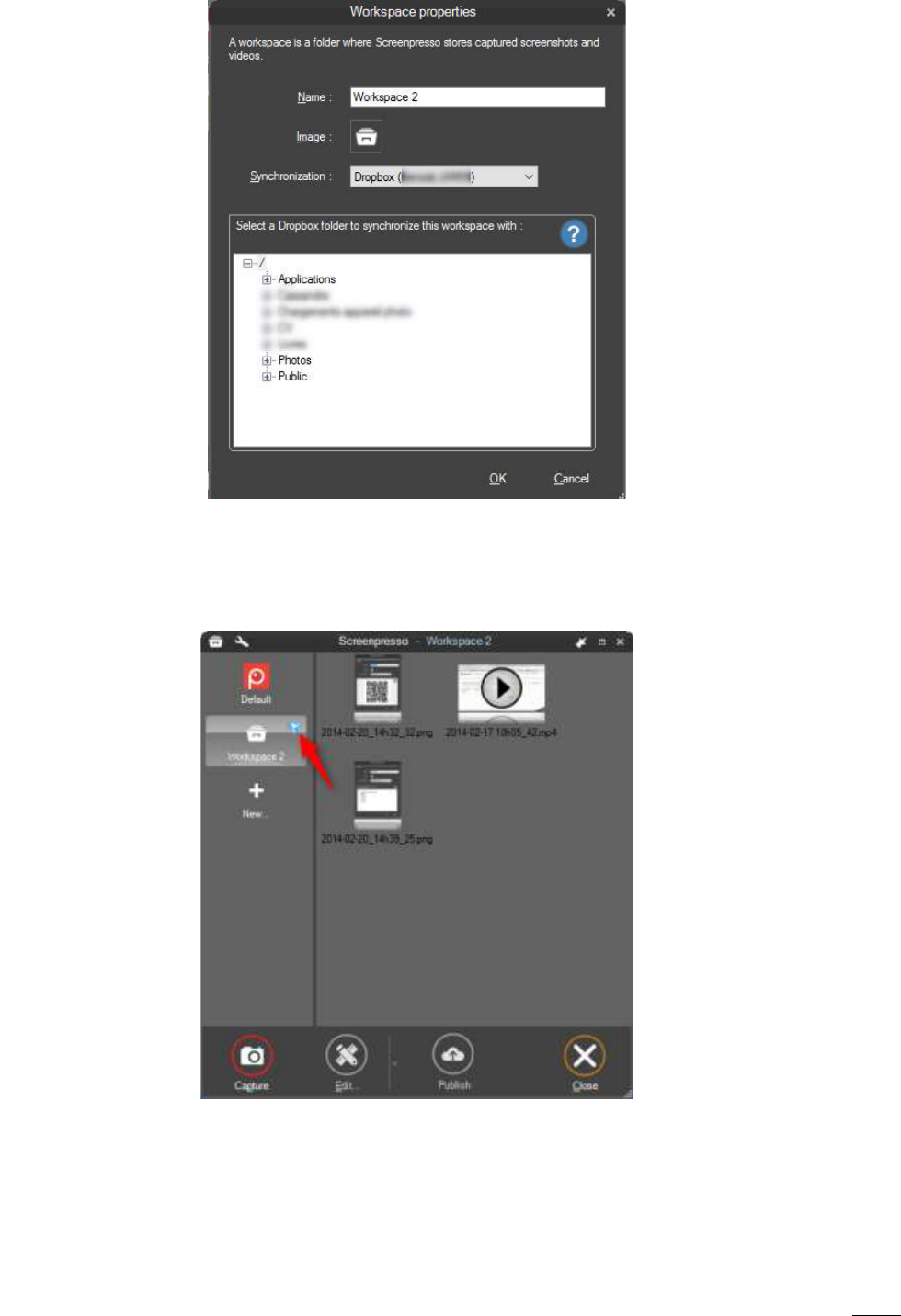
Screenpresso User Manual
Chapter
: Workspace window
48
This feature allows synchronization between Dropbox, Google Drive or Microsoft OneDrive and the workspace.
That’s great for collaborative work if you have shared your remote folder with other people.
1- Select a remote folder to synchronize with
2- Click the small Dropbox, Drive or OneDrive logo (at the left-hand side of the workspace window) to
perform a synchronization
3- Medias are synchronized.
Important note
- Remote files always have priority over local files. If you have made local modifications and remote file
has also been modified (by someone else for instance), synchronization with discard your local
changes.
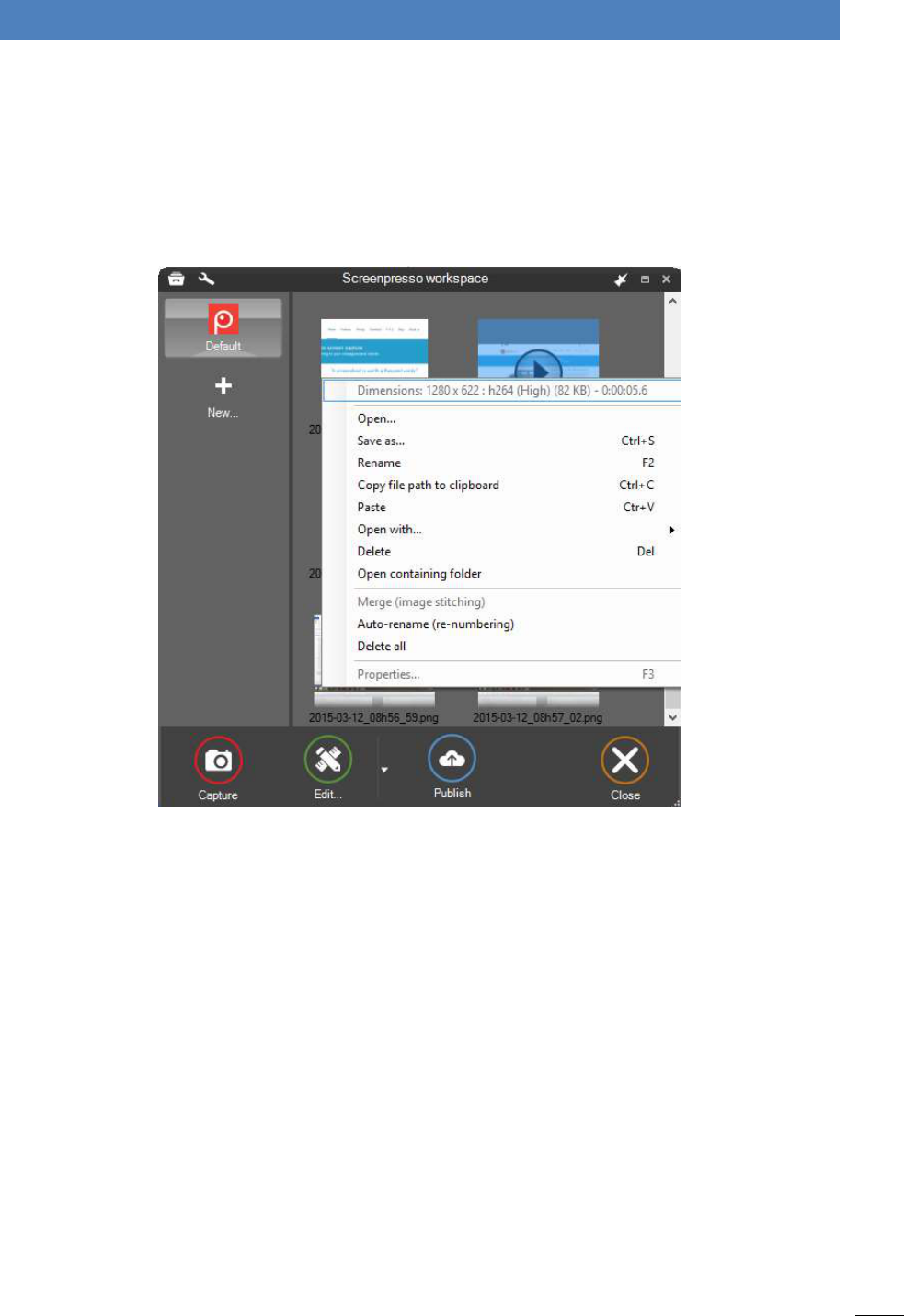
Screenpresso User Manual
Chapter
: Managing files
49
11 Managing files
The Screenpresso workspace window provides a lot of options to easily manage your media (we term the
individual images or videos as “media”).
11.1 File management
At any times you can right-click a media to display a context menu. The menu displays the files’ information
(format and size) followed by actions:
Figure 19 : Video context menu
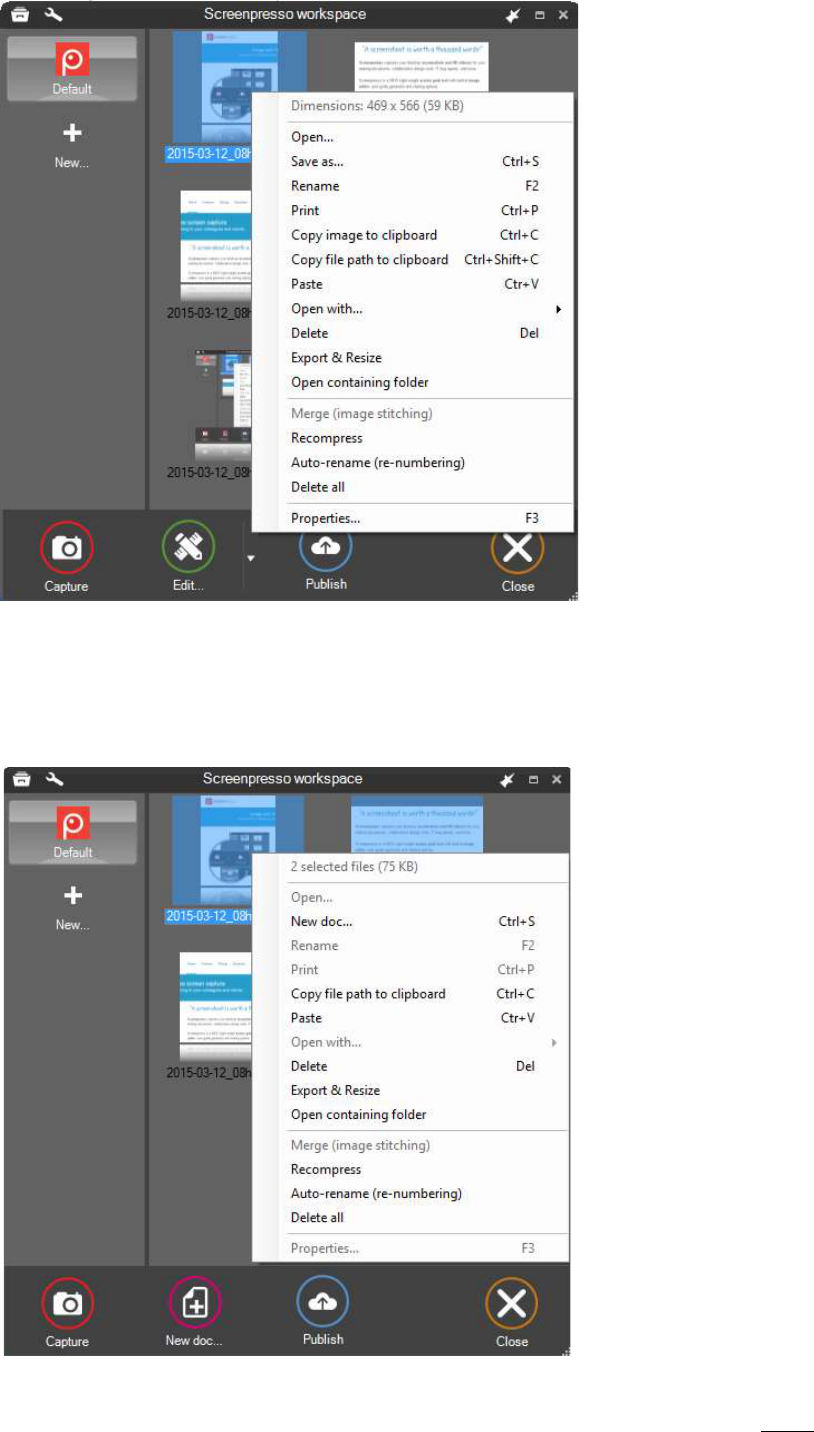
Screenpresso User Manual
Chapter
: Managing files
50
Figure 20 : Image context menu
- Save As… allows you to save your image in a lot of different formats: PNG, JPEG, GIF, TIFF, BMP,
WebP, JPEG XL, PDF, DOCX.
- Open with… allows you to open the file with an external software. You can also use Ctrl+Alt+<num
key> shortcut. <num kye> is the index of the software has it appear in the menu
Figure 21 : Multiple files context menu
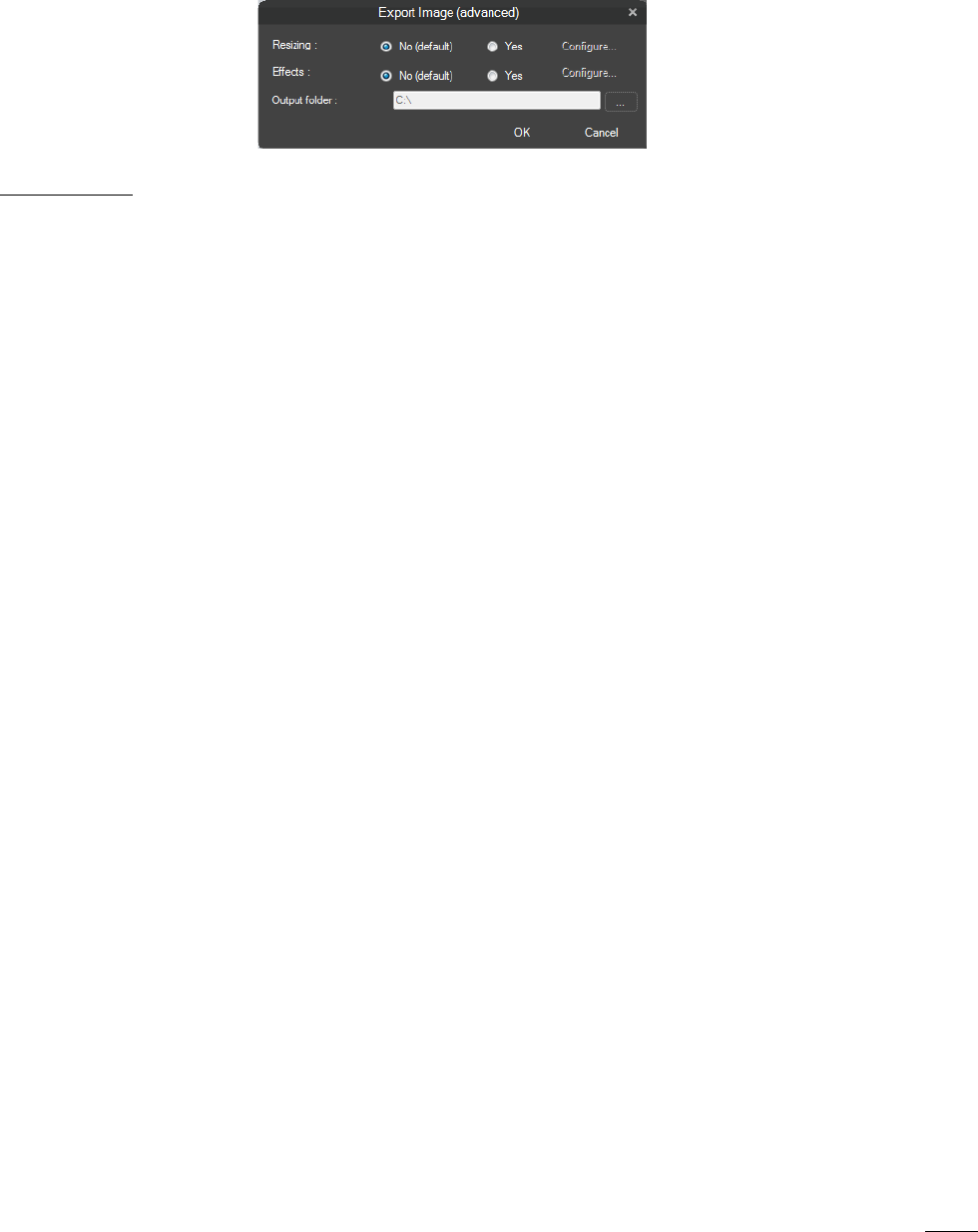
Screenpresso User Manual
Chapter
: Managing files
51
- Open in quick view displays currently selected image in a border less top most window. Press space or
right-click on the quick view window to close it.
- Merge (image stitching): stitch several images that have the same dimensions into 1 big image.
Holding Control key may stich them horizontally instead of vertically.
- Recompress: use a specialized algorithm to increase the compression ratio of selected images.
- Auto-rename (re-numbering) is a quick function that renames your selected images “screenshot_1”,
“screenshot_2”, etc.…Export and Resize: this is a batch resize and effect:
Figure 22: Batch resizing and effects
Important note:
- Paste is available in all context menus: you can paste images from the clipboard into the workspace.
- The workspace window is built to support thousands of media without affecting speed and memory.
11.1.1 Deleting a media
To delete a media, select it then press the “Del” key or right-click on it, then choose “Delete” from the menu.
You can select multiple files by clicking on the files while holding the control key.
By default, a deleted file is moved to the recycle bin. The file itself is deleted but also its corresponding files
that are stored in “Thumbnails” and “Originals” folders.
If you delete the file using Windows’ file explorer, close and reopen the workspace window so that it is
refreshed.
11.1.2 Renaming a media
You can rename a media by:
• clicking twice slowly on the file name;
• pressing F2 shortcut;
• right-click and choose “Rename” from the menu.
Renaming an image with its file extension can be used to change the image format
When you rename a media item, the corresponding filename is changed on the disk. If you don’t specify the file
extension (.png for instance) then the current file format is kept. If you specify a file extension, the media is
converted. For instance, if you rename “screenshot.png” to “screenshot.jpg”, Screenpresso does not only
modify the file name, but also converts the file to a real jpg file. To copy your media and convert it, you can also
right-click on the file then choose “Save as…” from the menu.
11.1.3 Moving a media to another workspace
At any time, you can click on the workspaces list then drag and drop your media from one workspace to
another.
To retrieve the media in Windows’ file explorer, you can right-click on it, then choose “Open containing folder”
from the menu.
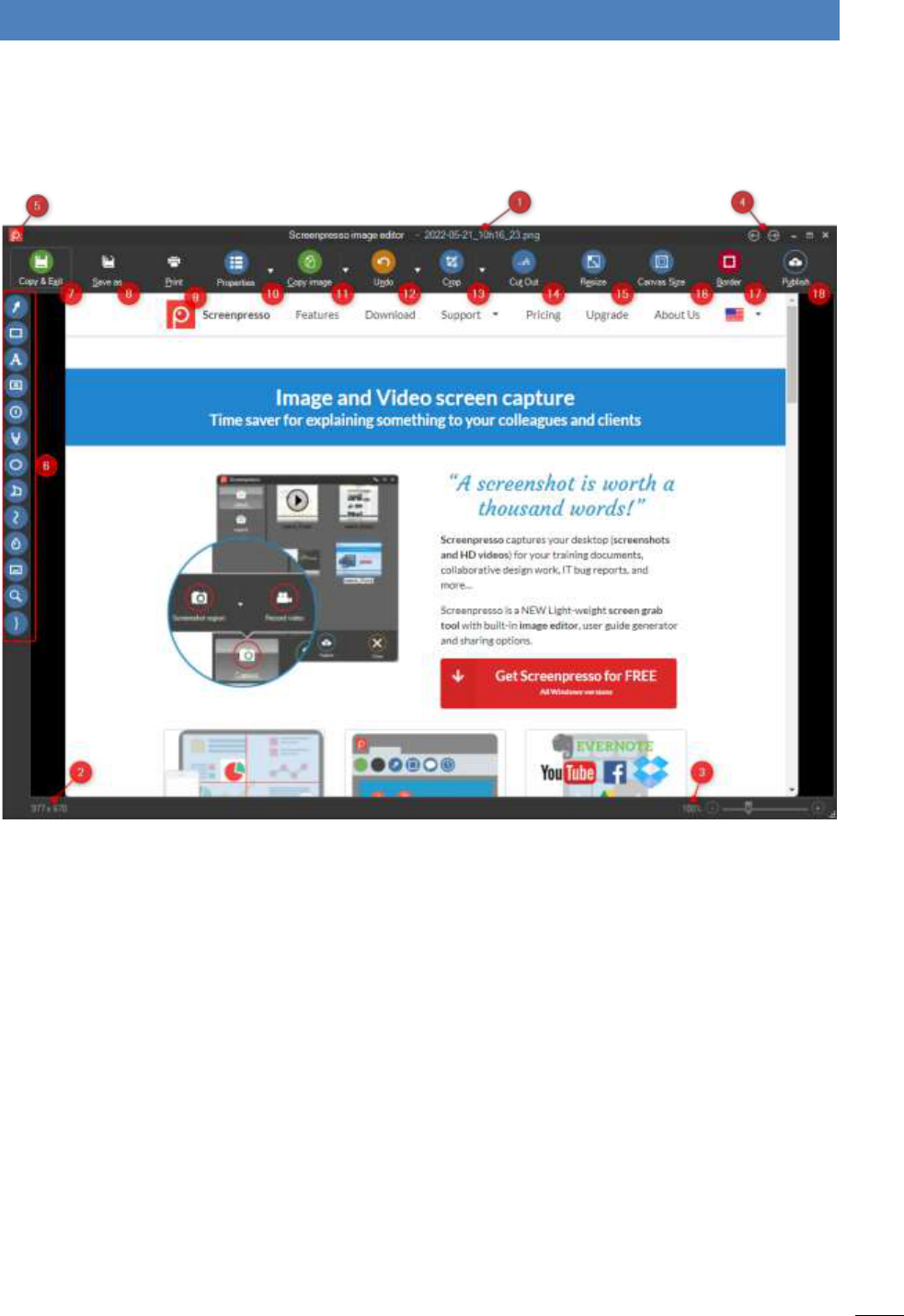
Screenpresso User Manual
Chapter
: Editing an image
53
12 Editing an image
Screenpresso provides a built-in vector image editor to add annotations, effects, resize and more.
Double-click on an image in the Screenpresso’s workspace to open the editor or click on the Edit button.
12.1 Main tab
1) The name of the current image
2) The dimension of the current image (width x height in pixels)
3) The zoom factor cursor
4) Opens the previous or next image from the current workspace.
Shortcuts are PageUp and PageDown keys
If you hold Alt and Shift key while clicking one of these two buttons, the current image will be deleted
before moving to the new one.
5) Main menu button
Contains some rarely used feature
6) The drawing tools
7) This button is very helpful as it:
a. Saves the modifications to the current image;
b. Closes the editor;
c. Places the image on the clipboard.
8) Opens the Save as... dialog
9) Prints the current image
10) Opens the image’s metadata editor
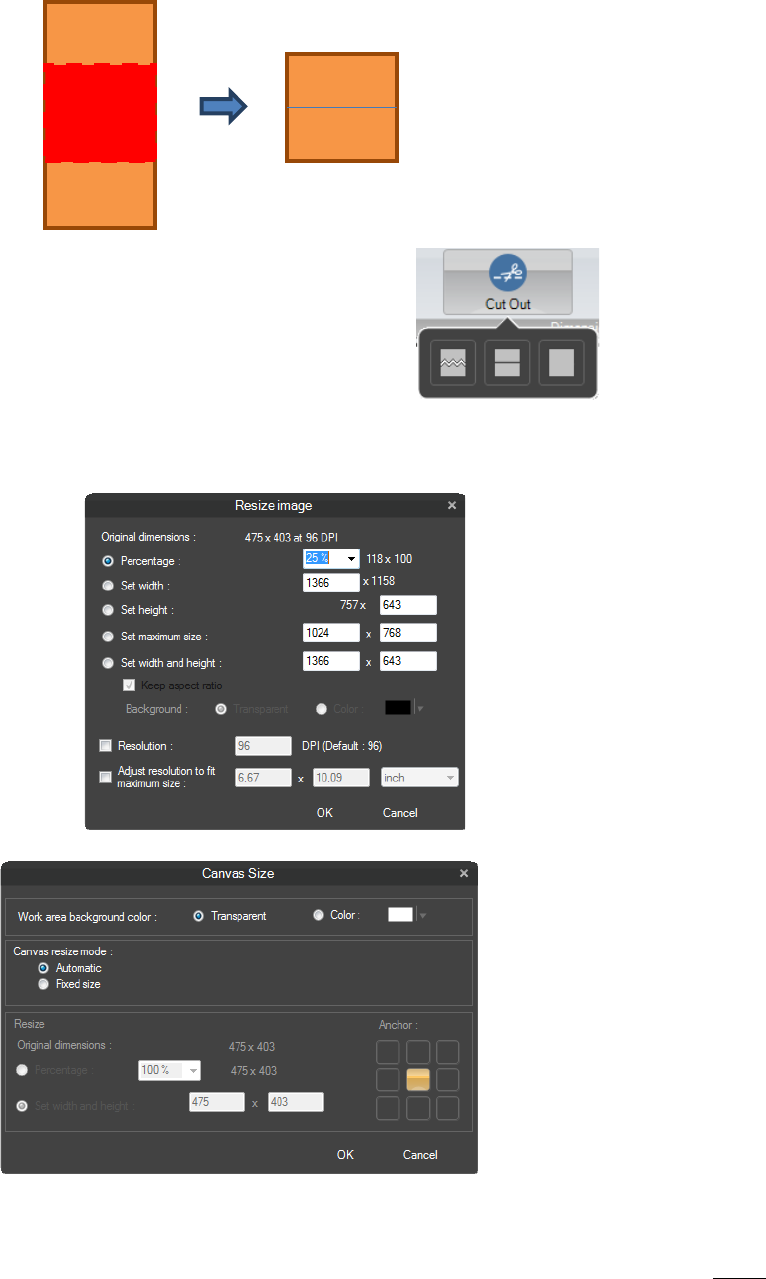
Screenpresso User Manual
Chapter
: Editing an image
54
11) Copies the current image to the clipboard
12) Undo and redo the last modifications
13) Crop tool to redefine the image. Also allows to rotate the image
14) Cut out: this tool is used to remove part of the screenshot. For instance, you have a very long image
like this and you would like to remove the middle part:
There are several options, depending on the type of line between (1) and (2):
15) Resize: this dialog provides many ways to resize your image:
16) Canvas size: Define the working area:
You can define a fixed or an automatic canvas size (recommended) as well as the background color.
1
2
1
2

Screenpresso User Manual
Chapter
: Editing an image
55
If you choose automatic canvas size, when you move a drawing item or an image outside the canvas, it will
automatically be resized:
➔
17) Border: tool to add image border and effects to your screenshot:
Basically, you can add:
- Regular Border (square)
- Round border
- Torn edge, for instance:
- Refection:
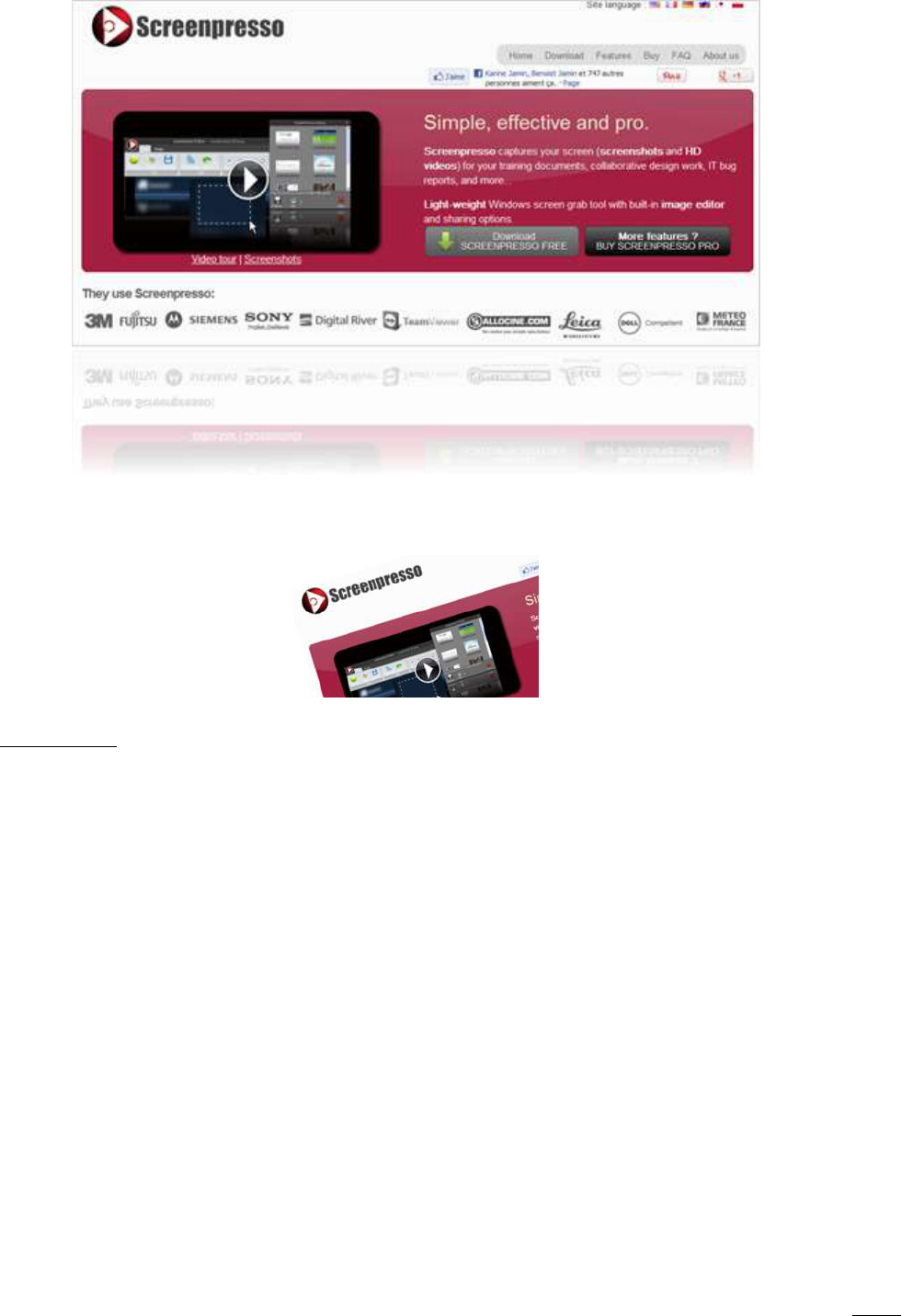
Screenpresso User Manual
Chapter
: Editing an image
56
- Drop shadow
- Switch your color image to greyscale
- Rotation, for instance:
Important note
18) To turn off an effect, set the corresponding parameter to its minimum value
12.2 Using the drawing tools
a. To draw a new item: select the drawing tool, for instance “Rectangle”;
b. Use the mouse to position and size the drawing item (like drawing using a selection box)
i. To draw using the same color than the background, hold Alt key
ii. To hide part of the background, choose a rectangle tool then hold both Alt and
Control keys
iii. To adjust the drawing options, right click > Drawing options or put your mouse
cursor on the orange handle or double-click it
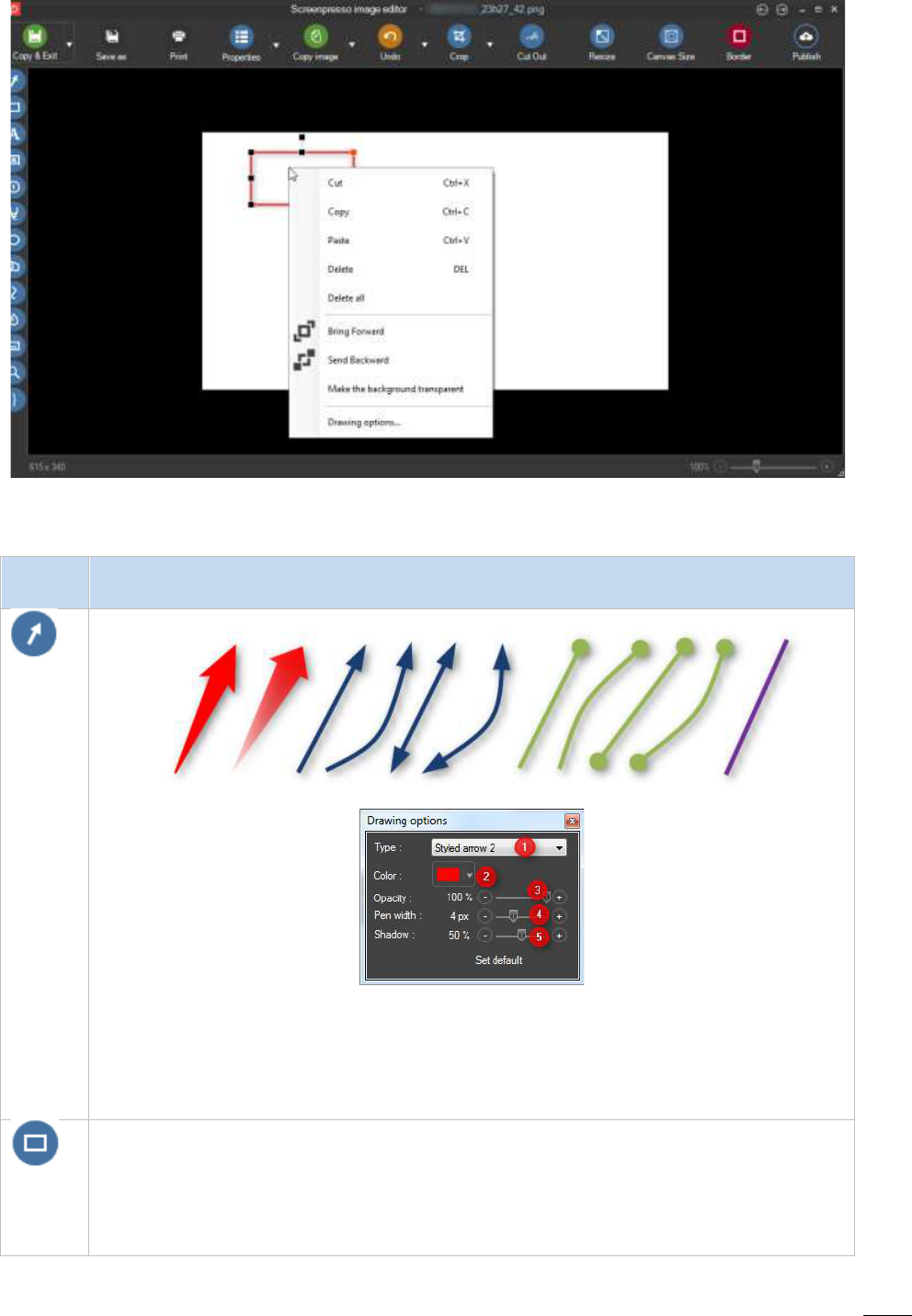
Screenpresso User Manual
Chapter
: Editing an image
57
Drawing
tool
Description
This tool is used to draw different types of arrows. For instance:
The drawing options:
1) The type of the arrow
2) The color of the arrow
3) The transparency: 100% is opaque, 0% is transparent
4) The pen width
5) The drop shadows
This tool is used to draw rectangles with round or squared borders.
Most of the time this tool is used to highlight a part of a screenshot. For instance, you can draw a
red rectangle around a part of a screenshot to indicate where it has been clicked.
The drawing options:
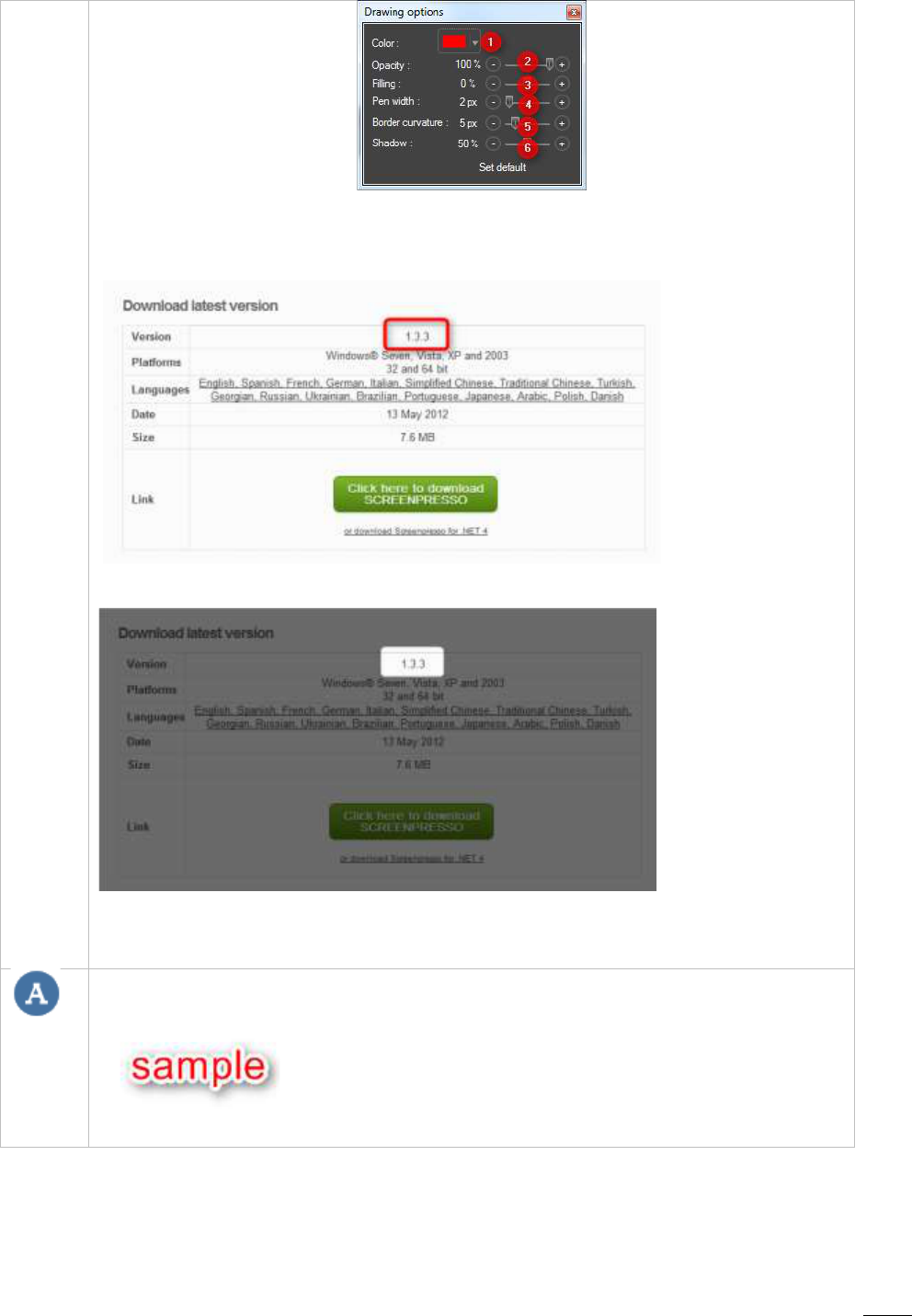
Screenpresso User Manual
Chapter
: Editing an image
58
1) The color of the rectangle
2) The opacity of the rectangle
3) The filling: changing the value to have either:
or:
4) The pen width
5) The border curvature, 0px for a rectangle and positive value for round rectangle.
This tool is used to add a text area in the image. FYI : We can set a white border around the text to
distinguish the text over the screenshot:
Drawing options:
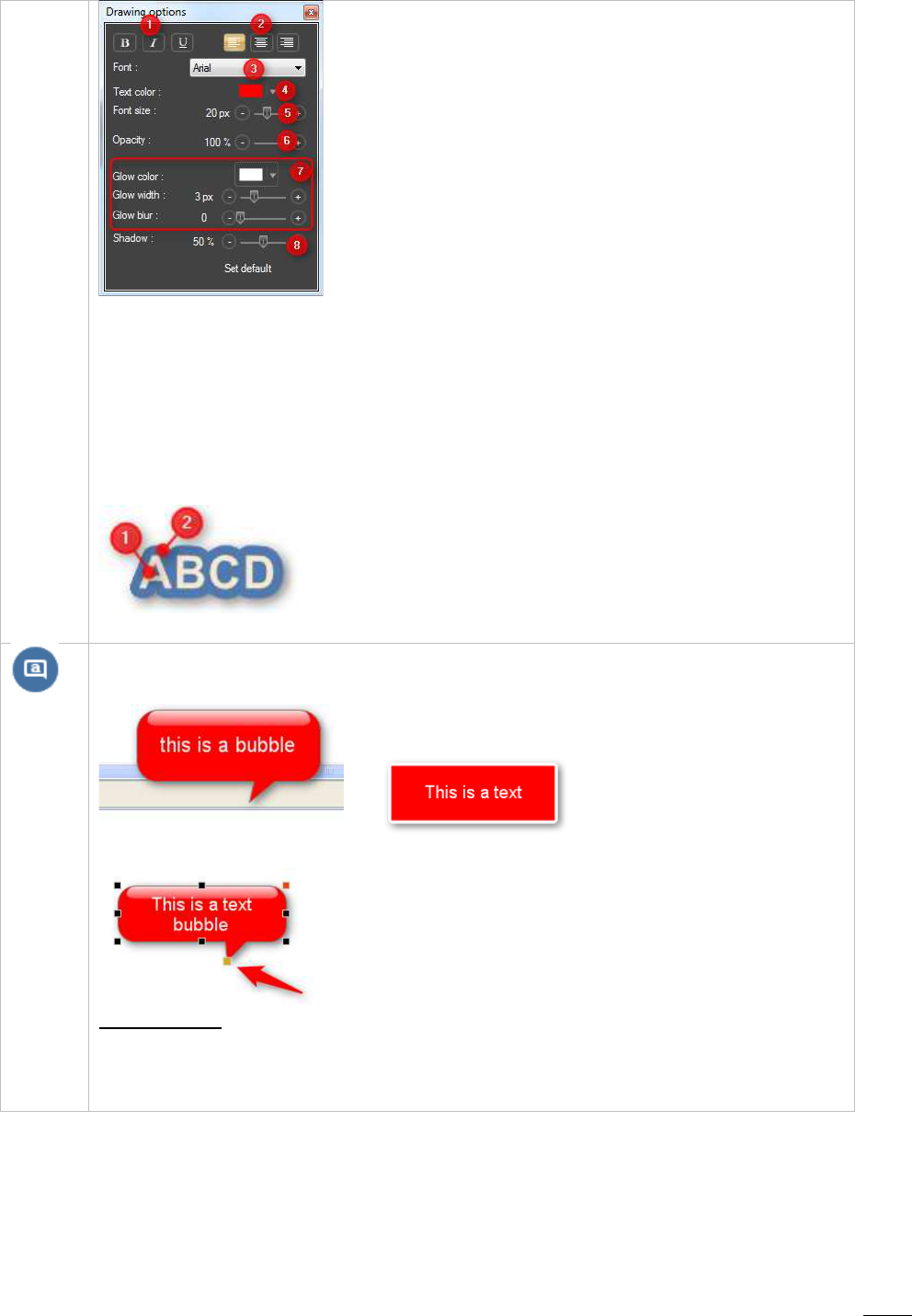
Screenpresso User Manual
Chapter
: Editing an image
59
1) The text decoration: Bold, Italic, Underline
2) The text alignment: Left, Center, Right
3) The font name
4) The font color (1)
5) The font size in pixels
6) The opacity of the text
7) Define the glow attributes (2)
8) The drop shadow level
This tool is used to add a text bubble in the image.
or
There is an additional handle to move the image of the text bubble.
Important note:
If you want to move only the text and not the image, hold the ALT key when moving the text.
Drawing options:
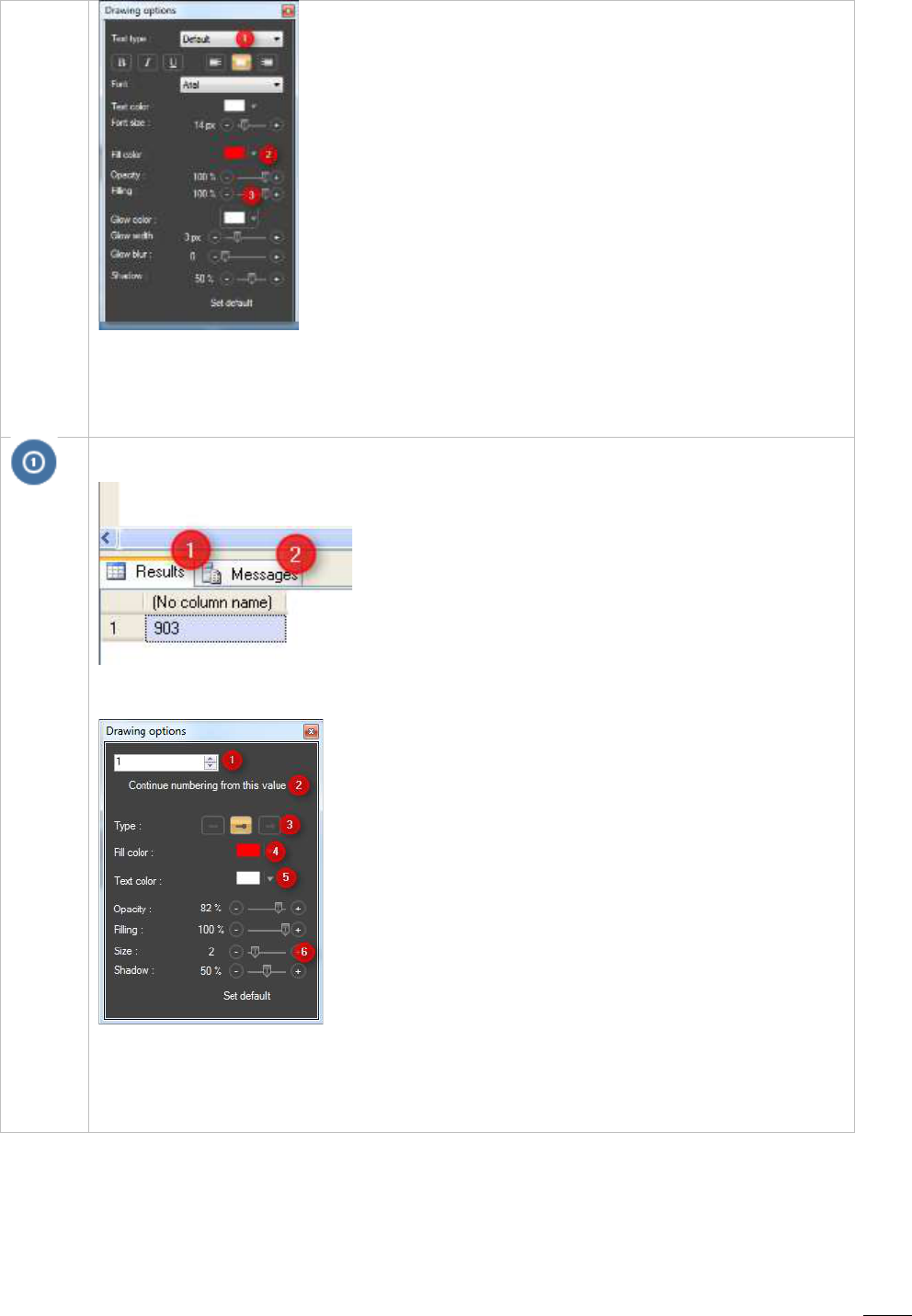
Screenpresso User Manual
Chapter
: Editing an image
60
Same as text options with:
1) The type of text box: normal or speech bubble
2) Define the filling color
3) Define the filling opacity
This tool is used to add numbering within the image which can be used to indicate steps or identify
part of the screen, for instance
The drawing options:
1) Define the number displayed in the circle
2) Use this button to start numbering from the current value
3) Define the connector type:
If you drag the yellow handle, a connector is displayed:
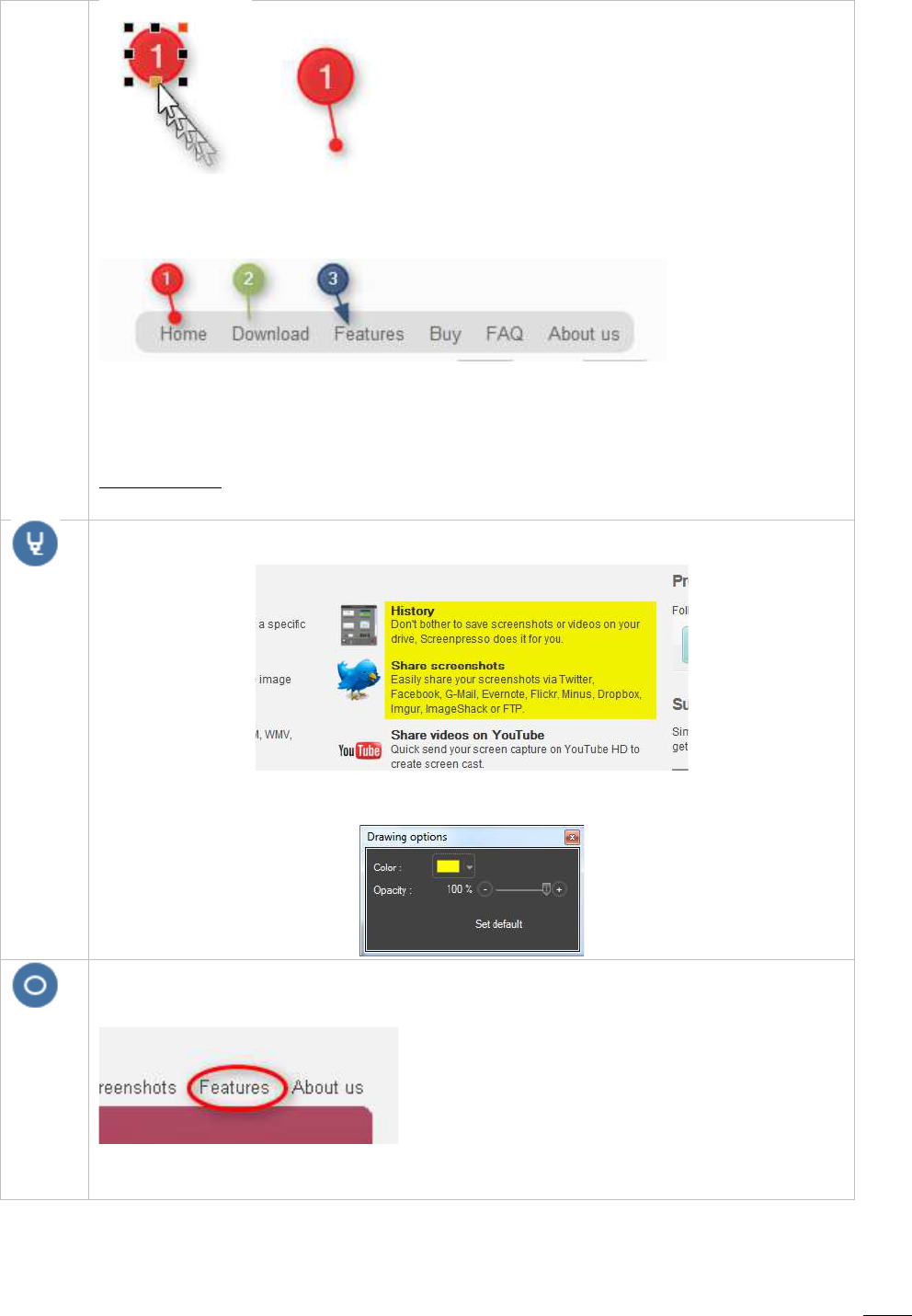
Screenpresso User Manual
Chapter
: Editing an image
61
➔
This is useful for explaining some screenshots:
4) The filling color
5) The text color
6) The size of the circle and text
Important note:
If you want to move only the circle and not the connector, hold the ALT key when moving the circle
This tool is used to highlight part of the screenshot.
The drawing options:
This tool is like the rectangle and is used to draw an ellipse or circle. Most of the time this tool is
used to highlight a part of a screenshot.
Drawing options:
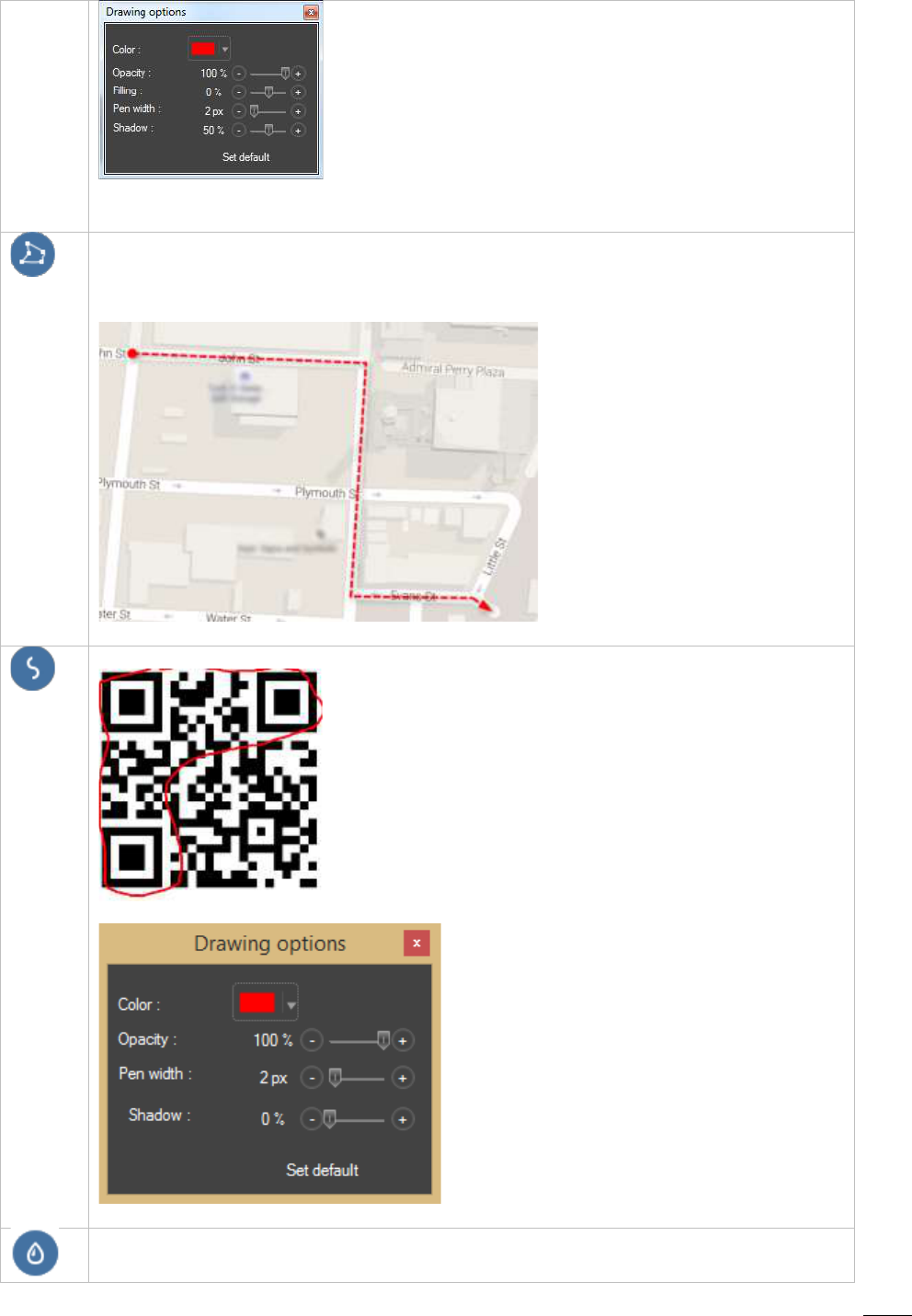
Screenpresso User Manual
Chapter
: Editing an image
62
Refer to rectangle for details.
This tool is used to create a polygon. Refer to rectangle for details.
Perform many clicks to add polygon’s points then double-click or right-click to finish drawing.
If you hold ‘Alt’ key when finishing drawing, the figure is closed by Screenpresso.
Sample use:
This tool is used to draw hand free.
This tool is used to blur a part of the image (to hide confidential data, for instance).
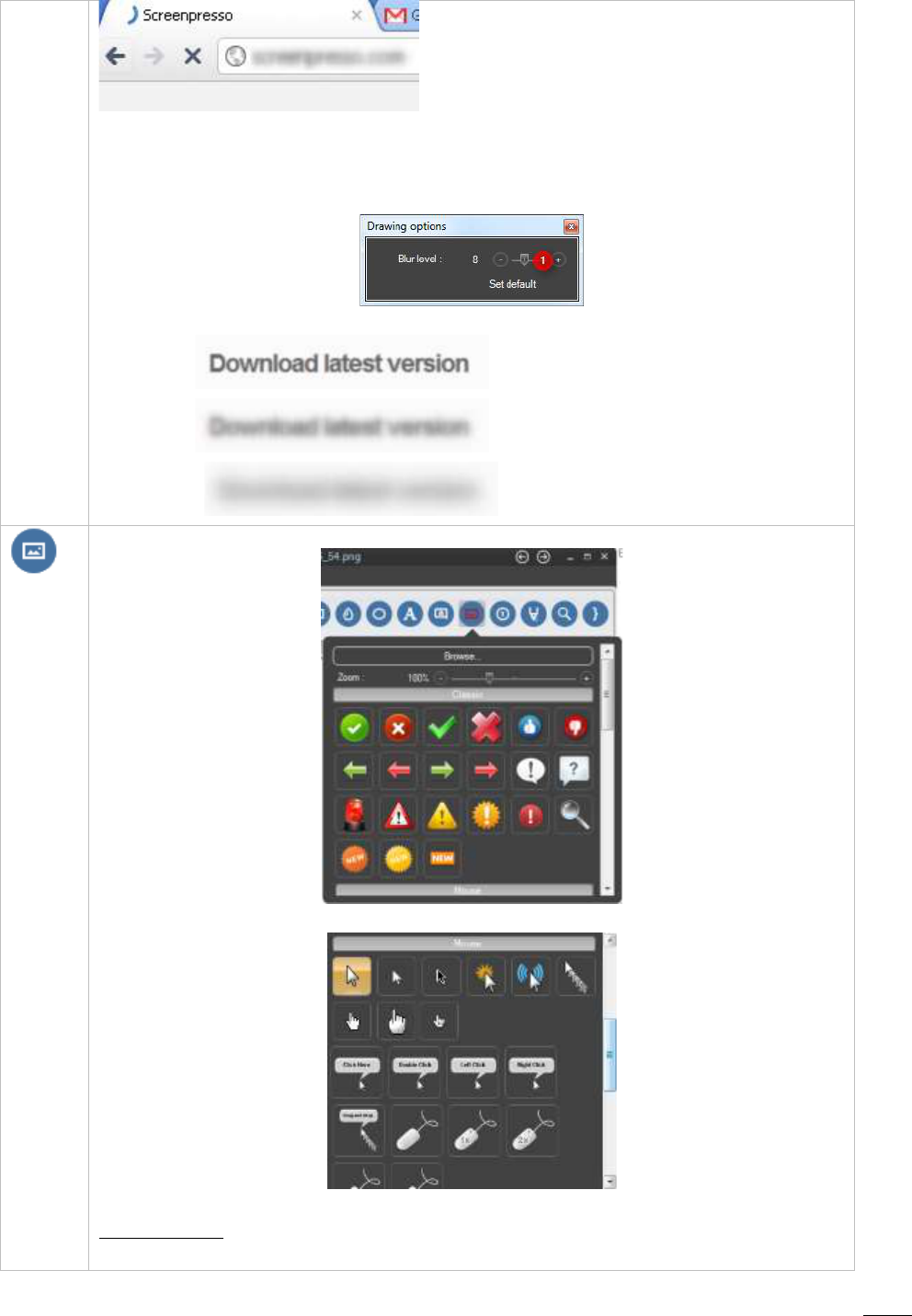
Screenpresso User Manual
Chapter
: Editing an image
63
The drawing options:
1) The blur level. For instance:
Blur level 1:
Blur level 8:
Blur level 20:
This tool is used to add stamps or insert an image:
There are some mouse cursors ready to use:
Important notes
- You can browse your own stamps/images
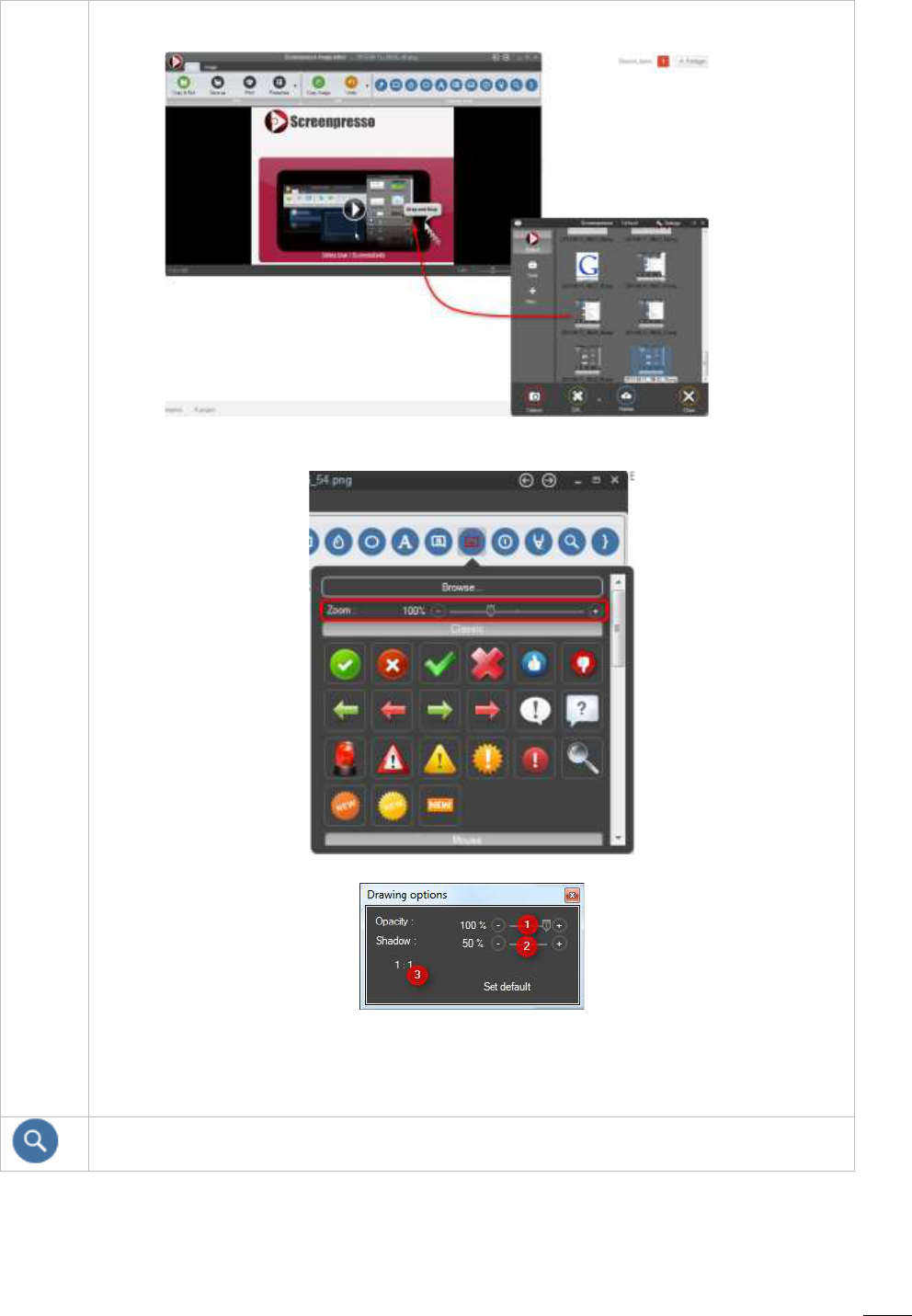
Screenpresso User Manual
Chapter
: Editing an image
64
- You can drag & drop external images to the editor canvas to quickly insert images into the
Screenpresso workspace windows to combine images:
- Aspect ratio of the image is always kept.
- You can change the default size of the stamps with the zoom:
The drawing options:
1) Opacity of the image
2) Drop shadow level
3) Restore the original size
This tool is used to draw a magnifier:
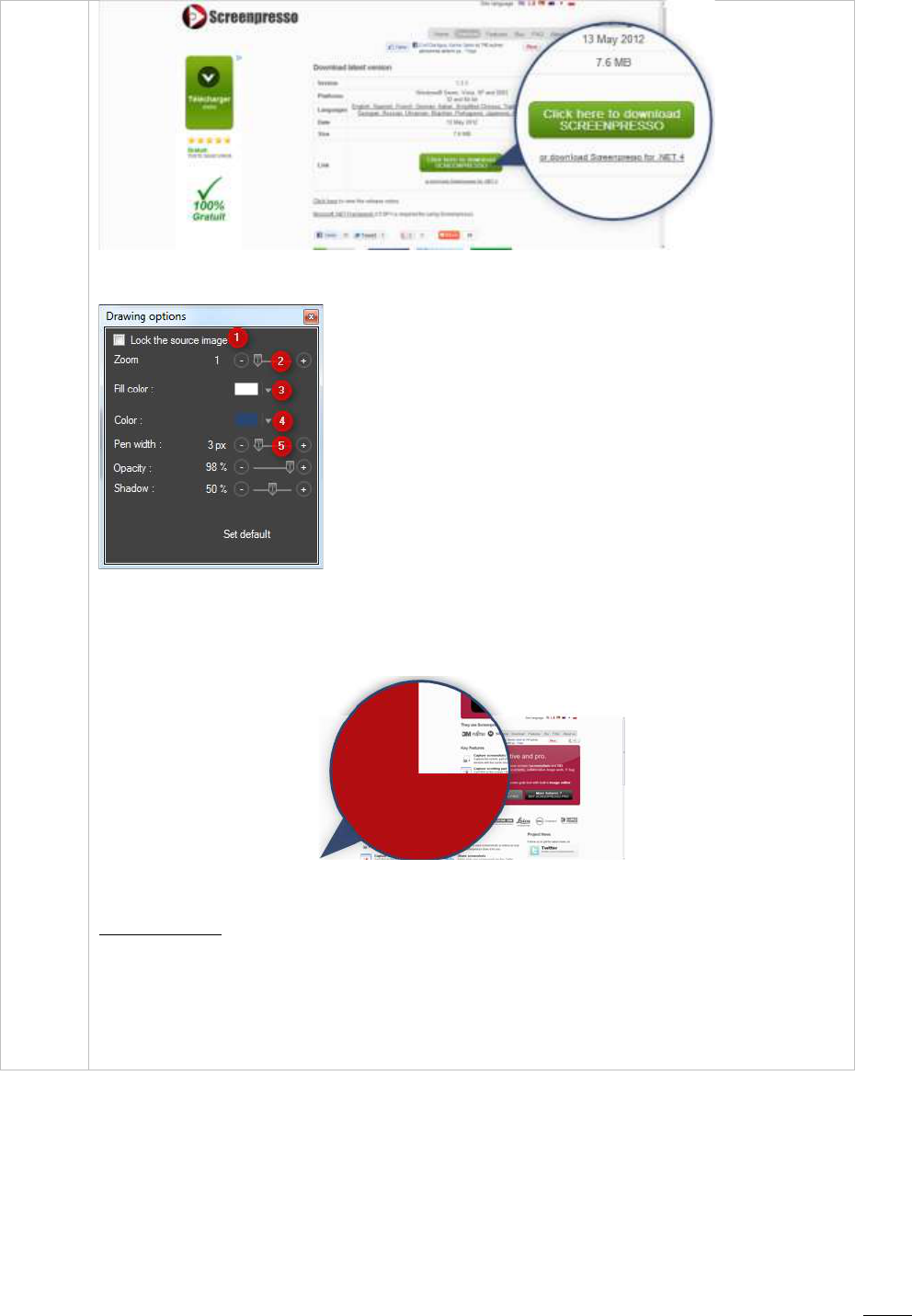
Screenpresso User Manual
Chapter
: Editing an image
65
The drawing options:
1) Lock the source image
2) Define the zoom factor
3) Define the color when the zoom is on the border of the image, for instance with red:
4) Define the pen color
5) Define the pen width
Important note:
- If you want to move only the magnifier glass and not the image, hold the ALT key when
moving it.
- Lock the source image before resizing the whole image for better results. For instance, to
create a magnifier with zoom x1, lock the source image and resize the image to 25%:
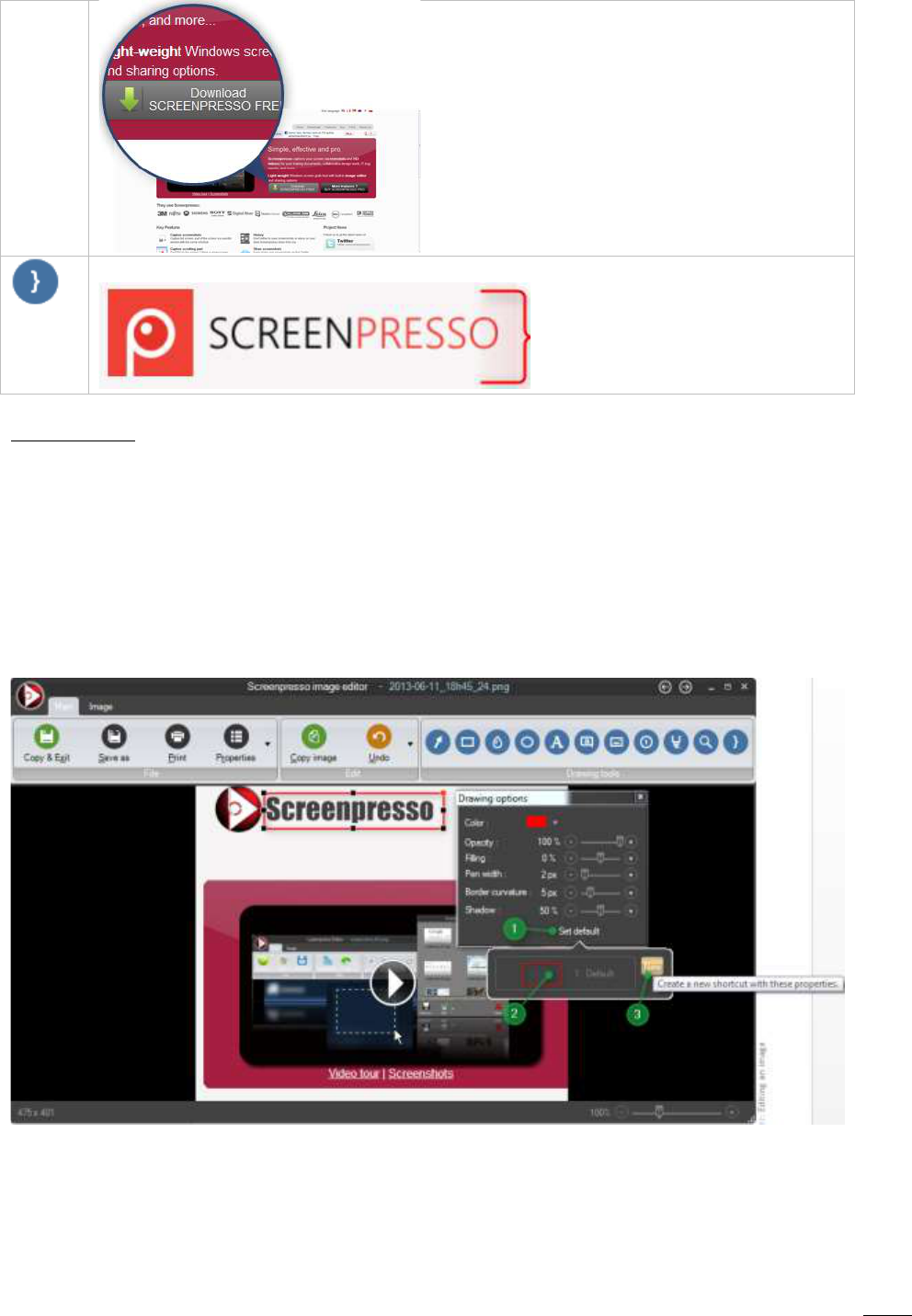
Screenpresso User Manual
Chapter
: Editing an image
66
Important notes
- To unselect the tool:
o Press the Escape key
o Or right click
- To draw new item using the color under the mouse, hold Alt key
- To copy/paste a drawing item:
o Right click on the item, choose copy then paste
o Hold the CTRL key while drag and dropping the item
- To create a square drawing item (width = height), hold the CTRL key while resizing the drawing item.
- You can define your own item drawing presets:
In the drawing options, when you have set all the properties, click on the “Set default” button (1).
You can assign the current properties to an existing preset, for instance (2) or create a new preset with the
“new” button (3).
For instance, if we create a new preset for a green number, then, when you want to create a new green
This tool is used to draw brackets:
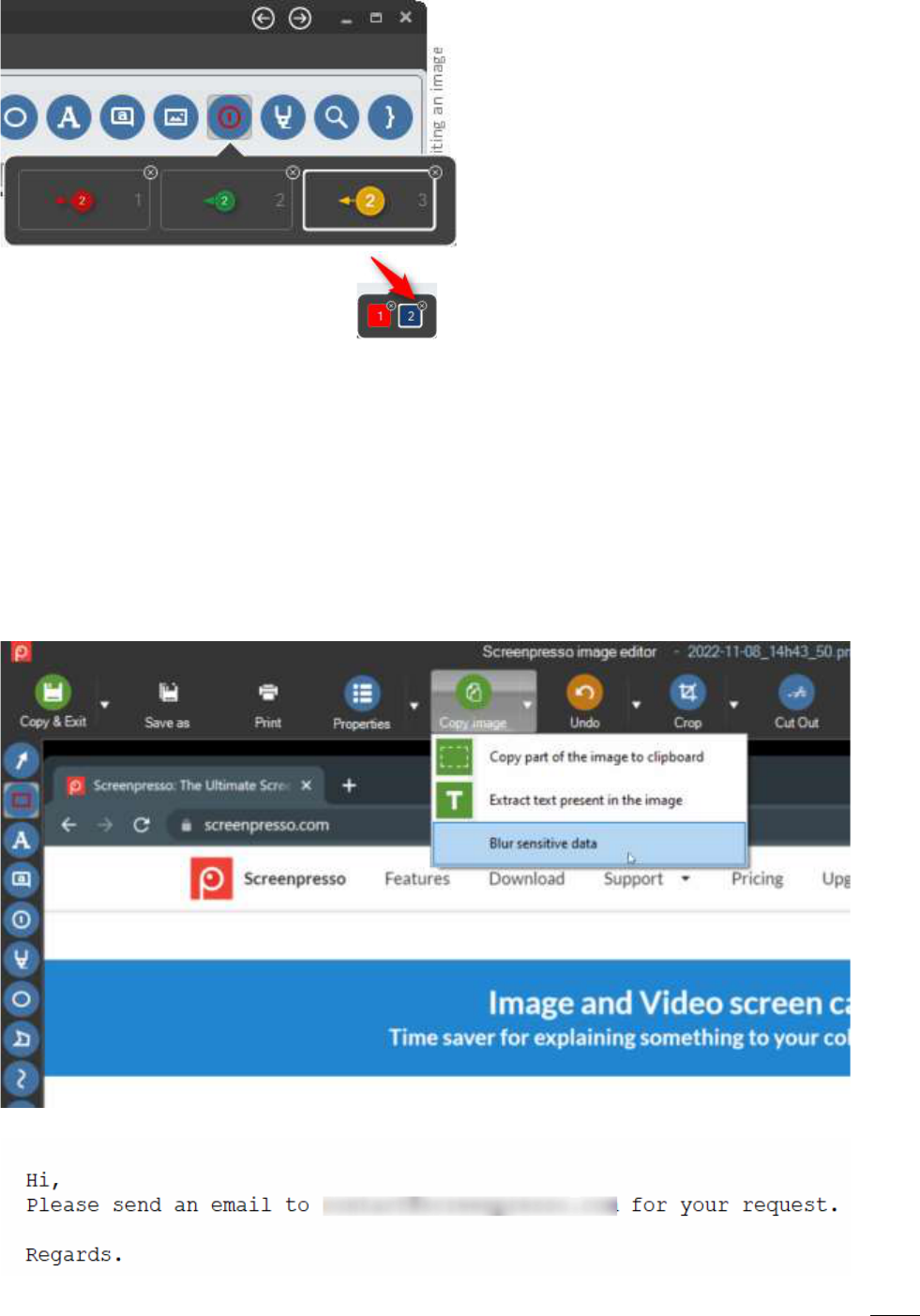
Screenpresso User Manual
Chapter
: Editing an image
67
number, you can select the preset directly before creating it:
To delete a preset, click on the top right cross:
12.3 Change main image (PRO)
Once you added some items on your captured image, you may want to change it and keep the items. For
instance, this occurs if you want to set a new image captured in another language. To change the background
image, right-click anywhere on it (not on a drawed item), click “Change main image…” context menu item, then
choose the image you want.
12.4 Automatically blur sensitive data
The menu item with run an OCR to detect areas containing e-mails, then automatically add a blur drawable
item on it. You can move, resize or delete the blur afterward if necessary.
Sample result:
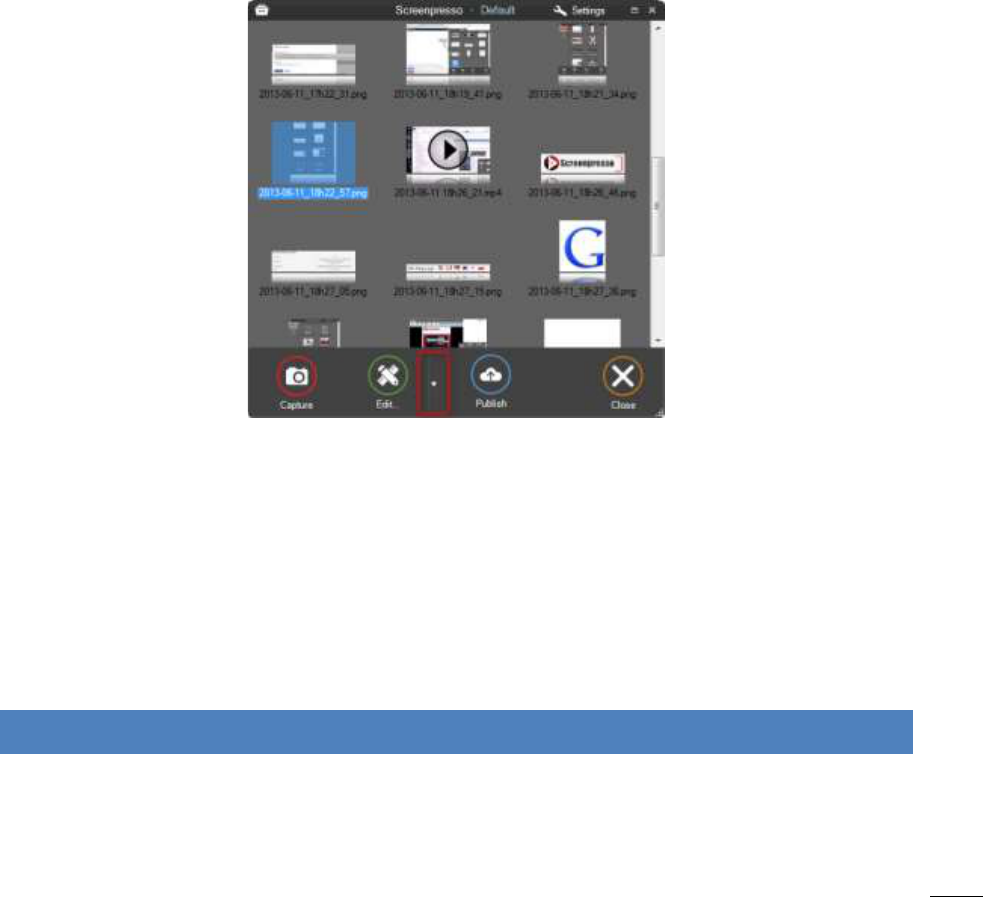
Screenpresso User Manual
Chapter
: Editing a video
68
12.5 Hidden features
When you click the green Copy and exit button, holding both the Alt key and the Ctrl key performs the
operation on all currently opened image editors.
When you click the Copy button while holding both the Alt key and the Ctrl key, the image is flattened.
When you click the close button (at the upper-right of the window) and the confirmation dialog opens, holding
bot the Alt key and the Shift key closes all currently opened image editors without saving.
When you click the Next or Previous button (at the upper-right of the window), holding both the Alt key and
the Ctrl key deletes current image then opens the previous image or the next image.
If you click the Screenpresso logo at the upper left of the window, a menu appears.
Ctrl+Del shortcut deletes the current image.
Ctrl+O opens another image.
F11 to display the image full screen.
12.6 Third party editors
You can open the image in third party applications using the “Open with” option:
12.7 Edit other images
It is possible to use built-in image editor with images that I have not been captured with Screenpresso (files in
My Pictures folder, screen captures made outside of Screenpresso, etc.):
• Open the editor and click the Screenpresso logo at the top-left corner of the window then choose
"Open..."
• or install Screenpresso then right-click an image in Windows File Explorer then choose "Open with..."
then choose "Screenpresso"
• or drag and drop the image to Screenpresso workspace window then double-click on it.
13 Editing a video
13.1 Built-in editor
The current version of the built-in editor of Screenpresso provides limited editing functions:
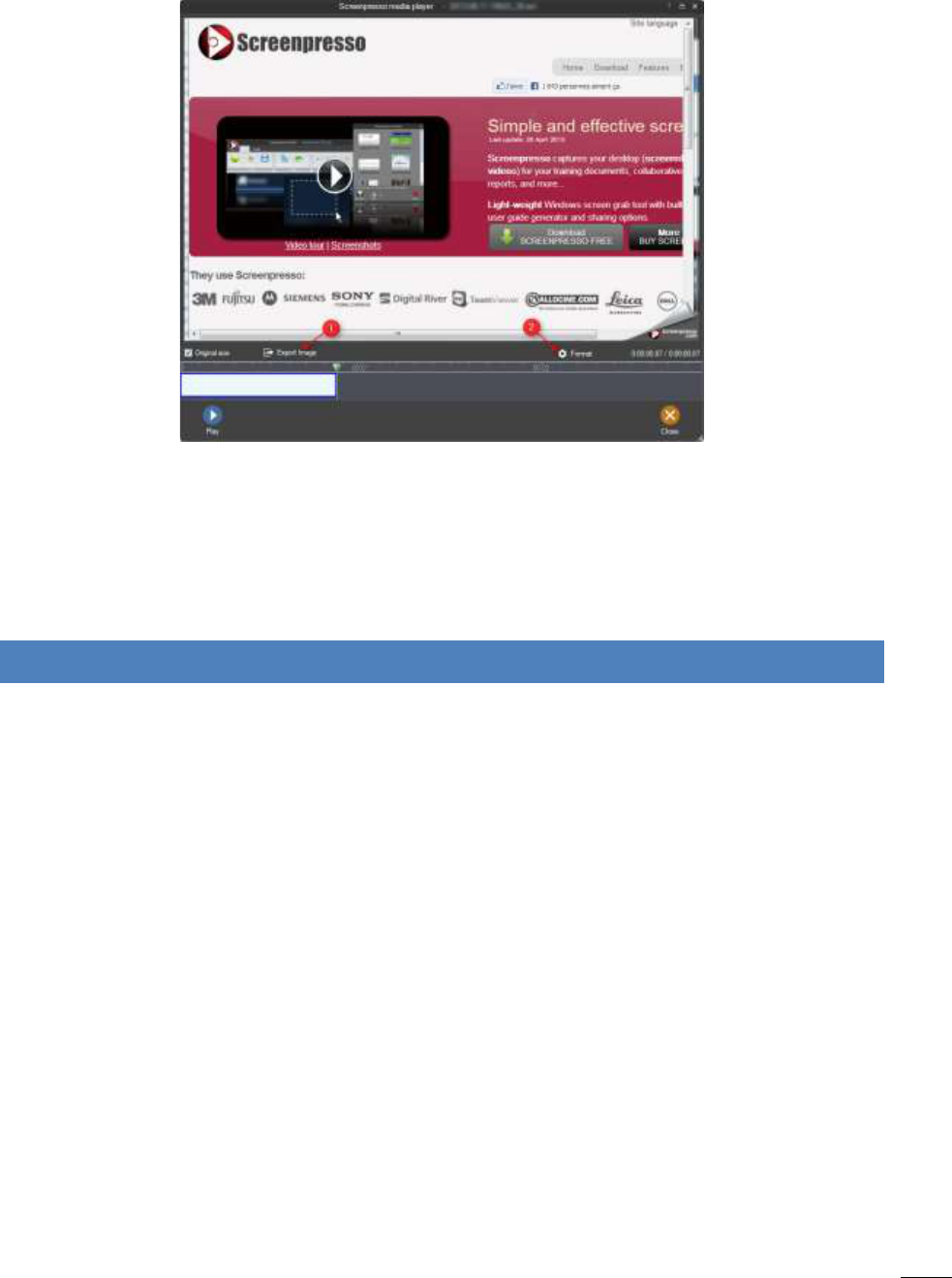
Screenpresso User Manual
Chapter
: Document generator
69
- Resizing
- Export frames
- Changing format (mp4, wmv, …)
In the workspace window, click on the button Edit on a video or double click on a video.
1) Export the current frame
2) Change the format of the video
13.2 Third party editors
You can open the video in third party applications using the “Open with” option.
14 Document generator
It is possible to generate a PDF, DOCX, HTML or animated GIF document based on selected images. This is great
for quickly generating a user or training manual.
14.1 General use
1. Select multiple images in the workspace, then click the “New doc…” button.
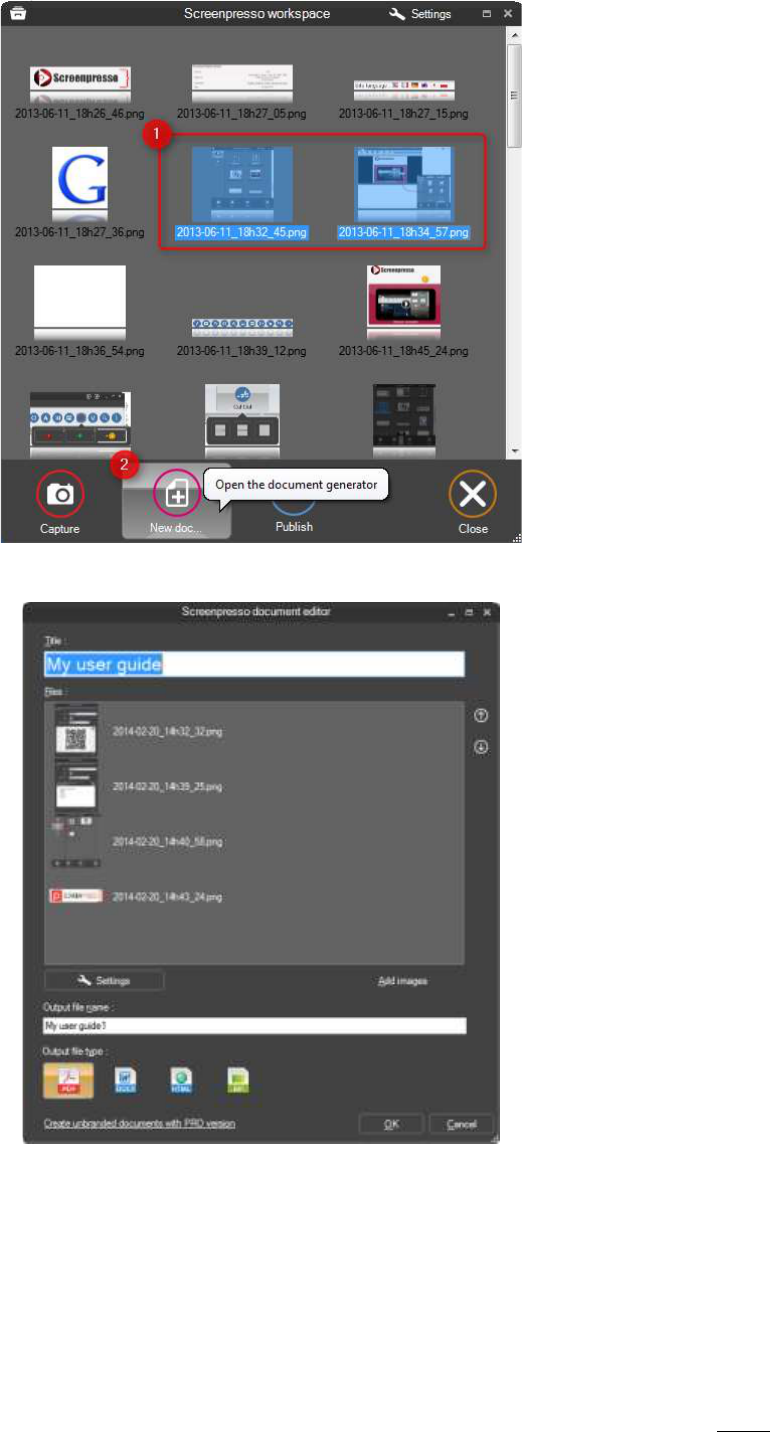
Screenpresso User Manual
Chapter
: Document generator
70
2. Screenpresso’s built-in document editor appears.
3. Double-click an image to edit it
a. Click on “Give a title to the image” text area and write your own title
b. Click on “Write a description for the image” text area and write a description
HTML tags are supported. You may, for instance, write ‘This is an <b>important</b> feature”
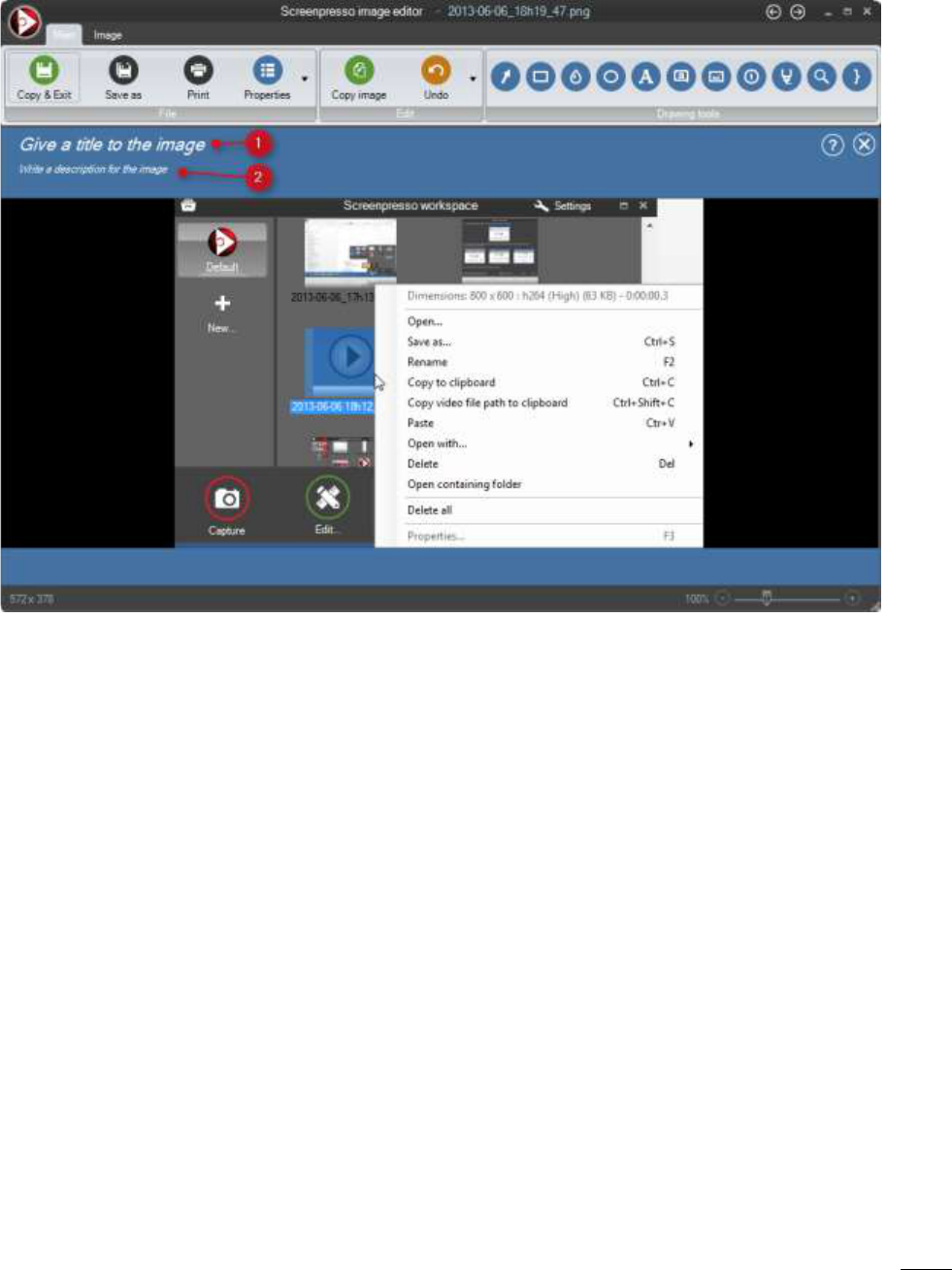
Screenpresso User Manual
Chapter
: Document generator
71
c. If a number item is selected, you can write a description for it at the bottom of the editor
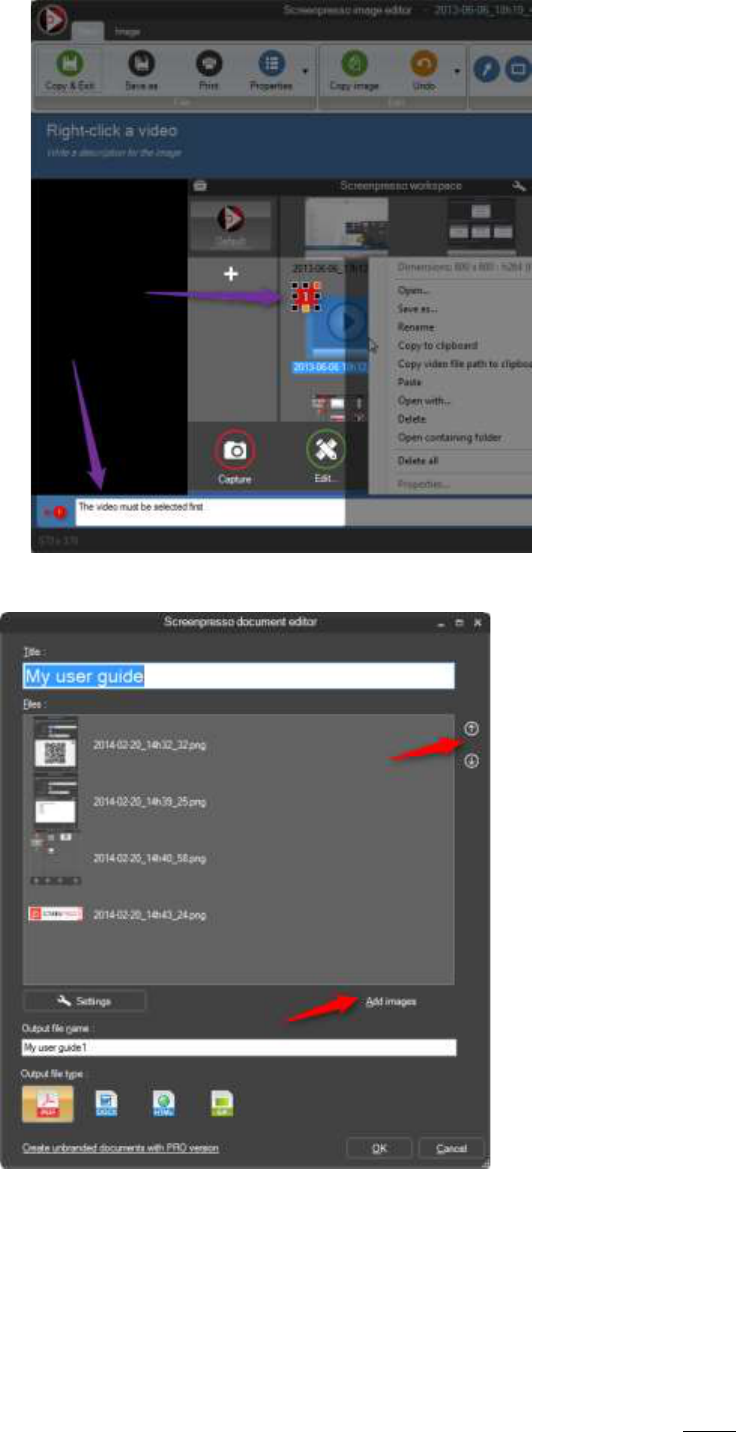
Screenpresso User Manual
Chapter
: Document generator
72
4. Click the “Copy & Exit” button.
5. The document editor comes back.
6. Use the arrows to modify the images’ order;
7. Press the “Del” key to remove an image from the document to be generated (does not delete it from
disk);
8. Press the “Add images” button to display Screenpresso’s workspace. You can then drag and drop
images to add to the document;
9. Choose the document type to be generated (Adobe PDF, Microsoft Word 2007, HTML or GIF);
10. Press the OK button.
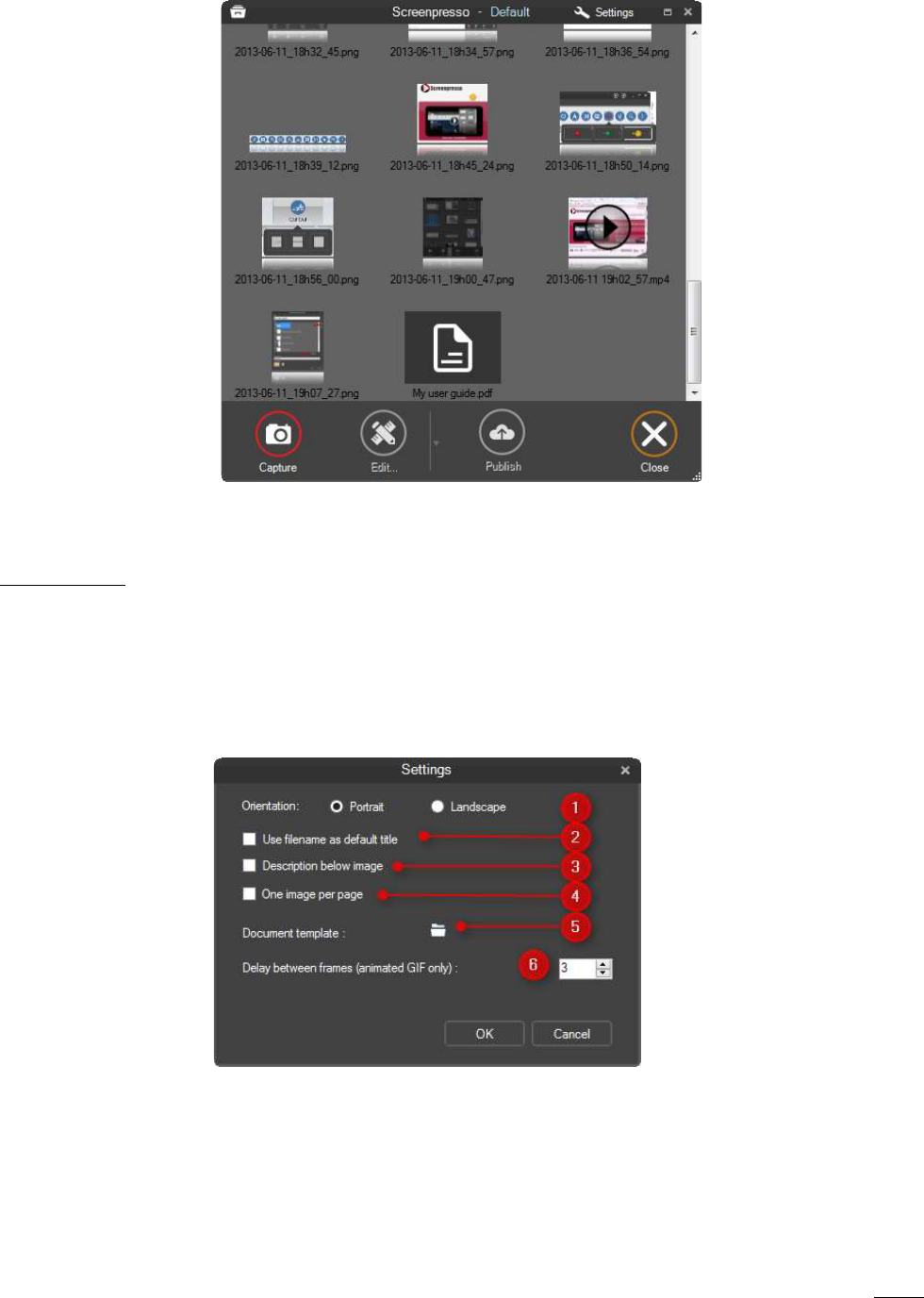
Screenpresso User Manual
Chapter
: Document generator
73
11. The newly generated document is automatically opened using a default application (Acrobat reader
for instance) for review and the file is available in workspace.
Double-click a document file in workspace to re-edit it and generate another file.
Important note:
A generated document is based on a Microsoft Word 2007 template file. If a file name “Template.docx” is
found next to Screenpresso.exe, it is used for document generation. If you have a Microsoft Word file editor
installed on your computer, you can open this template using the button provided in the generator settings.
14.2 Generator settings
You may change the default settings of the generator.
1. For large images, the orientation of the document can be changed to landscape.
2. Set image filename’s as default title’s value when unspecified.
3. Forces images to always appear before their corresponding text description.
4. Forces a page break between each image and its corresponding text description.
5. Opens the file used for generating the document default headers and footers and heading styles. A
Microsoft Word file editor must be installed on your computer.
6. Changes delay between images for animated GIF output.
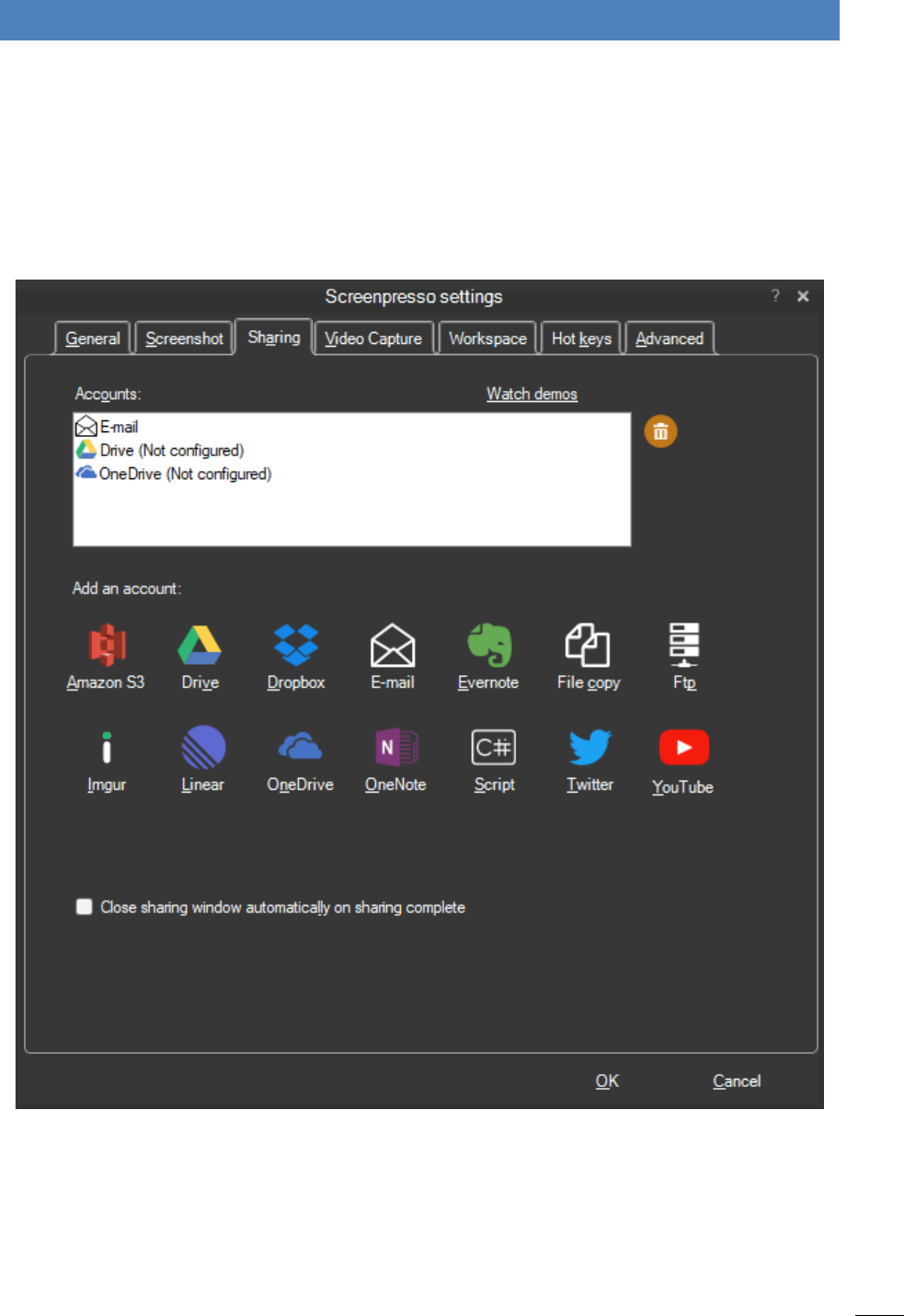
Screenpresso User Manual
Chapter
: Publishing files
74
15 Publishing files
15.1 Local publishing
In the workspace window, on each file, you can export the file using:
- Right-click, then choose “Save as” from the menu (or CTRL+S) and then choose the file format;
- Drag & drop to the destination folder.
15.2 Web and cloud sharing
Screenpresso features the most popular cloud services.
To configure them, open the Sharing tab in the Settings of Screenpresso:
- Click on the account to setup and add a new account;
- Click on the recycle bin to remove one.
Once the accounts are configured, they will be available in the publish button in the workspace window:
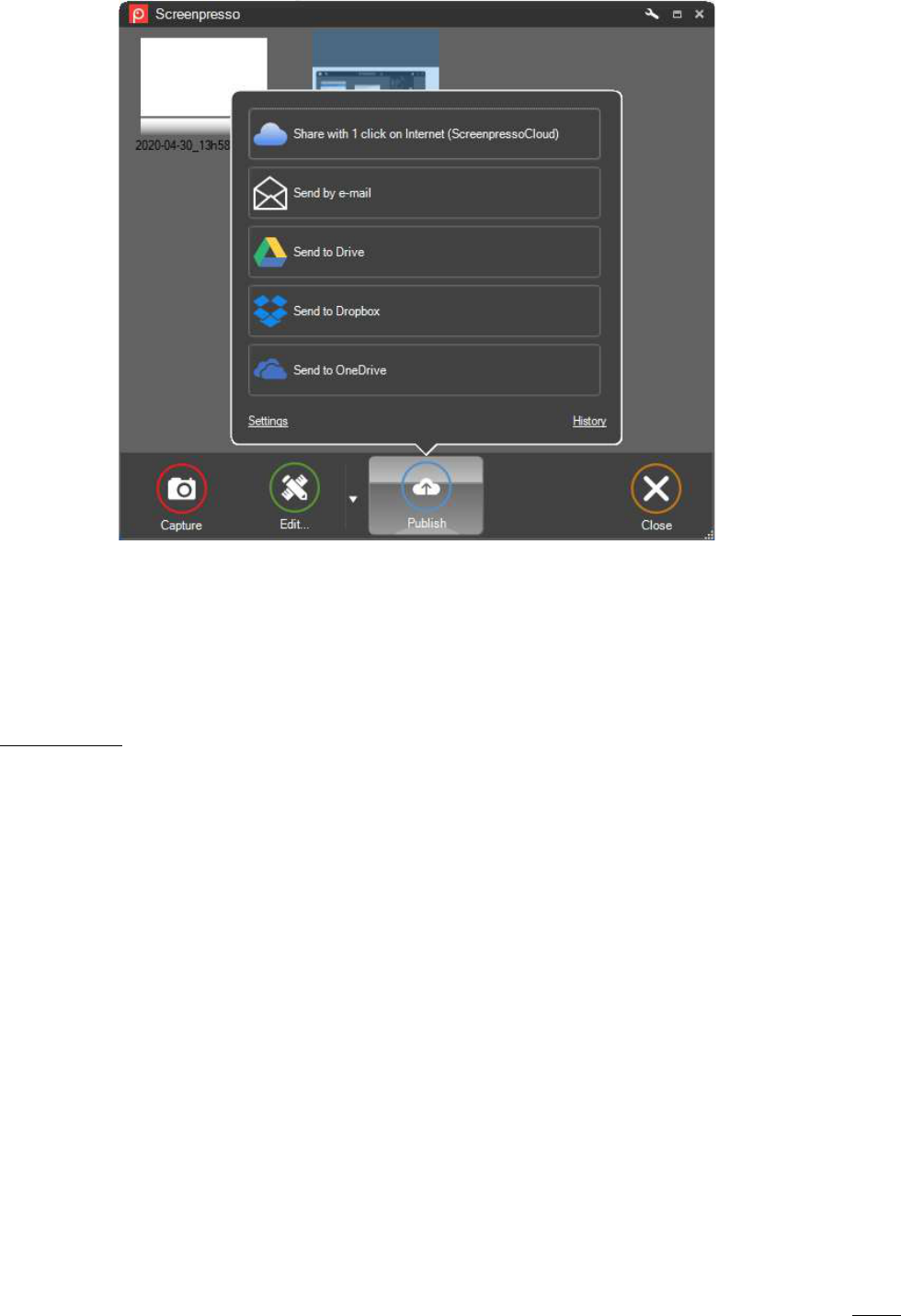
Screenpresso User Manual
Chapter
: Publishing files
75
When you click the sharing to execute, a new window appears, and you must click the “Send” button to upload
the selected files. Once the upload is finished, the URL of the file(s) is displayed and copied to the clipboard.
You must then click the “Close” button to close the windows. If you checked the “Close sharing window
automatically on sharing computer” setting the buttons “Send” and “Close” will be automatically clicked. In this
case you can only retrieve the generate URL via the clipboard or via the history window.
Important note:
- FREE version adds branding to the published captures
- Some sharing services can be disabled if they don’t support the file type you have selected.
For instance, some sharing services don’t support multiple files upload, or don’t support video files.
- You can use Ctrl+<num key> shortcut to execute a sharing. <num key> is the index of the sharing
account as displayed in the list
15.2.1 Get a public URL thanks to Screenpresso Cloud
Screenpresso features a built-in sharing system called Screenpresso Cloud. On’ file selection’, click on the
“Publish” button and choose the first button.

Screenpresso User Manual
Chapter
: Publishing files
76
Screenpresso will upload your images and videos and then give you a public URL to share:
If you open the “Delete URL” link in a Web browser, it immediately deletes uploaded files without
confirmation. This URL works only when called using the same IP address than during upload.
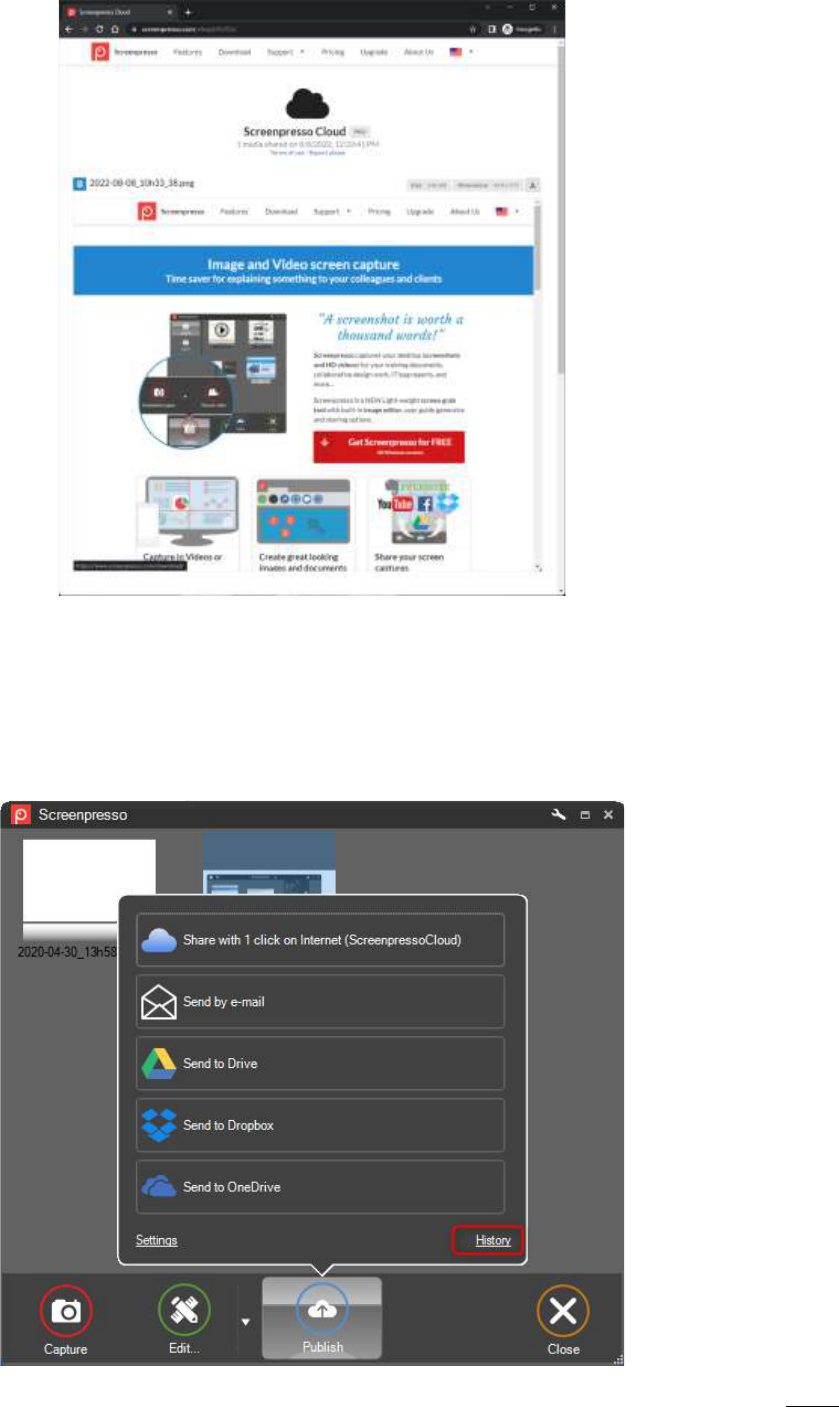
Screenpresso User Manual
Chapter
: Publishing files
77
Example of a generated Web page:
Uploaded files remain available for 60 days.
15.2.2 Sharing history
Each time a media is shared through a cloud service, an entry is added to the sharing history which can be
opened using the following links:
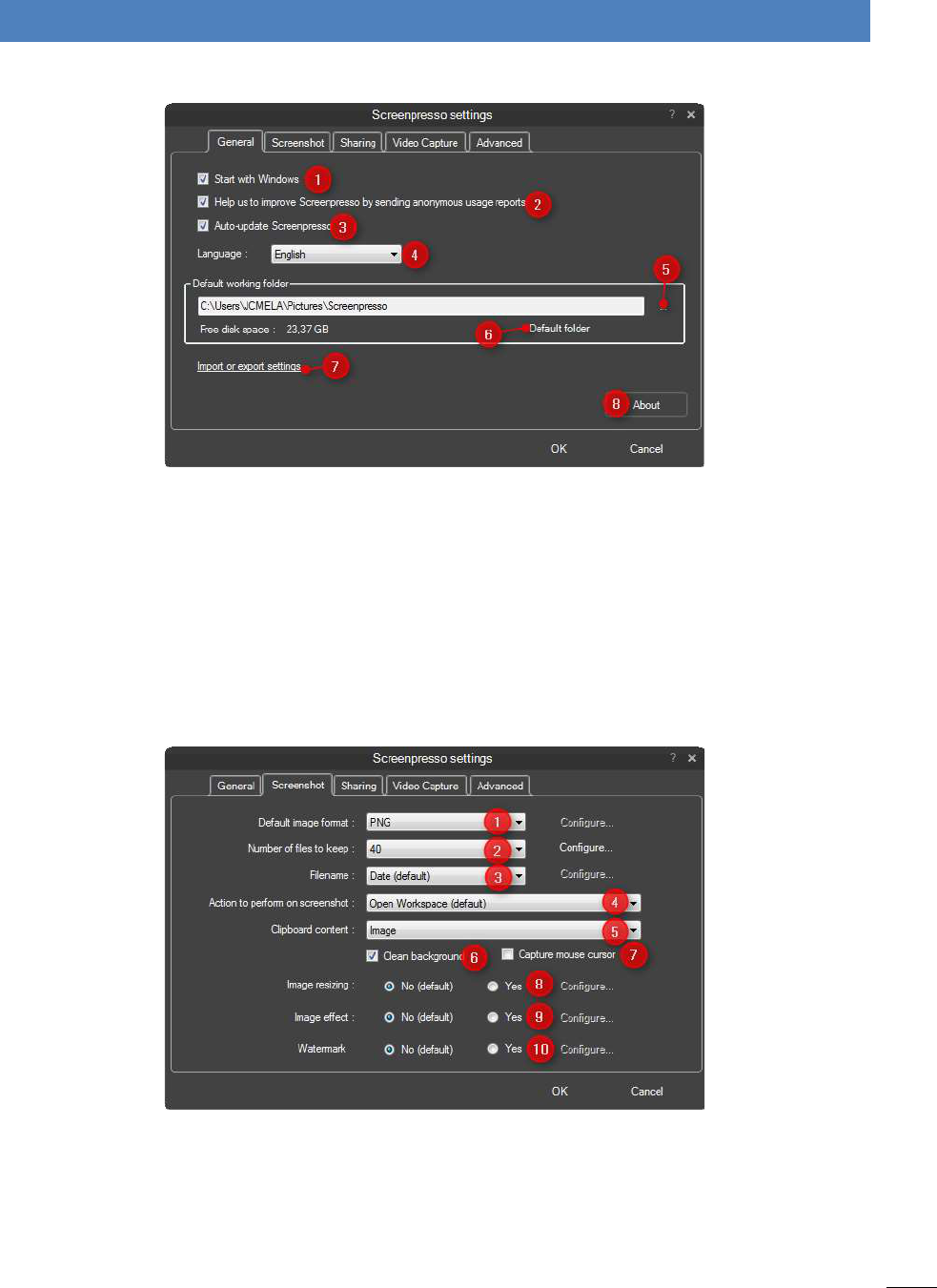
Screenpresso User Manual
Chapter
: Settings
78
You can then retrieve previously uploaded images or videos and the corresponding URL.
16 Settings
16.1 General
1) Define if Screenpresso should start when Windows starts
2) Send anonymous report to help the Screenpresso developer team to improve tools and fix the issues.
3) Automatically update Screenpresso when new releases are available.
4) The language of the tool.
5) Browse to define the working folder.
6) Reset the working folder to the default one.
7) Provides tool to export and import the current Screenpresso settings for backup and deployment.
8) Opens the ’About’ box
16.2 Screenshot
1) Defines the default image format for the screenshot:
a. JPG (the quality is configurable);
b. GIF;
c. PNG;
d. TIF (the quality is configurable);

Screenpresso User Manual
Chapter
: Settings
79
e. BMP,
f. WebP,
g. JPEG XL.
2) Defines the behavior of the workspace windows: the number of files to keep. The configure button
allows you to turn off the auto clean-up of the workspace.
3) Define the filename:
a. Date: current date and time;
b. Numbering: incremental numbering;
c. User defined: you can enter your file pattern using the configure button.
4) Defines the action taken after the capture:
a. Open the workspace window;
b. Open the internal editor;
c. Show balloon tip from the system tray;
d. Do nothing;
e. Print immediately.
5) Define the clipboard content once the capture is taken or you close the editor:
a. Image;
b. Image + Filepath;
c. Filepath;
d. Do nothing.
6) Clean up the background.
➔
7) Check this box to capture the mouse on each capture (otherwise you need to press M during capture
to add the mouse cursor).
8) Default resizing that is applied on each capture.
9) Default image effect that is applied on each capture.
10) Define the watermark settings that will apply on each capture (you can still turn ON or OFF using W
key during capture).
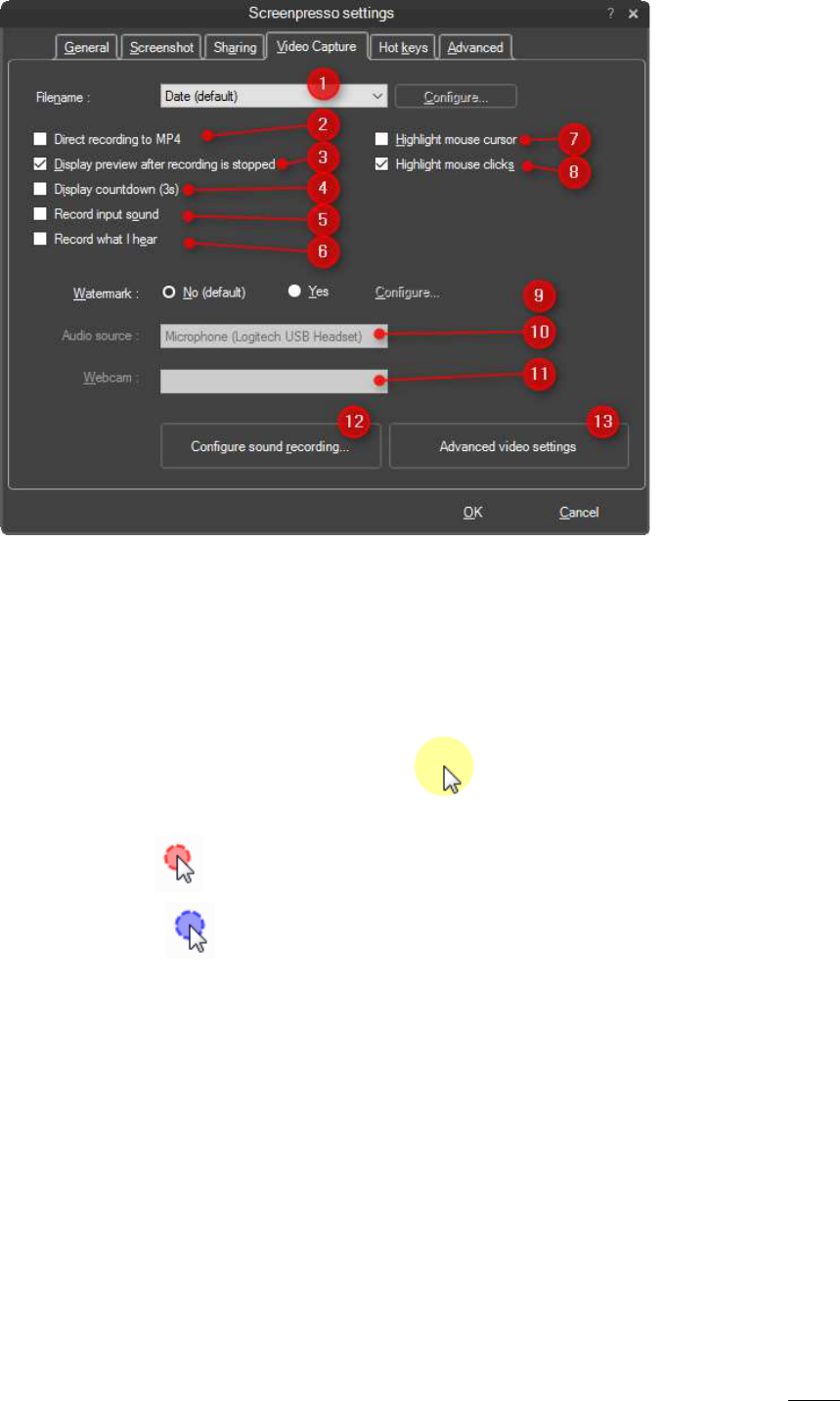
Screenpresso User Manual
Chapter
: Settings
81
1) Defines the filename of the video.
2) Record to MP4 instead to AVI (avoid conversion to be done after recording). This is not the default
since it requires more CPU and as limitations.
3) Opens the preview window (Screenpresso media player) after the capture.
4) Displays a countdown before starting to capture.
5) Record sound from the microphone (to be configured via 10 & 12)
6) Record sound from the sound card
7) Highlights the mouse cursor in yellow during the capture.
8) Highlights the mouse clicks during the capture:
a. Left mouse click:
b. Right mouse click:
9) Add watermark in the video during recording
10) Specify the input sound to record (usually the microphone)
11) Opens the windows sound mixer settings
12) Defines the webcam to use if there are more than one
13) Opens Windows’ sound mixer
14) Opens codec options
16.5 Advanced configuration
The advanced tab settings should be used only by advanced users:

Screenpresso User Manual
Chapter
: Settings
82
Disabling recycle bin may improve performances.
The “Restore default settings” button resets all settings without confirmation. If you clicked on it by error, click
the “Cancel” button to close the settings window without saving changes.
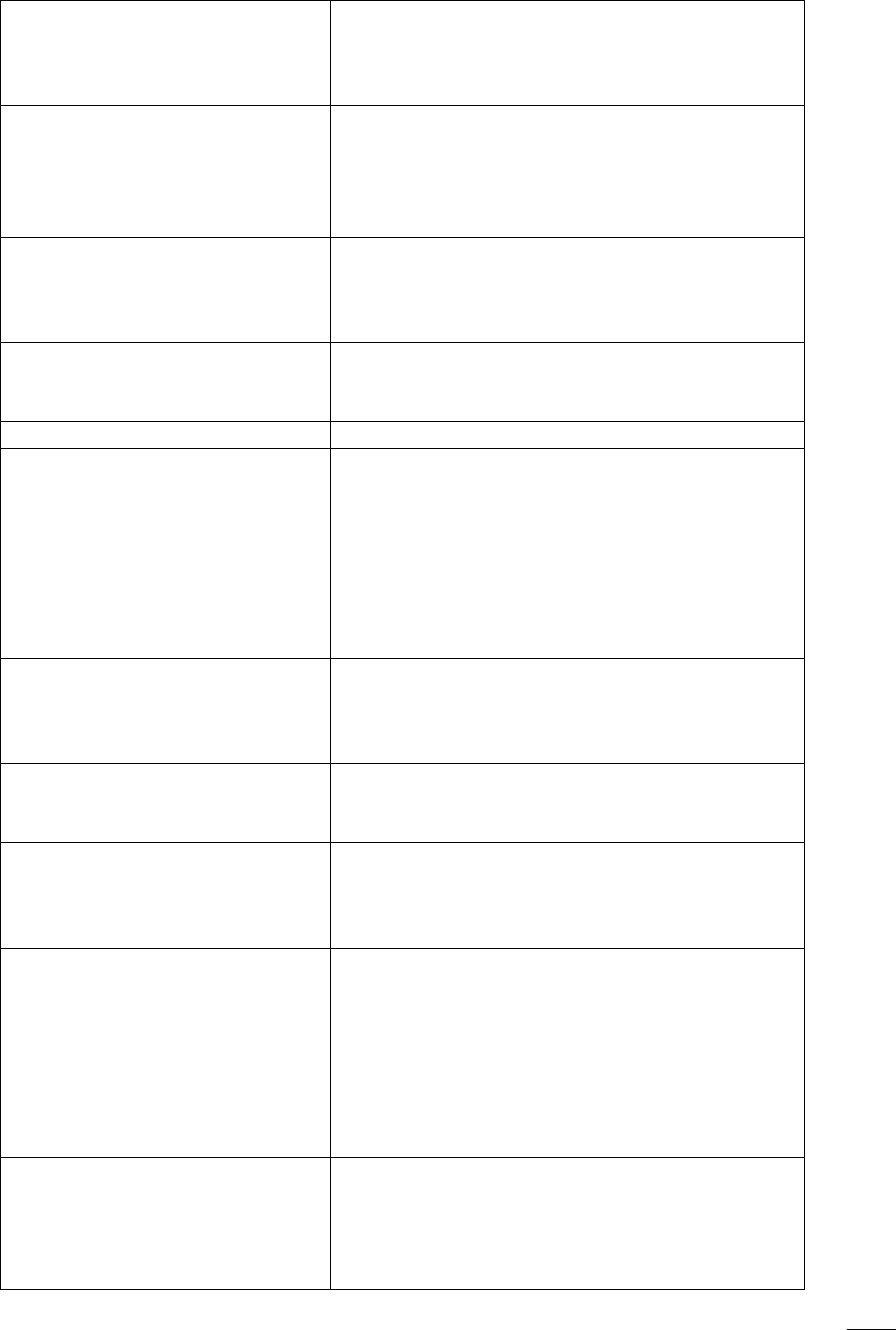
Screenpresso User Manual
Chapter
: Settings
83
AndroidBitRate
When recording an Android screen, the default bit rate is
20Mbpps. You can set your own value here (e.g. 80 for
80Mbpps). You will get a nicer video, but the file size will be
much larger, and all devices do not support it.
AndroidKillAdbOnExit
Android Debug Kit executable is used but Screenpresso to
communicate with an Android mobile phone. When
Screenpresso exists, it does doe exit this process in case you
are using it with another application. Setting it to True free
the resource when Screenpresso exits.
AnimatedGifFramerate
Number of images per second for an animated gif or an
animated png. You can set your own value here (e.g., 10 for
10fps). You’ll get a nicer animation, but the file size will be
much larger.
AnimatedGifLoopCount
If you generate an animated gif or an animated png that
loops, you can set the number of loops here. 0 means an
infinite number of loops.
AudioRecordStereo
Record system sound in stereo. False records in mono.
AutomaticRestart
We have optimized the memory that uses Screenpresso,
but it is impossible to say that if you never reboot your
computer, Screenpresso will not use more and more
memory day after day. To avoid this issue, Screenpresso is
automatically restarted from after a period of time. The
timer starts and is reset after each use of Screenpresso
(e.g., when you take a screenshot). The timer is configured
to restart Screenpresso once, after 1 hour of inactivity.
AutoscrollDelay
For a capture auto scroll, Screenpresso simulates a click on
the vertical scrollbar then take a capture. This is the time in
milliseconds to wait after the click and before taking the
capture.
AutoscrollDelayForIE
Internet Explorer is much slower to refresh after the click
then the other Web browser. According to this a higher
value must be uses for it. The default value is 200ms.
AutoscrollScrollBarWidth
Screenpresso must detect the scrollbar to simulate a click
on it. 20 pixels is the default value but, if you use an
advanced custom Windows’ theme, you may change this
value.
AviFormatEnable
Allows you to keep your recorded video capture in AVI
format. This is faster because it avoids the need to wait for
compression from AVI to MP4 to be performed after a
screen recording. But the AVI format uses a Screenpresso
codec that is not standard and so, the video cannot be read
by other software, only by Screenpresso. It can be used if
you wish to quickly record multiple videos and recompress
them later.
BitmapRotate
Indicates whether an image must be rotated according to
its EXIF metadata. Useful for instance when you import a
landscape mode image to Screenpresso via a drag and drop
from the Windows’ file explorer to the Screenpresso
workspace’s.
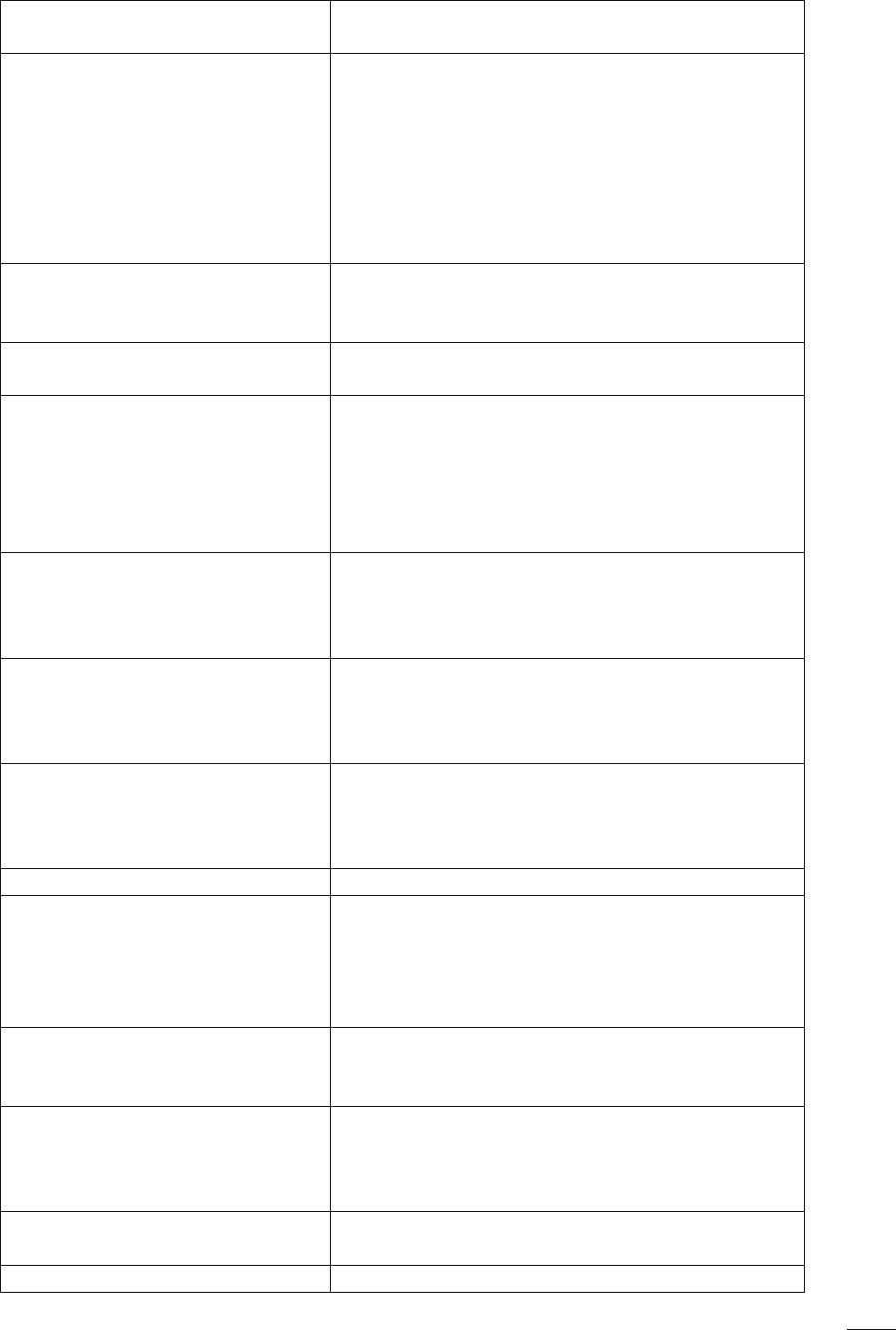
Screenpresso User Manual
Chapter
: Settings
84
CaptureAutoPrint
After each capture, request Screenpresso to automatically
print it. Use with care!
CaptureContext
When you take a screenshot via a single click on a window,
request Screenpresso to retrieve some metadata. For
instance, if you perform a single click on Google Chrome to
capture the window, the URL of the displayed Web page is
store in the metadata of the capture image. These meta
data can be used for a custom filename, by the document
generator, and are saved in the EXIF data if the generated
file is a jpg.
CaptureMouseCursor
Indicates if the mouse cursor must be visible in the capture
by default. You can still remove it later via the Screenpresso
built-in image editor.
CaptureNoFile
Request all captures to be stored in the clipboard but never
saved to a file.
CaptureOneScreenOnly
If True, taking a screenshot will be limited to the screen
under the mouse when starting the capture. Disabling
cross-screens captures improves performances and reduce
memory usage. It is recommended to set it to true if you
don’t need to perform cross-screens captures an have
multiple high-resolution screens.
CleanAeroBorder
On Windows Vista, all windows displayed with a translucid
title bar. If this setting is set to True (this is the default value
only on Windows Vista), Screenpresso will automatically
add a lovely blank background behind the window.
ColorPickerShowInHexa
When you use the color picker capture tool of
Screenpresso, the color under the mouse is displayed in
decimal in the hourglass. If this setting is set to true, the
value is displayed in hexadecimal.
ConfirmDelete
Set it to False to stop Screenpresso to ask you for
confirmation every time you delete a file. For your
information, all deletes move the file(s) to the Windows’
recycle bin, so you can still retrieve your deleted file later.
ConvertVideoQuality
Video quality. A higher value takes more time to compress.
DefaultRecompressEnable
Indicates whether quantization is applied on every save of
images. It takes longer to save but the final file size is much
smaller, without the loose of quality. To manually apply
quantization, right-click an image then choose
“Recompress”.
DocumentMaximumImageSize
Indicates whether, when generating a document, image
uses the full document width. When false, a margin is
added, and the image is centered.
DisableGrayedForm
When a popup window is displayed on top of another
parent window, the parent window is grayed. Setting this
value to False improves display performance but make the
user interface less lovely and less fun.
DisplayPreview
Indicates whether the video player must be displayed after
recording the screen.
DocumentDefaultFileType
The default file format when you generate a document.
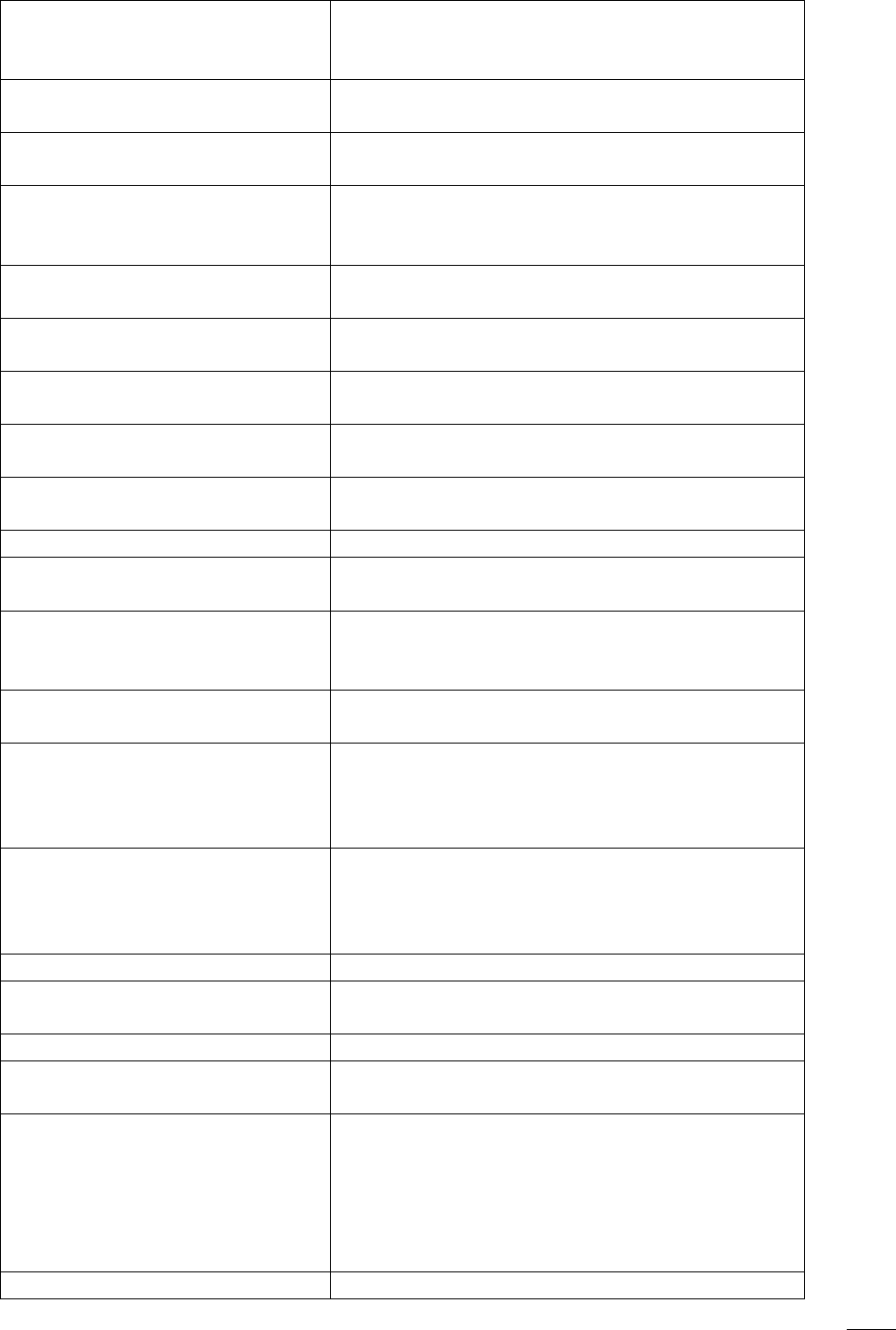
Screenpresso User Manual
Chapter
: Settings
85
DocumentMaximumImageSize
When generating a document, indicates whether the image
uses the full document width. When false, a margin is
added, and the image is centered.
DocumentOpenAfterGeneration
If True, the newly generated document is opened after
generation using the Windows’ default viewer.
EditorAlwaysMaximize
Force the built-in image editor window to be maximized by
default. In the case it uses the full screen.
EditorAutoAlignItems
If you add a drawing item using the image editor, when you
move it, a magnet applies. It tries to align the new item
when the other already existing ones.
EditorAutoSave
If True, the edited image is always saved in real time when
you modify it.
EditorDisableAutoCloseSettings
Indicating whether the drawable settings form can auto
close itself.
EditorSavePosition
If True, the image editor will remember its position and
restore it when re-opened.
EditorShowProperties
If True, the properties will always be visible when opening
the editor.
EditorSingleInstance
If True, only one editor can be opened at once. Opening a
new image will replace the currently opened edited image.
ExportPath
The latested folder where files have been exported.
FilePath
The full path of the settings.xml containing all settings used
by Screenpresso.
HideAndroid
If True, the Android Center is hidden. Use it if you plan to
never capture screenshots or video on an Android device
using Screenpresso and a USB cable.
KeyInterceptorRpcServer
You may try setting this setting to False if you are
experimenting issues with the ‘Print Screen’ key shortcut.
PasteSupportsDib
Sets a value indicating whether Screenpresso supports DIB
in clipboard. Under Windows 10, disabling DIB allows to
paste image without transparency. Maybe because of a
bug, Windows 10 always copy windows transparent.
PreviewDrawableDefaultItems
In the built-in image editor, clicking a drawable item (e.g.,
the rectangle tool) displaies a preview of the available
templates. If False, the templates are shown without a
preview of what they look like.
PrintMargins
The print margins.
MediaPlayerAutoPlay
If False, the built-in media player will not automatically play
the file when it is opened.
UseRecycleBin
If False, Screenpresso won’t moves a delete file to the
recycle bin anymore.
WorkspaceCloseOnCapture
When True, the window automatically closes when the user
wants to take a new screenshot. Set it to False if you want
to capture Screenpresso itself (note: to capture one
window of Screenpresso, you may select the window, press
ALT+PrintScreen shortcut to copy it, then press CTRL+V in
Screenpresso workspace to paste the copied image.
WorkspaceFadeDelay
Number of seconds before the workspace automatically
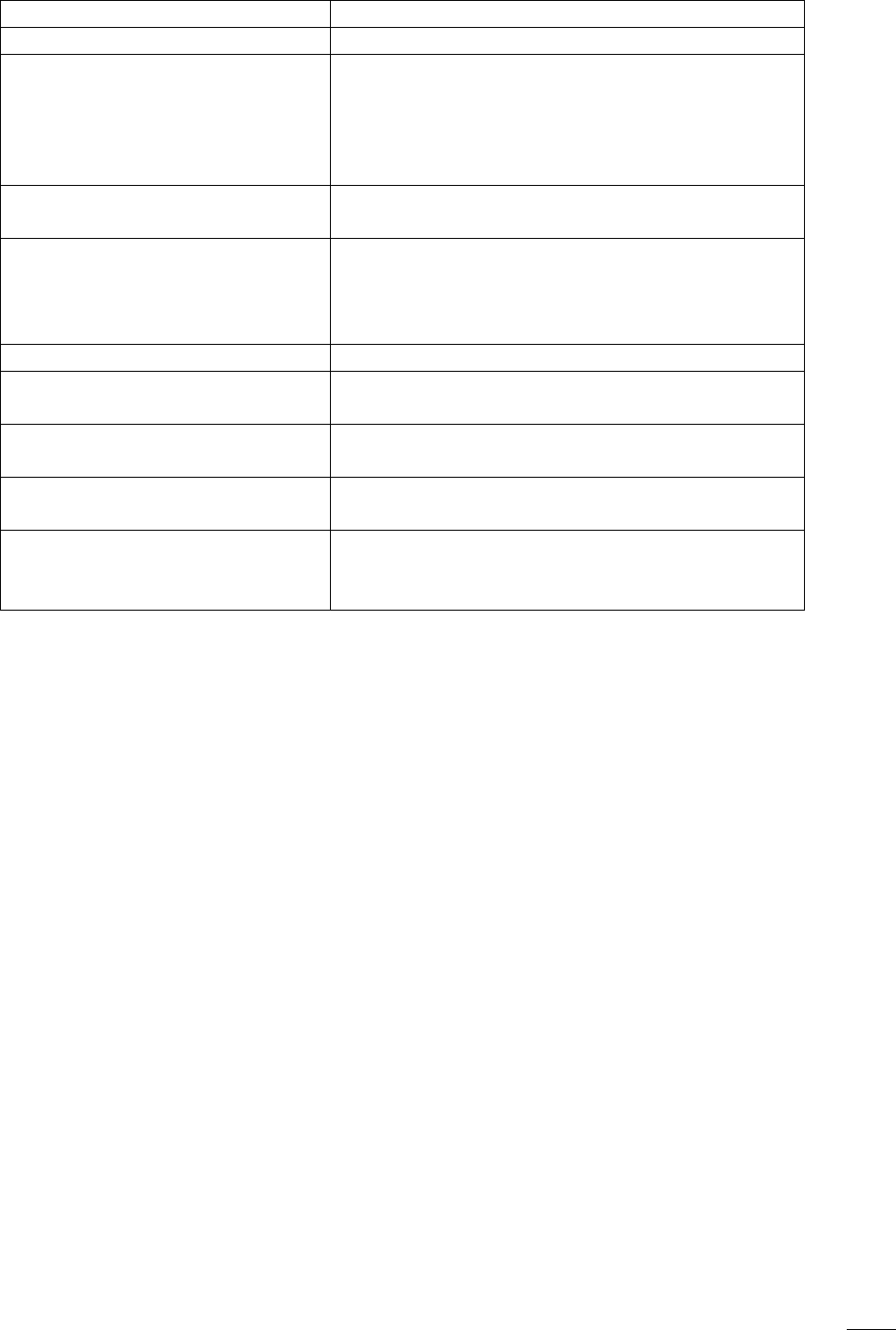
Screenpresso User Manual
Chapter
: Settings
86
closes itself. Set it to 9999 to avoid it to close automatically.
WorkspaceLocation
X and Y screen coordinates of the window.
WorkSpaceNewDragAndDrop
When you drag a file from the workspace, the standard
mouse is displayed. If you enabled this feature, then a
thumbnail of the dragged image is displayed. It is set by
default to false because actually it causes an issue when
dragging over Google Chrome.
WorkspaceReverseDisplayOrder
Display screenshots from newest to oldest order instead of
oldest to newest.
WorkspaceSaveLocation
By default, the workspace always opens at the same
location on screen. If this setting is set to True and you
move workspace window’s position, the position is restored
when you re-open it.
WorkspaceSize
Width and height of the window.
WorkspaceThumbnailDrawReflection
False to remove the reflection effect of all thumbnails
displayed in the workspace.
WorkspaceThumbnailSize
Width and height of the thumbnails displayed in the
workspace.
WorkspaceWorkspacesDistance
Width of the panel displaying the workspaces in
Screenpresso’s workspace window.
WorkspaceWorkspacesHorizontal
Workspaces are displayed to the left of the workspace
window by default. When this setting it true, they are
displayed on top of the window.
